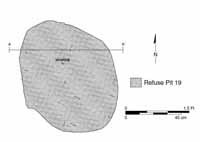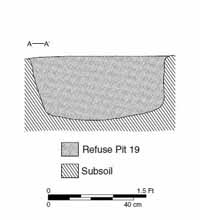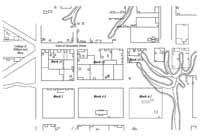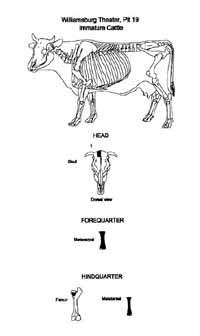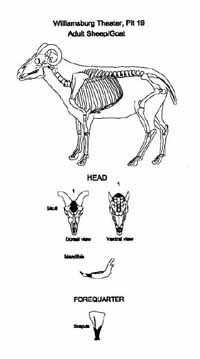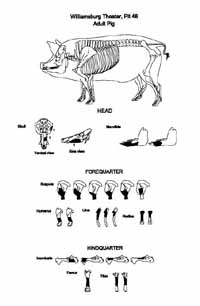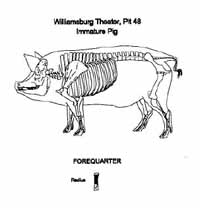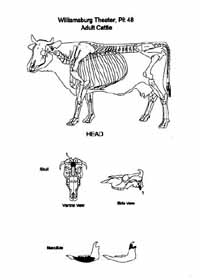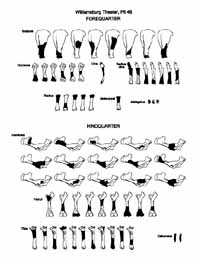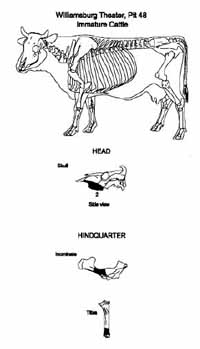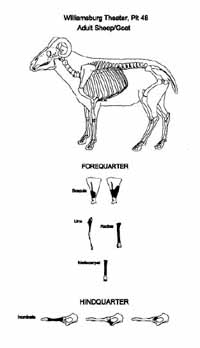Archaeological Excavation of the Williamsburg Movie Theater Site, Williamsburg, Virginia
Colonial Williamsburg Foundation Library Research Report Series - 1662
Colonial Williamsburg Foundation Library
Williamsburg, Virginia
2009
Archaeological Excavation of the Williamsburg Movie Theater Site, Williamsburg, Virginia
The Colonial Williamsburg Foundation
Department of Archaeological Research
P.O. Box 1776
Williamsburg, VA 23187-1776
(757) 220-7330
Jameson M. Harwood
Project Archaeologist
Marley R. Brown III
Principal Investigator
May 2001
| Page | |
| List of Figures | iii |
| Management Summary | v |
| Acknowledgments | vii |
| Chapter 1. Background | 1 |
| Introduction | 1 |
| Physical Setting | 1 |
| Historical Background | 1 |
| Previous Archaeology | 7 |
| Chapter 2. Research Design/Methods | 11 |
| Research Goals | 11 |
| Field Methods | 11 |
| Laboratory Methods | 15 |
| Chapter 3. Archaeological Results | 17 |
| 2000 Phase II Assessment | 17 |
| 2000 Phase III Assessment, Nineteenth-Twentieth Century Occupation | 17 |
| Eighteenth-Century Occupation | 29 |
| Chapter 4. Conclusions and Interpretations | 35 |
| Eighteenth-Century Butchery on Block 15 | 35 |
| Nineteenth-Century Butchery on Block 15 | 40 |
| Butchery Waste Disposal Patterns on Block 15 | 40 |
| Block 15 and Landscape Identity in Williamsburg | 41 |
| Rural/Urban Networks and Block 15 | 44 |
| Bibliography | 47 |
| Appendix A. Analysis of Faunal Remains, by Carrie B. Alblinger and Joanne Bowen | 51 |
| Appendix B. Context List | 81 |
| Appendix C. Artifact Inventory | 87 |
| Page | |
| 1. General location of project area | 2 |
| 2. Close-up of project area | 2 |
| 3. Colonial lots on Block 15 | 3 |
| 4. The Frenchman's Map of 1782 | 4 |
| 5. Map of excavated sites on Block 15 | 8 |
| 6. Map of Firehouse site | 8 |
| 7. Comparison of structures on Frenchman's Map and 1961 excavation | 10 |
| 8. Plan view of Phase II project area | 12 |
| 9. Plan view of Phase III project area, Stage I sampling | 13 |
| 10. Stratigraphic profile of west wall of site | 14 |
| 11. Plan view of Phase III project area, Stage II excavation | 14 |
| 12. Plan view of nineteenth-century foundation | 19 |
| 13. Photograph of nineteenth-century foundation | 19 |
| 14. 1904 Sanborn Fire Insurance map | 20 |
| 15. 1933 Sanborn Fire Insurance map | 20 |
| 16. 1924 aerial photo of Block 15 | 21 |
| 17. Profile of nineteenth-century foundation | 22 |
| 18. Profile of builder's trench | 22 |
| 19. Plan view of Refuse Pit 19 | 23 |
| 20. Profile of Refuse Pit 19 | 23 |
| 21. Plan view of Refuse Pit 48 | 23 |
| 22. Profile of Refuse Pit 48 | 23 |
| 23. Plan view of Refuse Pit 163 | 24 |
| 24. Profile of Refuse Pit 163 | 24 |
| 25. In-progress excavation of Refuse Pit 48 | 24 |
| 26. Plan view of Posthole 27 | 26 |
| 27. Profile of Posthole 27 | 26 |
| 28. Plan view of Posthole 165 | 27 |
| 29. Profile of Posthole 165 | 27 |
| 30. Plan view of Posthole 210 | 30 |
| 31. Profile of Posthole 210 | 30 |
| 32. Plan view of Pit 128 | 31 |
| 33. Profile view of Pit 128 | 31 |
| 34. Plan view of Linear Trench 126 | 33 |
| 35. Profile of Linear Trench 126 | 33 |
| 36. Map showing relationship between Hanson residence and Block 15 | 37 |
| 37. Map of Block 4 with Jones (Hanson) house and Public Hospital of 1773 | 37 |
| 38. Frenchman's Map identifying Cole's Property on Lot O | 38 |
| 39. Photograph of eighteenth-century butcher's cleaver from 1961 Post Office excavation | 39 |
| iv | |
| 40. Town plan of Williamsburg | 42 |
| 41. Frenchman's Map of Block 4, 5, and 15 | 44 |
Management Summary
Between April and July, 2000, the Colonial Williamsburg's Foundation Department of Archaeological Research (DAR) conducted a Phase II assessment and Phase III archaeological data recovery within an approximately 231-square-meter portion of the parking lot directly south of the present-day Williamsburg Movie Theater (Building 32-A). Phase III excavations were designed to recover significant archaeological information previously identified during initial Phase II testing. The site boundary conformed to the area scheduled to be disturbed by the construction of an addition to the stage area of the theater.
The Phase II assessment consisted of the stratigraphic hand excavation of five one-by-one-meter test units. The investigation resulted in the identification of intact soil stratigraphy consisting of soil layers with artifacts dating to the late eighteenth and early nineteenth century within four of the five test units. Due to the fact that any expansion of the Williamsburg Movie Theater would destroy possibly significant archaeological deposits relating to the historical occupation of Block 15, the Phase III excavation of all impacted areas was recommended.
The Phase III assessment of the Williamsburg Movie Theater site was performed in two stages. The first involved the machine removal of the concrete parking lot slabs and associated fill from within the site area in preparation for the stratigraphic hand excavation of twenty-four 1 × 1 meter units, representing a 25% sample of the intact portions of the site not disturbed by modern utility features. After the sampling was complete, the second stage involved the machine stripping of all remaining soil in order to expose any features at or near subsoil. All exposed features were examined and those determined not to be modern were excavated.
The Phase III fieldwork resulted in the identification of an early nineteenth- century domestic site occupied into the early twentieth century. Excavations uncovered the majority (32 feet by 14 feet) of an intact brick foundation with a TPQ of 1820 based on artifacts obtained from the builder's trench. The analysis of early twentieth-century Sanborn Fire Insurance maps provided the full dimensions of the house (32 feet by 16 feet), revealing that only two feet of the foundation continued south below the parking lot and beyond the limits of the site.
Associated with the nineteenth-century structure were two possible outbuildings and three refuse pits which date from the early to mid-nineteenth century. Although all three pits were nearly identical in appearance, two were completely filled with animal bone displaying evidence of both cleaving and sawing. However, in the third pit the animal bone was notably absent. The evidence of butchery at the Williamsburg Movie Theater site is significant due to the fact that only two other sites associated with butchers or butchering activities (the Post Office site [1961] and the Firehouse site [1983]) have been excavated in Colonial Williamsburg. Both are situated on the southern portion of Block 15. The Firehouse site exhibited faunal assemblages indicative of eighteenth-century butchering activities. While no butchering remains were found at the Post Office site, documents confirm that the property was once home to a Williamsburg butcher. When the nineteenth-century faunal remains are examined in light of the eighteenth-century occupation what vi emerges is a continual use pattern of Block 15 as a location for butchers to conduct their trade in the city of Williamsburg.
Due to its distance from the historically more urban east end of Williamsburg, Block 15 may have remained less developed in the eighteenth and early nineteenth century than the eastern half of town. While some settlement occurred on the northern portion of the block, most of the southern portion remained unoccupied.
The sparse development of Block 15 allowed the property to function as part of an urban to rural transition zone between local merchants and the surrounding plantations. This location was therefore well-suited to local butchers who served as procurement system intermediaries between the rural producers of livestock and the urban consumers of meat. As urban households tended to rely more upon a market system for their food source, a go-between was required to convert the farmer's livestock into a useable product. Butchers fulfilled the role as middleman by supplying both sides with a valuable service. Block 15 provided butchers with an area to ply their trade, allowing urban access to the flow of livestock from local farms, and yet was far enough from the eastern business district of Williamsburg not to disturb urban sensibilities with the particulars of the slaughtering process.
Acknowledgments
Although I am responsible for the content of this report, the success of the project was largely due to the work of others. The entire project was conducted under the general supervision of Marley R. Brown III, Director of the Department of Archaeological Research at the Colonial Williamsburg Foundation. Staff Archaeologist David Muraca oversaw the direct supervision of the project and provided support and enlightenment throughout the various stages of research. Zooarchaeologists Joanne Bowen and Steve Atkins provided the detailed analysis of all faunal remains. Project Archaeologist Mark Kostro supervised the Phase II investigation of the site area. Artifacts were inventoried and analyzed by Isabel Jenkins and William E. Pittman. Heather Harvey created the graphics and Greg Brown edited and formatted the final report. Last but most surely not least, a special thanks to those brave souls who helped make this excavation such an enjoyable undertaking. The dedicated field crew consisted of Melanie Cooper, Hank Lutton, Kiera McReynolds, Stacey Mullins, Paul Nasca, Ryan Remis, Lily Richards, and Katy Thomason.
Chapter 1.
Background
Introduction
Between April and July, 2000, the Colonial Williamsburg Foundation's Department of Archaeological Research (D.A.R.) conducted a Phase II assessment and Phase III archaeological data recovery within an approximately 231-square-meter portion of the parking lot located directly south of the present-day Williamsburg Movie Theater (Building 32-A). The Phase III excavations were designed to recover significant archaeological information previously identified during initial Phase II testing conducted in April 2000. The site boundary conformed to the area scheduled to be disturbed by the construction of an addition to the stage area of the theater.
Physical Setting
The project area lies within a parking facility located directly behind the Williamsburg Movie Theater. Both the theater and the parking lot are situated within "Block 15," which lies on the south side of Duke of Gloucester Street, between South Boundary Street to the west and Henry Street to the east. The entire block, currently owned by the Colonial Williamsburg Foundation, is part of "Merchants Square" and is occupied by shops and restaurants catering to visitors to the Historic Area. The project area appears to be situated primarily within colonial lot 361. Portions of the project area may also extend east and west into the adjacent colonial lots 360 and 62 (Figures 1 and 2).
Historical Background
Lots 360, 361, 62, 63
Tracing the historical development and ownership of the lots within Block 15 is hampered by the destruction of the James City County records during the Civil War. No county property records of the area exist for the period before the war (Figure 3). As a result, the historical background of the lots from the seventeenth through the mid-nineteenth century is highly fragmented and largely drawn from secondary sources. The first known mention of any of the lots (360, 361, 62) is on January 12 and 13, 1720, when the Trustees of Williamsburg granted Lots 360 and 361, along with ten other lots (313-318, 34, 41, 42, and 339) to Thomas Jones for £9 (York County Records, DAB 3: 322-323). John Blair contested the grant because it included four lots (Lots 34, 41, 42, and 339) that had been granted to Blair six days earlier. On January 18, 1720 the court recognized the claim of Blair to the four lots but Jones retained the other eight lots (Lots 313-318, 360 and 361) (York County Records, Orders, Wills 15: 535).
After 1720 the records relating to the ownership of the lots become unclear. Thomas Jones mentions his "college lots" in the 1750s, possibly referring to Lots 360 and 361,
2
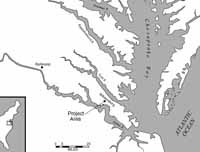 Figure 1. General location of project area.
Figure 1. General location of project area.
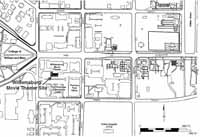 Figure 2. Close-up of project area.
3
Figure 2. Close-up of project area.
3
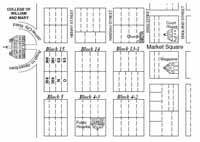 Figure 3. Colonial lots on Block 15.
which were separated from property belonging to the College of William & Mary by Boundary Street. However, in 1731 the will of Richard Hickman bequeathed to Christopher Jackson "one house and the Lot or Lotts thereto situate in Williamsburgh on the South side of Duke of Gloucester Street and joining to the College Lands" (Jones Papers, Reel 2, Frame 705; York County Records, Deeds, Orders, Wills 17:187). The description from the will of Richard Hickman appears to also describe Lots 360 and 361, possibly indicating that Thomas Jones may have forfeited Lots 360 and 361 prior to 1731.
Figure 3. Colonial lots on Block 15.
which were separated from property belonging to the College of William & Mary by Boundary Street. However, in 1731 the will of Richard Hickman bequeathed to Christopher Jackson "one house and the Lot or Lotts thereto situate in Williamsburgh on the South side of Duke of Gloucester Street and joining to the College Lands" (Jones Papers, Reel 2, Frame 705; York County Records, Deeds, Orders, Wills 17:187). The description from the will of Richard Hickman appears to also describe Lots 360 and 361, possibly indicating that Thomas Jones may have forfeited Lots 360 and 361 prior to 1731.
No additional documentary references regarding the ownership of the lots for the eighteenth century has thus far been identified. Inspection of eighteenth-century maps of Williamsburg does provide additional clues to the early development of the block. The Frenchman's Map (1782) shows six buildings were located within the block along Duke of Gloucester Street (Figure 4). The map further indicates that the structure located within Lot 361 had at least three outbuildings south of the house on Duke of Gloucester Street. In a brief discussion of the buildings in a memo dated November 17, 1950, Mary Goodwin (1950) speculates that because most of the businesses in Williamsburg were originally located at the east end of town near the Capitol, the buildings within Block 15 were most likely residential. These residential structures were possibly occupied by members of the College staff due to the close proximity of the lot to the campus. Other eighteenth-century maps of Williamsburg by Nicolas Desandrouins (1781) and Alexander Bertier (1781) further corroborate the development of Block 15, but in much less detail than the Frenchman's Map. These maps simply indicate that structures did exist on the property but do not provide any specifics on the size, shape, or location of the structures within Block 15.
Ware Property
The archaeological investigation took place in the vicinity of Colonial Lots 360 and 361 on the property referred to herein as the Ware property. No nineteenth-century records exist
4
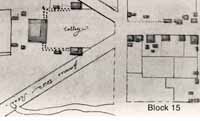 Figure 4. Detail of the Frenchman's Map of 1782.
for the property prior to 1865 due the destruction of the county records during the Civil War. Personal accounts provide some evidence of the property being titled to Letitia Ware during the last quarter of the nineteenth century. An early twentieth-century description of Block 15 by John S. Charles (1932) recalls the location and types of structures on the Ware property and other properties in the vicinity of Lots 360, 361, and 62 around the time of the Civil War:
Figure 4. Detail of the Frenchman's Map of 1782.
for the property prior to 1865 due the destruction of the county records during the Civil War. Personal accounts provide some evidence of the property being titled to Letitia Ware during the last quarter of the nineteenth century. An early twentieth-century description of Block 15 by John S. Charles (1932) recalls the location and types of structures on the Ware property and other properties in the vicinity of Lots 360, 361, and 62 around the time of the Civil War:
…near the middle of the block there stood, up to about the beginning of this century, a very old house known to the writer as the "Ware House." This very old frame structure was a one-and-a-half story building with deep cellar and large shed on the back. It rested on abrick wall about four feet high, with a porch in front…. This old structure, with dormer windows and a high porch, stood in the middle of a spacious yard in which were shade trees and a single story wooded building used as a kitchen. This yard is now the site of the Imperial Theatre [present-day Williamsburg Theater] and several other business places in a row. Immediately to the east of the present College Shop, was a small two story frame house which was removed a few years ago. This unpretentious old house was erected long before the Civil War, but it held its original appearance, with little or no repairs, longer than any house of similar construction within the writer's experience. Save for showing a lack of… whitewash it presented practically the same appearance when pulled down a few years ago as it did when the great Union Army passed its door in 1862 (Goodwin 1950).After the death of Letitia Ware sometime between 1875 and 1877, the property was conveyed to Mary Warburton at public auction on November 12, 1877 (Williamsburg Deed Book 1:475). Mary Warburton owned the property until she sold it to W.H. (or H.W.) Sweeney on April 16, 1897 (Williamsburg Deed Book 3:146). The property exchanged ownership several times until purchased by the Peninsula Realty Corporation on April 26, 1916 (Williamsburg Deed Book 7:314). The Peninsula Corp divided the property in two, initially selling the eastern forty-five feet of the lot on September 12, 1919 and 5 finally the western forty-nine feet of the lot on December 20, 1919, both to T.A. Lacy (Williamsburg Deed Book 8:357, 425). Lacy owned both sections until he conveyed the western lot to Angelo and Nick Costas on January 12, 1922 and the eastern lot to George Rollo on July 15, 1922 (Williamsburg Deed Book 8:367-8). George Rollo and his wife Emily Rollo subsequently built Williamsburg's first movie house, known as the Imperial Theater. On January 5, 1925 the Rollos conveyed to Angelo Costas and George Stath an undivided one-half right, title, and interest to the theater lot together with all "the buildings and improvements, furniture and business known as the Imperial Theater" (Williamsburg Deed Book 10:399) . The partnership continued for three years until they sold the theater lot to W.A.R. Goodwin on January 14, 1928 (Williamsburg Deed Book 12:274). Angelo and Nick Costas owned the western half of the property until they conveyed the land to W.A.R. Goodwin on January 14, 1928 (Williamsburg Deed Book 12:274). It was on both sections of the property that the present-day Williamsburg Movie Theater and parking lot was constructed in 1930.
Cowles Property
Directly east of the Ware property is the lot herein referred to as the Cowles property. On November 24, 1866 the property was conveyed to William T. Cowles by general warranty deed (Williamsburg Deed Book 1:59). An 1880 lawsuit forced Cowles to sell the lot to satisfy the judgment and a special deed commissioner sold the property to Jeanette Cowles on January 24, 1891 (Williamsburg Deed Book 2:365). Mrs. Cowles owned the land until January 10, 1928, when she conveyed the property to W.A.R. Goodwin (Williamsburg Deed Book 12).
Lots 358 and 359
Late eighteenth- and nineteenth-century maps show no structures standing on colonial lots 358 and 359. Post-Civil War maps and city records were used to trace boundary lines and property ownership through the latter half of the nineteenth century, continuing up until the present day. The Frenchman's Map (1782) shows structures bordering South Henry Street on Block 15, but ownership has not been ascertained for them.
Aided by information from an interview with Mrs. B.B. Henderson (1984), property owners could be traced for the early years of the twentieth century. Mrs. Henderson's father, Henry Billups, owned the land referred to as the Thelma Brown property during the first part of the twentieth century. Examination of deeds revealed that Billups's property was bounded on the west by the Allard lot, which was subsequently bounded on the west by the property of Archer Brooks (WDB 2: 538). To the west of the Brooks property, located on the corner of Boundary and Francis Street, was the house referred to as the Frank Clark property.
Thelma Brown Property
In 1840, Somerset Moore granted interest in the property to William S. Peachy as a moiety in trust to secure a payment of $140 to John Gregory (Williamsburg Deed Book 2: 284). The property exchanged hands several times until Henrietta and Henry Billups purchased 6 the property in March 1892. Billups sold the property in April 1913, and it went through several more owners until Martha Wysong and Louise Pollock conveyed the land to Thelma Brown with the condition that only residential buildings be put on the lot, with no manufactory, trade, or business of calling enterprises until after January 1, 1949 (Williamsburg Deed Book 10: 341-342). Brown conveyed the property to W.A.R. Goodwin in November 1927, who in turn conveyed the land to the Williamsburg Holding Corporation on July 1, 1928. In December 1932, Building 1A, an outbuilding, was demolished and the debris was removed from the property (memo, archives file). In June, 1946, the Brown House was converted into two apartments which were rented by Mr. and Mrs. Warfield Winn (Archives Property File, Thelma Brown House, Block 15, No.1).
Allard Property (Colonial Lot 359)
The earliest mention of the Allard property was found in a deed dated July 22, 1867 in which Turner Capps purchased what was later to become the Allard property from Wilson Durfey in May 1856 (Williamsburg Deed Book 1: 95). The property exchanged hands several times until it was seized on September 4, 1893, by the heirs of Charles Allard (Williamsburg Deed Book 2: 502). The property changed ownership two more times until W.A.R. Goodwin conveyed the land to the Williamsburg Holding Corporation on January 27, 1928 (Williamsburg Deed Book 13: 377-78).
From information at the Colonial Williamsburg Archives, it appears the Allard House (Block 15, Building 2) had been standing for some time prior to the twentieth century. An aerial photograph from 1924 shows a single dwelling on the Allard property. The Allard House was a two-story dwelling with a one-story addition off the north side. Although it was considered "colonial" by the Restoration architects (Chorley 1932), the house was not depicted on either the Frenchman's Map or the Rochambeau Map. According to a memo dated March 30, 1931, the house had been unoccupied "for quite some time" (Todd and Brown 1931) and was in poor condition. Despite this fact, the Allard House, along with the Clark House on the corner of Francis and Boundary Streets, were being considered for restoration during 1932/33. However, on December 13, 1933, the decision was made to destroy the Allard House and use the site as the location for Person's Garage (Allard 1933). By December 28, 1933, the Allard House had been completely destroyed. The construction of the garage also occasioned the removal of trees which formed the boundary between the Allard and the Brown properties (Photograph File - N4543). In 1939, Person expanded his business by building a service center to the east of his garage, involving the excavation of a subterranean pit for servicing cars. Sometime after 1955, the service center and the garage were joined to form one large L-shaped building. Person continued to occupy the building until around 1958 when it served to house the Williamsburg/James City County fire department. The firehouse was vacated sometime in the 1970s and demolished in April 1983.
Brooks Property (Colonial Lots 358/359)
The Brooks property, located near the corner of Boundary and Francis Street, was sold by Montague and B.H. Brooks to the Williamsburg Holding Corporation on November 29, 1933. On December 12, 1933, the Williamsburg Holding Corporation sold and conveyed 7 the Brooks House and the Allard House to S.W. Brown, of the Eastern State Hospital, on the express condition that the purchaser would remove the structures within seven days (Archives, Block 15, No. 3, Brooks File). By December 28, 1933, the Brooks home was wrecked and removed (memo, Archives File).
In an aerial photograph taken in 1924, two structures are shown on the Brooks property.
The Brooks House stood on the current site of Berret's Seafood Restaurant and can be seen on the Sanborn Fire Insurance Map (1929) as a two-story frame structure with two later additions. A large shed and a possible privy can be seen in the backyard to the north of the house. All three buildings were demolished for the construction of Person's Garage.
Frank Clark Property
A 1908 plat map shows the property at the corner of Boundary and Francis streets belonging to Archer Brooks (Williamsburg Plat Book 2:10). It is not known when this two-story frame building was constructed, but the house stood vacant as early as June 1929 and was considered for restoration in the early 1930s (Chorley 1932). In 1930, some persons illegally occupied the house, cooking their meals on an open fire in the back (Brooks 1930). On May 8, 1934, Williamsburg Restoration, Inc. sold the house to Mrs. Frank Clark for demolition, which was carried out in July 1934 (Archives n.d.).
Lot N and Lot O
Documentary evidence for both Lot N and Lot O is exceedingly sparse. Pictorial evidence for early occupation of the lots is provided by the Frenchman's Map (1782), which places five buildings on Lot O and none on Lot N. Tax records show that in 1785, William Cole, a butcher by trade, received Lot O from Samuel Crawley (Williamsburg Tax Records 1785). In 1810, William Bowden subsequently received the same lot from the estate of William Cole (Williamsburg Tax Records 1810).
Previous Archaeology
The Old Firehouse Site (Block 15 Area C)
On April 12, 1983, an eighteenth-century refuse deposit was revealed during the demolition of the old Firehouse, prompting archaeological salvage work by Colonial Williamsburg's Office of Excavation and Conservation (now the Department of Archaeological Research) (Samford 1990). Subsequent excavation from April 12 to 14 exposed a large deposit of secondary refuse dating to the mid-eighteenth century (Figures 5 and 6). An analysis of the refuse revealed evidence of a butchering site which is believed to be the first excavated in Williamsburg. The disproportionate amount of sheep jaws, skulls, and cow hooves recovered from the deposit sparked a detailed analysis of the faunal assemblage (Bowen 1990). The site contained 4,749 bone fragments, of which 4,072 came from a single tightly-dated context (15C-41). Documentation indicates the faunal remains may be associated with Benjamin Hanson, a free mulatto butcher who conducted his trade from ca. 1736 until his
8
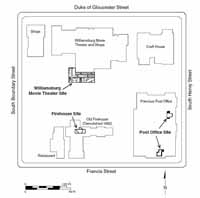 Figure 5. Map of excavated sites on Block 15.
Figure 5. Map of excavated sites on Block 15.
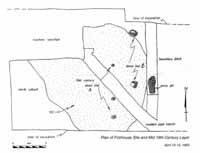 Figure 6. Map of Firehouse site.
9
death in 1753/4. Additionally, the salvage operation uncovered several fence lines, a boundary ditch, and a modern privy pit.
Figure 6. Map of Firehouse site.
9
death in 1753/4. Additionally, the salvage operation uncovered several fence lines, a boundary ditch, and a modern privy pit.
The Post Office Site (Block 15 Areas A and B)
In 1961, archaeological excavation was undertaken on the southeastern portion of Block 15 (Lot N and Lot O) by the Colonial Williamsburg Foundation, under the direction of Ivor Noël Hume. Work was begun in April, precipitated by the impending construction of the Williamsburg Post Office. Since the Frenchman's Map (1782) depicted several structures in the area, it was determined that an archaeological reconnaissance of the property should be conducted (Noël Hume 1961, 1970) (Figure 7).
Testing revealed the remnants of four buildings and various associated features corresponding with map evidence of eighteenth-century development of the area. Two cellars were excavated revealing a fill date of 1750-1765 and 1817, respectively. The first cellar was an unlined feature somewhat S-shaped in plan with brick bulkhead steps to the northeast. The cellar feature was unique in that it contained no fewer than 1109 broken wine bottles, with 984 coming from one fill layer. The second cellar was partially excavated and from it were recovered large quantities of ceramic, glass, and iron artifacts. Of special note were a 1773 Virginia halfpenny and two United States pennies from 1816 and 1817.
Two wells were exposed, one of which was excavated, providing a construction date of the first quarter of the eighteenth century and an abandonment date of 1730. The shaft extended to a depth of twenty-three feet ten inches below the modern grade, and was lined with well-fired radial bricks. Although it was not possible to associate the well with any of the structures on the site, the discovery of crucibles and industrial slag in both the early cellar and the excavated well suggested the presence of a metalworker on the site.
Two significant refuse pits were revealed, both of which dated to the eighteenth century. The first pit (E.R. 410) was tightly packed with coal ash, oyster shells, animal bones, and artifacts dating to the first quarter of the eighteenth- century. The second pit (E.R. 411) dated after 1769 based on the presence of creamware and included the unique find of a well-preserved butcher's cleaver. The latter find is significant given that the property was owned by William Cole, a butcher, from 1785 to 1810.
10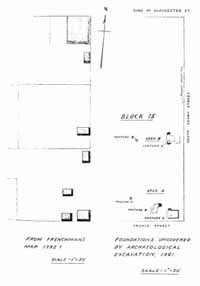 Figure 7. Comparison of structures on Frenchman's Map and 1961 excavation.
Figure 7. Comparison of structures on Frenchman's Map and 1961 excavation.
Chapter 2.
Research Design/Methods
Research Goals
2000 Phase II Assessment
The Phase II assessment of the area was requested by Scott Spence, Project Manager for the renovation of the Williamsburg Theater, in advance of the construction of an addition to the south of the theater. As any construction activity would heavily disturb the archaeological record in this area, an examination was designed in order to test for the presence or absence of any intact archaeological layers and features under the parking lot to the rear of the theater.
2000 Phase III Data Recovery
The research design for this Phase III investigation was based on findings from the April Phase II survey. All fieldwork was to take place within a six-week period of time, at which point the theater expansion was scheduled to begin. Given the relatively short period of time set aside for Phase III examination of the site, and the range of goals to be accomplished, an excavation strategy was formulated to work with these constraints in mind. The first objective was to quickly expose all intact stratigraphic soil layers and features over the entire site area. Once exposed, the second objective was to formulate a strategy which would provide the most efficient and effective means of testing the entire site.
Field Methods
2000 Phase II Assessment
The Phase II assessment consisted of five one-by-one-meter test units within the parking lot south of the Williamsburg Theater (Figure 8). Test Units 1-4 were placed 2.8 meters south of the rear of the theater building. Test Units 1, 2, and 3 were spaced 3.5 meters apart, while the interval between Test Units 3 and 4 was increased to 5 meters. Test Unit 5 was located 1.2 meters west of the theater building and 2.7 meters north of the southwest corner of the building.
Prior to the arrival of the archaeological field crew, portions of the parking lot pavement and the concrete sidewalk were removed at the planned test unit locations. After the pavement and sidewalk had been removed, archaeologists excavated each test unit stratigraphically by shovel and trowel. Each stratigraphic unit was assigned a context number and detailed a description of each soil layer was recorded, including soil thickness, type and color. All excavated soils were passed through ¼-inch mesh screens and any artifacts recovered were retained for analysis at the Department of Archaeological Research Laboratory. At the lab, the artifacts were washed, identified, and inventoried. All of
12
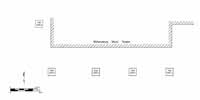 Figure 8. Plan view of Phase II testing area.
the documentation and artifacts are stored at the Colonial Williamsburg Foundation's Department of Archaeological Research Lab.
Figure 8. Plan view of Phase II testing area.
the documentation and artifacts are stored at the Colonial Williamsburg Foundation's Department of Archaeological Research Lab.
2000 Phase III Data Recovery
The impacted area consisted of a predetermined 231-square-meter portion of parking lot located along the south and western sides of the Williamsburg Movie Theater (Figure 9). The excavation of the site was performed in two stages. The first stage involved the use of a backhoe to remove the concrete parking lot slabs and associated fill from within site area in order to expedite the excavation of this modern layer. Once the modern parking lot fill was removed, a grid was established and a series of one-by-one-meter units were laid out over the entire site area.
The town grid established for the City of Williamsburg was used for the project. All units were assigned temporary coordinates for their northwest corner with respect to the original datum point, 500/500, located in the southwest corner of the site. The site area was then shovel-skimmed and all intact layers and features were mapped on a site plan. All modern utility features were also included on the site map and these areas were eliminated from the excavation strategy. Based on the site plan, it was determined that a total of ninety-eight 1×1 meter units could be considered intact, meaning they were not disturbed by any modern features. It was determined that a 25% sample would be adequate to interpret these layers and therefore a total of twenty-four test units were ultimately placed across the intact areas of the site (see Figure 9). Units were originally placed throughout the site at the discretion of the project archaeologist and those that uncovered the presence of cultural remains were expanded as necessary. All units were excavated using shovels and hand trowels. In each unit any remaining parking lot fill was simply shoveled off and not screened. Once the disturbed soil was removed all intact soil layers were excavated following the natural stratigraphy and each layer was separately sifted through a
13
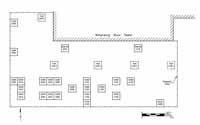 Figure 9. Plan view of Phase III project area, Stage I sampling.
¼-inch hard wire mesh screen (Figure 10). Each layer was assigned an individual context number, and artifacts from each context were bagged accordingly. All units were excavated to a thin transitional layer just above subsoil in which intact features began to appear. This intact layer and its features were left to be investigated during the second stage of excavation in which the entire area would be exposed.
Figure 9. Plan view of Phase III project area, Stage I sampling.
¼-inch hard wire mesh screen (Figure 10). Each layer was assigned an individual context number, and artifacts from each context were bagged accordingly. All units were excavated to a thin transitional layer just above subsoil in which intact features began to appear. This intact layer and its features were left to be investigated during the second stage of excavation in which the entire area would be exposed.
Once all twenty-four sample units were excavated, the second stage of excavation involved the machine removal of all remaining soil in order to expose any features at or near subsoil. After the backhoe stripping was complete, the site was once again shovel-skimmed and all exposed features were mapped on a site plan map (Figure 11). All features were also individually plan mapped and those considered significant were photographed with both color slide and black and white film prior to excavation. All non-modern features were then excavated and profile mapped.
An Archaeological Context Record was entered into an on-site palmtop computer for each context (that is, each depositional unit). Information regarding the description of artifacts, soil particulars, and other cultural remains was included in each record. The information from the palmtop was downloaded into the database of the Department of Archaeological Research, Re:discovery. Typical stratigraphic profiles were recorded for each excavation area. Elevations were taken throughout the site using a Nikon EDM.
Each archaeological context was assigned a unique number, composed of the "site/area" designation assigned to the project (in this case, "15DB") and an arbitary context number. Thus, context 48 (the fill of a refuse pit) is correctly defined as "15DB-48." Artifact bags, samples, and all notes relating to this context are labelled with this number, distinguishing them from any other context in Colonial Williamsburg's archaeological collection.
14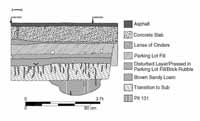 Figure 10. Stratigraphic profile of west wall of site.
Figure 10. Stratigraphic profile of west wall of site.
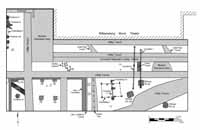 Figure 11. Plan view of Phase III project area, Stage II excavation.
Figure 11. Plan view of Phase III project area, Stage II excavation.
Later, related contexts were combined to form "master contexts," representing larger stratigraphic units (structures, fence lines, etc.). These master contexts are generally prefaced with an "M" (for example, master context "M11").
Laboratory Methods
All artifacts recovered during the excavation were sent to the archaeology lab at the DAR for processing and analysis. Artifacts were washed, identified, and inventoried by context. Each context was assigned a terminus post quem (TPQ) date when possible. The TPQ date establishes the earliest date at which an archaeological layer, feature, or artifact assemblage could have been deposited. This date is always based on the artifact with the most recent initial date of manufacture. Artifacts were inventoried by ware type with all important functional and morphological characteristics noted. All the documentation and artifacts recovered during the excavation are stored at the D.A.R. Laboratory.
Chapter 3.
Archaeological Results
The Phase II archaeological assessment of the Williamsburg Movie Theater encountered evidence of a late colonial-period occupation. Therefore, a large-scale salvage excavation was recommended in order to expose and document any existing archaeological remains which might provide insight into the historical occupation of Block 15. The subsequent Phase III investigation revealed only scant eighteenth- century remains, but the excavations successfully identified evidence of the historical use of Block 15 in the form of an early nineteenth to twentieth-century domestic site. This site is of particular importance due to the presence of an early nineteenth-century house foundation and two associated refuse pits containing large quantities of butchered animal bone.
2000 Phase II Assessment
The excavation of Test Units 1-4 revealed a relatively consistent stratigraphic sequence across the south length of the Williamsburg Theater under the parking lot. Situated directly under the parking lot fill was a 2-5 cm (1-2 in.) thick layer of dark brown silt loam. Artifacts for the layer included a variety of nineteenth and early twentieth-century glass, ceramics, and iron. Within Test Unit 4, a layer of compacted crushed sand mortar and brick was discovered under the dark brown silt loam, but this destruction debris was absent from all other units.
Under the dark brown silt loam in Test Units 1-3, and under the mortar and brick layer in Test Unit 4, was a layer of brown sandy silt loam. Although the layer was identified in each of the four test units behind the theater, it was only excavated within Test Unit 3. The depth of the layer was 22 cm (9 in.) and was deposited directly over subsoil. Artifacts from the layer consisted of primarily small fragments of late eighteenth and early nineteenth-century ceramics and nails, but small quantities of brick, glass, animal bone, and tobacco pipe stems were also recovered.
Test Unit 5 was unlike any of the other four units excavated as part of the Phase II testing. All the excavated soil was a mix of various modern fills and subsoil was identified at a depth of 44 cm (1.4 feet) below the sidewalk. Cutting through the fill was a modern utility trench which contained a modern (early twentieth-century) ceramic sewer line. A single small square feature was recorded in subsoil, along the east end of the test unit. The feature measured 10 cm (4 in.) in length and width and contained a dark brown silt loam. The feature was not excavated.
2000 Phase III Assessment
Nineteenth to Twentieth-Century Occupation
The majority of all archaeological evidence uncovered during the Phase III at the Williamsburg Movie Theater site was associated with the early nineteenth through early twentieth-century phase of occupation. Excavations exposed a house foundation with a 18 date of 1820 based on artifacts from the builder's trench. The brick foundation also incorporated six brick piers which served to support internal walls, four of which were revealed during the Phase III excavation. Associated with the house were three refuse pits, two possible outbuildings, an assortment of small garden features, two fence lines, and a linear trench.
House Foundation, Builder's Trench, Piers (Contexts 15DB-35, -80/81, -94, -96, -159, and -162)
The house foundation (15DB-35) was initially exposed during the machine removal of the modern parking lot fill and at first appeared to have poor integrity (Figures 12 and 13). The overlying layer contained parking lot debris and brick and degraded mortar from the destruction of the house. This layer measured between 5 and 12 cm (3-5 in.) thick depending on the amount left by the backhoe. Hand excavation of the foundation revealed it to be fragile but intact except for small disturbances to the north wall caused by modern utility trenches (15DB-11, -13, and -57). The exposed portion of the house foundation measured 32 feet (9.8 m) east-west by 14 feet (4.3 m) north-south and was located from 500-504 north to 500-510 east on the site grid. The structure is labeled as a dwelling on early twentieth-century Sanborn Fire Insurance maps (1904, 1921, and 1929) and the full dimensions of the house are approximately 32 feet by 16 feet (Figure 14). Therefore, only the southern wall and two feet of both the eastern and western walls appear to continue beneath the parking lot outside the project area. The Sanborn Maps also indicate the dwelling was originally two stories in height, roofed with shingles, and included a one story, shingle-roof porch which began at the southwest corner of the house and continued along the southern wall. The porch was not exposed during the Phase III excavation as it was also located outside the project area, but it appears to have measured approximately 10 feet (3.1 m) east-west by 5 feet (1.5 m) north-south. Initially the destruction of the house appeared to coincide with the construction of the Williamsburg Movie Theater in 1930 given the presence of the structure on the 1929 Sanborn Map and its absence on the 1933 map (Figure 15). However, examination of a 1924 aerial photograph produced no evidence of the house, a fact in direct conflict with the 1929 Sanborn Map (Figure 16). It appears that the Sanborn Company simply copied the location of the house from the 1921 map to the 1929 map without determining if the structure was still standing. Therefore, the destruction of the house possibly occurred between 1921 and 1924, but it is impossible to determine if the house still existed even in 1921 given the inconsistencies in the Sanborn maps.
The dwelling was initially identified has having been constructed sometime in the nineteenth century due to the presence of reused, non-machine made bricks bonded with sand mortar. The reuse of materials is evident due to the prevalence of irregular or broken bricks which contained a light, nonfunctional residue of shell mortar. Since the foundation did not utilize shell mortar in its construction, an eighteenth-century date was most likely ruled out. None of the bricks were machined or incorporated a cement mortar, thereby ruling out a twentieth-century construction date for the house. The fabrication of the dwelling was ultimately narrowed down to a nineteenth-century date based on the use of sand mortar.
19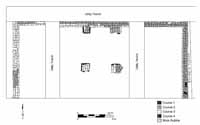 Figure 12. Plan view of nineteenth-century foundation.
Figure 12. Plan view of nineteenth-century foundation.
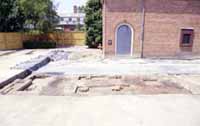 Figure 13. Photograph of nineteenth-century foundation.
Figure 13. Photograph of nineteenth-century foundation.
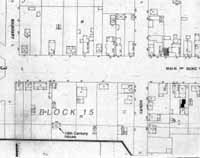 Figure 14. 1904 Sanborn Fire Insurance map.
Figure 14. 1904 Sanborn Fire Insurance map.
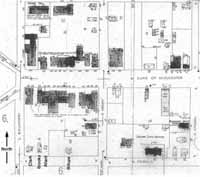 Figure 15. 1933 Sanborn Fire Insurance map.
Figure 15. 1933 Sanborn Fire Insurance map.
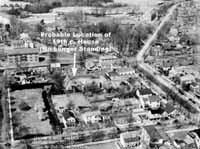 Figure 16. 1924 aerial photo of Block 15 (facing west).
Figure 16. 1924 aerial photo of Block 15 (facing west).
The exposed foundation was four courses deep, with the uppermost course (1) being represented by only a few remaining bricks along the top of the east foundation wall. Most of the foundation remnants consisted of vertical courses (2), (3), and (4) (Figure 17). The lower courses (3 and 4) were three courses in width, while course 2 was only two courses in width. This indicated that course 3 and 4 served as spreader courses and functioned to support the upper, two-course-wide foundation walls.
Excavations revealed a builder's trench (15DB-80/81) along the outer edge of the east foundation wall (see Figure 11). Units located along the west foundation wall encountered no builder's trench and any builder's trench for the north foundation wall was destroyed by a modern utility trench (15DB-13). The entire builder's trench was excavated. The exposed portion of builder's trench was approximately 15 cm (6 in.) in width and 4.27 meters (14 feet) in length, matching the exposed length of the east wall. Excavation of the feature revealed a flat bottom with sides that sloped to 7 cm (4 in.) in width (Figure 18). The builder's trench held few artifacts, consistent with the feature having been filled soon after it had been dug. Despite the low artifact count, a TPQ date of 1820 was established based on a fragment of whiteware. This date coincides with the original assessment that the house was erected sometime in the nineteenth century.
Also uncovered were four brick piers (15DB-94, -96, -159, and -162) which appear to have served as internal wall supports (see Figure 11). The eastern edge of the northeast pier (15DB-94) was situated at approximately 3.7 meters (12.1 feet) to the west of the outer edge of the east foundation wall. The northeast pier was incorporated into the north foundation wall and measured 60 cm (2 feet) in width east-west and extended
22
 Figure 17. Profile of nineteenth-century foundation.
Figure 17. Profile of nineteenth-century foundation.
 Figure 18. Profile of builder's trench.
35 cm (1.2 feet) south from the southern edge of the north wall. The western edge of the northwest pier (15DB-96) was situated at approximately 4 meters (13.1 feet) to the east of the outer edge of the west foundation wall. The northwest pier was also incorporated into the north foundation wall and measured 39 cm (1.25 feet) in width east-west and extended 33 cm (1.1 feet) south from the southern edge of the north wall. The northwest corner of the southeast pier (15DB-159) was located 4.1 meters (13.5 feet) to the west of the outer edge of the eastern wall and 2.1 m (6.9 feet) to the south of the southern edge of the north wall. The southeast pier measured 50 by 50 cm (1.7 by 1.7 feet). The northwest corner of the southwest pier (15DB-162) was located 3.8 meters (12.5 feet) to the east of the outer edge of the west wall and 2.1 meters (6.9 feet) to the south of the southern edge of the north wall.
Figure 18. Profile of builder's trench.
35 cm (1.2 feet) south from the southern edge of the north wall. The western edge of the northwest pier (15DB-96) was situated at approximately 4 meters (13.1 feet) to the east of the outer edge of the west foundation wall. The northwest pier was also incorporated into the north foundation wall and measured 39 cm (1.25 feet) in width east-west and extended 33 cm (1.1 feet) south from the southern edge of the north wall. The northwest corner of the southeast pier (15DB-159) was located 4.1 meters (13.5 feet) to the west of the outer edge of the eastern wall and 2.1 m (6.9 feet) to the south of the southern edge of the north wall. The southeast pier measured 50 by 50 cm (1.7 by 1.7 feet). The northwest corner of the southwest pier (15DB-162) was located 3.8 meters (12.5 feet) to the east of the outer edge of the west wall and 2.1 meters (6.9 feet) to the south of the southern edge of the north wall.
All four piers utilized a sand mortar. Most of the bricks from all four piers were irregularly shaped and contained bits of shell mortar suggesting a reuse pattern similar to the foundation. Excavations revealed all four piers were three courses in depth, consisting of courses 2, 3, and 4. Based on the locations of the four exposed piers, two more may exist in the as-yet-unexposed southern foundation wall. The piers appear to have served as part of an internal, load-bearing wall system which supported the second story of the house and divided the lower story into a hallway and an east and west wing.
23Refuse Pits (15DB-19, -48, and -163)
Refuse Pits 19 and 48 were originally revealed during the excavation of test units 501/520 and 504/516, respectively. Both pits were sealed by intact layers with TPQ dates of 1850 and 1866, respectively. Refuse pit 163 was uncovered after the second stage of machine stripping of the site. As the layer sealing the feature was removed by a backhoe due to time constraints, the layer was not screened for artifactual remains and therefore a TPQ date was not identified. The fill from Pits 19 and 163 was dry screened while the fill from Pit 48 was wet screened. Soil and floatation samples were also taken from Pit 48.
Refuse Pit 19 was a large ovate feature with fairly straight sides and an irregular bottom cut into subsoil. It measured 70 cm (2.3 feet) north-south by 68 cm (2.25 feet) east-west and after excavation measured 31 cm (1 foot) in depth (Figures 19 and 20). Refuse Pit 48 was a large square feature with sloping sides and an irregular bottom cut into subsoil. It measured 70 cm (2.3 feet) north-south by 70 cm (2.3 feet) east-west and measured 22 cm (9 in.) in depth (Figures 21 and 22). Refuse Pit 163 was a large irregularly-shaped
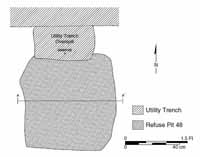 Figure 21. Plan view of Refuse Pit 48.
Figure 21. Plan view of Refuse Pit 48.
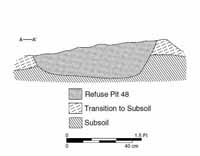 Figure 22. Profile of Refuse Pit 48.
24
Figure 22. Profile of Refuse Pit 48.
24
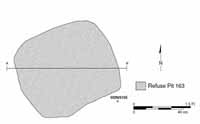 Figure 23. Plan view of Refuse Pit 163.
Figure 23. Plan view of Refuse Pit 163.
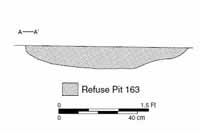 Figure 24. Profile of Refuse Pit 163.
Figure 24. Profile of Refuse Pit 163.
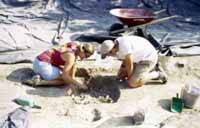 Figure 25. In-progress excavation of Refuse Pit 48.
pit with sloping sides and a shallow, irregular bottom cut into subsoil. The feature measured 73 cm (2.4 feet) north-south by 75 cm (2.5 feet) east-west and after excavation measured 11 cm (4 in.) in depth (Figures 23 and 24).
Figure 25. In-progress excavation of Refuse Pit 48.
pit with sloping sides and a shallow, irregular bottom cut into subsoil. The feature measured 73 cm (2.4 feet) north-south by 75 cm (2.5 feet) east-west and after excavation measured 11 cm (4 in.) in depth (Figures 23 and 24).
Excavation of Refuse Pit 19 and 48 unearthed 2,018 and 1,261 animal bones, respectively, most of which displayed evidence of both cleaving and sawing (Figure 25). The bones were revealed to be tightly packed and intertwined within the features with the majority representing cattle remains. Most of the body cuts were present in the cattle assemblage, but there was a distinct absence of hooves and a low number of head bones. Sheep and swine remains were also recovered from the features in the form of mostly shoulder cuts. The absence of beef waste parts (heads and feet), coupled with the presence of only cuts of mutton and pork, indicates the butcher at the Williamsburg Theater site was not slaughtering live animals on his property and then disposing of unwanted parts. Rather, partially butchered carcasses and larger cuts were brought to the site to be processed into smaller, individual cuts of meat to be sold at the market.
Refuse Pit 163, while similar in size and shape, produced only four fragments of bone. Soil chemistry analysis of the feature fill revealed that the pit contained a high level of 25 lime. Lime may have been employed as a means of accelerating the decomposition process of the waste materials deposited within the pit.
Artifacts in all three pit features were rather sparse, indicating the pits were specifically dug for the disposal of the butchery waste. Fragments of yellowware were used to determine the TPQ date of 1830 for Pits 19 and 48. While Pit 163 also contained a similar fragment of yellowware, the TPQ date for this feature was 1846 based on a copper alloy cartridge case. The dates of all three pits fall within a very short time frame and appear to be associated with an early occupant of the dwelling.
Outbuilding 1 (15DB-145, -199, -200, -201, -202, -203, -204, and -215)
Outbuilding 1 appeared after the second stage of machine stripping of the project area as a series of eight small, rectangular postholes which formed the outline of a structure approximately 6 feet north-south by 8 feet east-west (see Figure 11). The northwest corner posthole (15DB-200) was located 50 cm (1.6 feet) south and 1.9 meters (6.2 feet) east of the northeast corner of the house foundation (15DB-35). Along with posthole 15DB-200, a linear row of three other postholes (15DB-202, -204, and -145) formed the northern wall of the structure. Posthole 15DB-202 was located 58 cm (1.9 feet) due east of posthole 15DB-200, and posthole 15DB-204 was subsequently situated 58 cm (1.9 feet) due east of posthole 15DB-202. The northeast corner posthole (15DB-145) was located 66 cm (2.2 feet) from posthole 15DB-204. The southern wall of Outbuilding 1 consisted of a row of four postholes (15DB-199, -201, -203, and -215). The southwest corner posthole (199) was established 1.9 meters (6.2 feet) due south of posthole 15DB-200. Posthole 15DB-201 was situated 64 cm (2.1 feet) due east of posthole 15DB-199, and posthole 15DB-203 was subsequently located 60 cm (2.0 feet) due east of posthole 15DB-201. The southeast corner posthole (15DB-215) was established 64 cm (2.1 feet) from posthole 15DB-203.
Each posthole measured approximately 20 cm in length and 15-20 cm in width and varied in depth from 5 to 10 cm into subsoil. The excavated postholes had flat bottoms with straight or slightly sloping sides. Excavations revealed no postmolds, however, a segment of a wooden post was uncovered in posthole 15DB-215. The remnant of the wooden post measured 45 cm (1.5 feet) in length, 8 cm (3 in.) in width, and 4 cm (2 in.) in thickness. The post was a machined piece of lumber which was beveled to a point on one end, thereby allowing it to be more easily driven in the ground. The presence of a driven post explains the absence of postmolds because the builders, rather than dig a hole and set a post in place, simply pounded the beveled post into the soil. Such a practice would be acceptable given the dimensions of the outbuilding. The small size and the impermanent construction method indicates the building most likely functioned as a type of storage structure such as a shed.
Only postholes 15DB-145, -199, and -202 produced datable artifacts and a TPQ date of between 1762 and 1775 was determined, but this date cannot be correct given the presence of the modern wooden post segment in posthole 15DB-215. It appears that the few fragments of creamware and pearlware were incorporated into the posthole fill when the posts were removed. As most organic materials tend to quickly decay in the Virginia climate, the wooden post survived the twentieth century due to the fact that the parking lot ultimately sealed the site. This would indicate that the destruction of the outbuilding predated
26
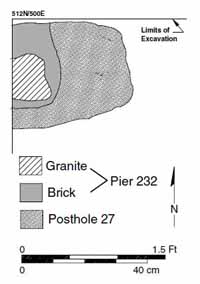 Figure 26. Plan view of Posthole 27.
Figure 26. Plan view of Posthole 27.
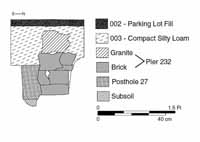 Figure 27. Profile of Posthole 27.
the construction of the parking lot in 1930 and occurred sometime in the early twentieth century possibly coinciding with the pre-1924 destruction of the house.
Figure 27. Profile of Posthole 27.
the construction of the parking lot in 1930 and occurred sometime in the early twentieth century possibly coinciding with the pre-1924 destruction of the house.
Outbuilding 2 (15DB-27, -29, -165, -167, -169, -171, and -232 [Master Context M7])
Outbuilding 2 was first identified through the excavation of postholes 15DB-27 and -29 in Test Unit 512/500. After the site was machine stripped during the second stage of excavation four more postholes were revealed, three of which aligned with the 500 easting grid line (15DB-165, -167, and -169) and one feature (15DB-171) which was located approximately 50 cm (1.7 feet) to the east of posthole 15DB-169 (see Figure 11). The five postholes situated along the west site boundary extended partially beneath the west wall of the project area and therefore only the visible sections of the features were excavated.
The northern edge of posthole 15DB-27 was located at 512/500 and measured 43 cm (1.4 feet) in length north-south and 38 cm (1.25 feet) in width east-west (Figure 26) . Excavation revealed the posthole was cut into subsoil and contained a small brick pier (15DB-232) set against the north wall and topped with a granite stone (Figure 27). The pier was three courses deep below the stone and measured approximately 40 cm (1.3 feet) from the surface of the stone to the bottom of the pier. The exposed portion of the pier measured 20 cm (8 in.) in length north-south and 15 cm (6 in.) in width east-west. The large stone measured 15 cm (6 in.) in length north-south, 12 cm (5 in.) in width east-west, and 14 cm (5 in.) in depth. As the southern wall was straight and the pier did not occupy the entire feature, it appears the pier served to buttress a structural post. A TPQ date of 1880 was established for the fill of posthole 15DB-27 based on two fragments of manganese-solarized glass.
Posthole 15DB-29 was located approximately 10 cm (4 in.) due south of posthole 15DB-27 and measured 80 cm (2.6 feet) in length north-south and 45 cm (1.5 feet) in width east-west. Posthole 15DB-29 was cut into subsoil and highly disturbed by roots
27
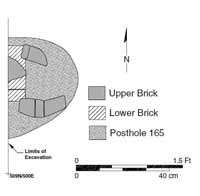 Figure 28. Plan view of Posthole 165.
Figure 28. Plan view of Posthole 165.
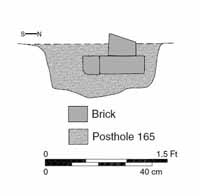 Figure 29. Profile of Posthole 165.
and rodents which caused the feature to appear much larger in plan and more irregular in profile than the other four postholes. The feature fill contained several brick fragments but excavation did not reveal evidence of a pier. A TPQ date of 1907 was determined for the fill based on a fragment of a Bakelite comb, but the integrity of the fill may have been compromised by the presence of root and rodent disturbance.
Figure 29. Profile of Posthole 165.
and rodents which caused the feature to appear much larger in plan and more irregular in profile than the other four postholes. The feature fill contained several brick fragments but excavation did not reveal evidence of a pier. A TPQ date of 1907 was determined for the fill based on a fragment of a Bakelite comb, but the integrity of the fill may have been compromised by the presence of root and rodent disturbance.
Posthole 15DB-165 was situated approximately 100 cm (3.3 feet) due south of posthole 15DB-29 and measured 44 cm (1.4 feet) in length north-south and 31 cm (1 foot) in width east-west (Figure 28). Posthole 15DB-165 exhibited gently sloping walls and a flat bottom cut into subsoil at 20 cm (8 in.) in depth (Figure 29). The feature contained several whole bricks arranged in a U shape, which indicates the formation possibly served to shore up a wooden post set in the posthole. Fragments of lime cement were found, establishing the date of the feature to the late nineteenth through early twentieth century.
The northern edge of posthole 15DB-167 was uncovered approximately 30 cm (1 foot) due south of posthole 15DB-165 and measured 40 cm (1.3 feet) in length north-south and 33 cm (1.1 feet) in width east-west. Posthole 15DB-167 exhibited gently sloping walls and a flat bottom cut into subsoil at 44 cm (1.4 feet) in depth. The feature contained several sizable brick fragments, but they were not arranged in a pattern that would indicate the brick functioned to shore up a post. A TPQ date of 1775 was determined for the fill based on a fragment of pearlware.
Posthole 15DB-169 was revealed approximately 40 cm (1.3 feet) due south of posthole 15DB-167 and measured approximately 35 cm (1.2 feet) in length north-south and 25 cm (10 in.) in width east-west. Posthole 15DB-169 exhibited sloping walls and a V-shaped bottom cut into subsoil at 23 cm (9 in.) in depth. No significant brick fragments were recovered from the feature that would indicate a brick buttress once existed in posthole 15DB-169. A TPQ date of 1795 was determined for the fill based on a fragment of polychrome pearlware.
28Posthole 15DB-171 was a shallow, circular feature situated approximately 50 cm (1.7 feet) to the east of posthole 15DB-169 and measured 25 cm (9 in.) in diameter. The feature exhibited a rounded profile cut into subsoil at 8 cm (3 in.) in depth. While posthole 15DB-171 appeared to be associated with Outbuilding 2, it displayed different characteristics in size, shape, and location. It was circular, extremely shallow, and out of alignment when compared to the other five postholes. Such facts would indicate that post 15DB-171 was possibly part of a fence line rather than a structural posthole, but this must remain merely speculation due to the singular nature of the feature. A TPQ date of 1864 was determined for the fill based on a fragment of Leighton's Patent glass.
The Sanborn Fire Insurance maps and aerial photos indicate the postholes for Outbuilding 2 approximate a property boundary line. However, the fact that the features were in such close proximity to one another and do not span the entire length of the site indicates the postholes were part of structure rather than a fence. The structure appears to have been constructed in the late nineteenth century and was destroyed prior to 1904 based on the absence of the building on the 1904 Sanborn map. Outbuilding 2 was a more substantial structure than Outbuilding 1 due to its larger and more widely spaced postholes. While nothing was uncovered which would indicate the precise function of Outbuilding 2, it is possible the structure may have served as a small barn.
Garden Features (Master Context M8)
Thirteen small, bullet-shaped features were exposed to the north of the house foundation (see Figure 11). The features were located within grid units 506/507-8 and each measured approximately 20 cm (8 in.) in length north-south and 10 cm (4 in.) in width east-west. It was determined by the project archaeologist that a 25% sample of the thirteen features would provide adequate insight regarding their function. The three features chosen for excavation (15DB-173, -181, and -191) displayed extremely shallow profiles measuring only 2 to 3 cm in depth. The only artifact recovered from any of the three features was a small bone fragment from 15DB-181 and therefore a TPQ date was not determined.
Excavation revealed little evidence regarding the function of the thirteen features, but due to their spatial density, irregular spacing, and shallow nature it was determined the depressions were not part of a fence line or structure. A more probable explanation is the features were the remnants of garden planting holes.
Fence Line 1 (Master Context M9)
One definite and one probable fence line were exposed within the project area (see Figure 11). The definite fence line (Fence 1) was composed of three circular postholes (15DB-218, -224, and -225) approximately 25 cm (9 in.) in diameter which contained no postmolds. The northernmost posthole (15DB-225) was located 1.2 m (4 feet) south of the Williamsburg Movie Theater along the 517 easting grid line and the two subsequent postholes (15DB-218, -224) were each spaced approximately 2 m (6.6 feet) apart. The postholes appeared to be modern (early twentieth-century) based on the high clay content of the feature fill and the precise nature of the feature cut. Such attributes indicate the postholes were originally excavated to a great depth with a tool such as a posthole digger 29 rather than a shovel. Due to their modern appearance, the postholes were not investigated.
Fence Line 2 (Master Context M10)
The second fence line (Fence 2) was composed of two rectangular postholes (15DB-216, -217) and one square posthole (15DB-226) which contained no postmolds (see Figure 11). Posthole 15DB-216 and -217 measured approximately 25 cm (9 in.) in length north-south and 15 cm (6 in.) in width east-west. Posthole 15DB-226 measured approximately 15 by 15 cm (6 by 6 in.). All three postholes were shallow in profile and measured approximately 5 cm (2 in.) in depth. The northernmost posthole (15DB-226) was situated approximately 80 cm (2.6 feet) south of the Williamsburg Movie Theater along the 516 easting grid line. Posthole 15DB-216 was located 2.4 m (8 feet) due south of posthole 15DB-226, and posthole 15DB-217 was subsequently located 2.8 m (9 feet) due south of posthole 156DB-216. All three features were excavated, but only posthole 15DB-217 produced a datable artifact in the form of a fragment of creamware. As the postholes are associated with the nearby house foundation, it appears that Fence Line 2 was erected sometime in the nineteenth century.
Linear Trench (15DB-222)
Linear Trench 15DB-222 was located approximately 2.8 m (9 feet) due south of the Williamsburg Movie Theater, with the eastern side of the trench situated along the 517 easting grid line. The trench measured approximately 50 cm (1.6 feet) in width east-west and 1.6 m (5 feet) in length north-south. The original length of the trench was shortened by the disturbance of Modern Utility Trench 25 to the north and Modern Utility Trench 13 to the south. The trench was also disturbed along its eastern side by posthole 15DB-224. Excavation of the trench revealed a shallow, straight-sided, flat-bottomed profile cut into subsoil 4-5 cm in depth. A TPQ date of 1830 was determined for Linear Trench 222 based on a fragment of yellowware. The investigation of the trench revealed no direct insight as to the function of the feature, but this may be due to the fact that either the majority of the feature was stripped away by the backhoe or the that the trench was not manmade at all and was simply a shallow, natural depression. Manmade or natural, Linear Trench 222 appeared to be filled in during the early to mid-nineteenth century and was therefore associated with the house and refuse pit features.
Eighteenth-Century Occupation
Evidence of the eighteenth-century occupation of the area was exceedingly sparse. Excavations revealed a possible fence line, two pit features, a large posthole, and a linear trench, all of which were uncovered below the nineteenth-century component of the site. Only the fence line and one of the pit features produced artifacts by which an eighteenth-century TPQ date could be determined for the feature.
30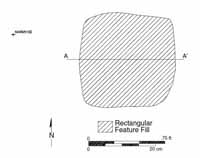 Figure 30. Plan view of Posthole 210.
Figure 30. Plan view of Posthole 210.
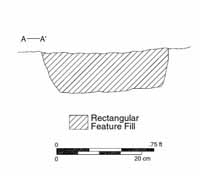 Figure 31. Profile of Posthole 210.
Figure 31. Profile of Posthole 210.
Fence Line 3 (Master Context M11)
Fence Line 3 was composed of three postholes (15DB-206, -208, and -210) with the northernmost posthole (15DB-210) located 5 m (16.4 feet) due south of the Williamsburg Movie Theater along the 513.5 easting grid line. Posthole 15DB-208 was situated approximately 1 m (3.3 feet) to the due south of posthole 15DB-210, and posthole 15DB-206 was subsequently located 1 m (3.3 feet) due south of posthole 15DB-208 (see Figure 11).
Posthole 210 was a rectangular posthole measuring approximately 30 cm (1 foot) in length north-south and 26 cm (11 in.) in width east-west (Figures 30 and 31). Excavation revealed the feature did not contain a postmold and exhibited a slightly sloping, flat-bottomed profile which cut 9 cm (4 in.) into subsoil. A TPQ date of 1790 was determined for posthole 15DB-210 based on a fragment of annular pearlware.
Posthole 15DB-208 was a circular posthole measuring approximately 25 cm (10 in.) in diameter and was partially disturbed by the modern posthole 15DB-212. Excavation revealed the feature did not contain a postmold and exhibited a sloping profile which cut 4 cm (2 in.) into subsoil. The only artifact recovered from the posthole fill was a fragment of creamware which has a TPQ date of 1762.
Posthole 15DB-206 was a circular posthole measuring approximately 35 cm (1.2 feet) in diameter. Excavation revealed the feature did not contain a postmold and exhibited a shallow, sloping profile which cut 1-4 cm (1-2 in.) into subsoil. A TPQ date of 1762 was established for this feature based on a fragement of creamware.
Pit 128
A portion of Pit 128 was uncovered during the initial stage of sampling through the excavation of Test Unit 504/500. Expansion to the east of Test Unit 504/501 revealed the eastern and southern edge of Pit 128. The feature was located within northwest corner of
31
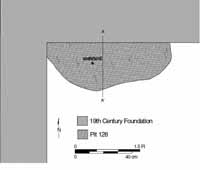 Figure 32. Plan view of Pit 128.
Figure 32. Plan view of Pit 128.
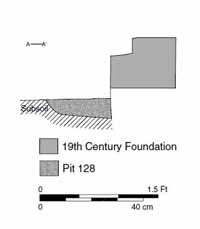 Figure 33. Profile view of Pit 128.
the nineteenth-century house and continued beneath the north and west walls of the foundation (Figure 32). The exposed section measured 87 cm (2.9 feet) in length east-west and 32 cm (1 foot) in width north-south (Figure 33). Excavation revealed the pit contained sloping sides and a rounded bottom 8 cm (4 in.) in depth. Pit 128 unearthed approximately fifty-four artifacts, including iron nail and hardware fragments, four glass buttons, a pharmaceutical bottle neck fragment, and ceramic fragments. A TPQ date of 1780 was determined for the feature based on a fragment of green shell-edged pearlware. The pit appeared to have functioned as a trash pit for the eighteenth-century residents of Block 15.
Figure 33. Profile view of Pit 128.
the nineteenth-century house and continued beneath the north and west walls of the foundation (Figure 32). The exposed section measured 87 cm (2.9 feet) in length east-west and 32 cm (1 foot) in width north-south (Figure 33). Excavation revealed the pit contained sloping sides and a rounded bottom 8 cm (4 in.) in depth. Pit 128 unearthed approximately fifty-four artifacts, including iron nail and hardware fragments, four glass buttons, a pharmaceutical bottle neck fragment, and ceramic fragments. A TPQ date of 1780 was determined for the feature based on a fragment of green shell-edged pearlware. The pit appeared to have functioned as a trash pit for the eighteenth-century residents of Block 15.
Pit 131
A portion of Pit 131 was also uncovered during the initial stage of sampling through the excavation of Test Unit 504/500 (see Figures 10 and 11). The feature was located outside the northwest corner of the nineteenth-century house and continued to the west beneath the western wall of the site boundary. Pit 131 was disturbed by Modern Utility Trench 13. The exposed section of the pit measured 76 cm (2.5 feet) in length north-south from the southern edge of the trench and 27 cm (11 in.) in width east-west from the western wall of the site boundary. Excavation revealed the pit contained sloping walls and a rounded-bottom 19 cm (7 in.) in depth. Pit 131 unearthed no artifacts and therefore a TPQ date for the feature could not be determined, but an eighteenth-century date was speculated based on the stratigraphic location of the pit below the nineteenth-century domestic component of the site.
Posthole 70
Posthole 15DB-70 was uncovered during the initial stage of sampling through the excavation of Test Units 502/501 and 503/501 (see Figure 11). The ovate feature was located 32 within the nineteenth-century house approximately 2 m (6.6 feet) south of the outer edge of the northern foundation wall and 80 cm (2.7 feet) east of the outer edge of the western foundation wall. Posthole 70 measured 45 cm (1.5 feet) in length north-south and 40 cm (1.3 feet) in width east-west and contained a postmold in the southwest portion of the feature. The postmold (15DB-69) was highly root-disturbed and measured 30 cm (1 foot) in length north-south and 24 cm (10 in.) in width east-west. Upon excavation, the postmold exhibited gently sloping sides and a flat bottom 25 cm (10 in.) in depth. The posthole exhibited gently sloping sides and a rounded bottom 30 cm (1 foot) in depth. Neither the postmold nor the posthole contained any artifacts and therefore a TPQ date could not be determined. An eighteenth-century date for the feature was determined based on the stratigraphic location of the posthole below the nineteenth-century domestic component of the site. As no corresponding postholes could be associated with posthole 15DB-70 it is impossible to determine the precise function of the feature. Further excavations beyond the current project area would be required to reveal more about the nature of the posthole.
Linear Trench 126
Linear Trench 126 was revealed during the initial stage of sampling through the excavation of Test Units 504/500, 504/501, and 503/501 (Figure 34). The trench was oriented along a northwest/southeast axis and the northwestern corner of the feature intersected with the western foundation wall at approximately 20 cm (8 in.) due south of the inner edge of the northern foundation. The northwestern section of the feature appeared to end below the western wall of the foundation. Linear Trench 126 measured approximately 40-50 cm (1.3-1.6 feet) in width northeast-southwest and approximately 2 m (6.6 feet) in length northwest-southeast before being cut by Modern Utility Trench 11. Excavation revealed a shallow, rounded profile only 4 cm (2 in.) in depth (Figure 35). Linear Trench 126 produced five bone fragments and five wine bottle fragments, none of which were datable, and therefore a TPQ date for the feature could not be determined. An initial eighteenth-century date seemed likely due to the stratigraphic location of the feature below the house. However, as almost all of the eighteenth-century features in Williamsburg were aligned with the city planning grid which ran on a north-south axis, it seemed apparent that Linear Trench 126 may in fact even date to the seventeenth century. If so, it would appear that the feature may have served as a possible boundary ditch in Middle Plantation, the settlement which predated the founding of the city of Williamsburg in 1699.
33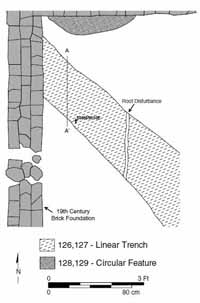 Figure 34. Plan view of Linear Trench 126.
Figure 34. Plan view of Linear Trench 126.
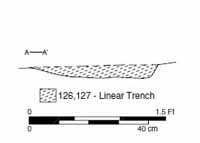 Figure 35. Profile of Linear Trench 126.
Figure 35. Profile of Linear Trench 126.
Chapter 4.
Conclusions and Interpretations
The archaeological investigation of the Williamsburg Movie Theater site resulted in the identification of a domestic site with an occupational range beginning in the early nineteenth century and ending in the early twentieth century. Excavations uncovered the majority of an intact brick foundation with a TPQ of 1820 based on artifacts obtained from the builder's trench. Associated with the structure were two outbuildings with a probable nineteenth-century construction date and three refuse pits which date from the early to mid nineteenth century. Excavation of two of the pits (19 and 48) produced a total of 3,279 animal bone fragments displaying evidence of both cleaving and sawing. The evidence of butchery is especially interesting because only two other butchery sites (the Post Office site and the Firehouse site) have been excavated in Colonial Williamsburg, and both are also situated on Block 15. The Firehouse site exhibited faunal assemblages indicative of eighteenth-century butchering activities. While no butchering remains were found at the Post Office site, documents confirm that the property was once home to a Williamsburg butcher. When the nineteenth-century faunal remains of the Williamsburg Movie Theater site are examined in light of the eighteenth-century occupation what emerges is a pattern of continual use on Block 15 as a location for butchers to conduct their trade in the city of Williamsburg.
Eighteenth-Century Butchery on Block 15
(The Post Office Site and the Firehouse Site)
Historical research uncovered two Williamsburg butchers who appear to be associated with the eighteenth-century activities at the Post Office and Firehouse sites. Benjamin Hanson was a free mulatto born around 1706 to a white servant named Mary Hanson and a mulatto slave named Dick. Both parents were in the employment of Robert Reade, who upon learning of the birth of Benjamin, summoned Mary to court for having an illegitimate mulatto child. However, the charge was later dismissed (York County Records). Hanson was identified as a butcher through his many documented court appearances beginning in 1736/7, and an advertisement for his services which appeared in the Virginia Gazette on October 24, 1745:
Any person, having good Grass Mutton or Beef to dispose of, or, any that they have a Mind to Stall, may meet with a very good Market for the same, by applying, in Time, to Benjamin Hanson, Butcher, and Grazier, living next door to Col. Custis's, in WilliamsburgHanson struggled with his grazier/butcher business, as witnessed by twelve separate court appearances alleging owed money (York County Records). Hanson's woes continued after his death in 1753/4 when his estate was so small that no one would handle his affairs and the sheriff was ordered to administer his meager possessions (York County Records). Such occurrences were not unusual for butchers as they tended to be known only through their debts, crimes, and lack of wealth. One can imagine the difficulties encountered by a free "mulatto" butcher in eighteenth-century Williamsburg. 36
According to the Virginia Gazette advertisement, Hanson's residence was next door to Colonel Custis (Figure 36). Block 4 is the likely location of his residence because east of the Custis property was a large ravine, currently the route of the Colonial Parkway, which would have hindered the placement of a house. If Hanson resided on Block 4, it was likely he occupied the Jones House, a structure predating the remains of the Public Hospital of 1773 (Figure 37). Noël Hume (1973) established that the house was erected in the late seventeenth century and ultimately burned ca. 1760 based on the TPQ date of artifacts recovered from the cellar fill. Within the cellar, a trench was uncovered which dated to ca. 1740 and contained wine bottle seals marked T JONES, indicating the property was owned or occupied by a T. Jones at some date prior to 1740. However, historical evidence indicates that Jones lived on the property in the early 1720s until he moved to Block 31, north of Prince George Street, following his marriage in 1725/6 (Noël Hume 1973). The Jones House is the only known structure to have existed in the area for the years Hanson was operating his grazing/butchery business.
Thus historical and archaeological evidence points to the Jones House as a probable location for the residence of Benjamin Hanson. Based on his newspaper advertisement, Hanson was living on the site by 1745, but it is possible he resided on the property even earlier as the first mention of him as a practicing butcher occurred in 1736. The death of Hanson in 1753/4 closely matches the ca. 1760 date established for the destruction of the house, indicating the structure burned shortly after Hanson's departure. Further clues of the Hanson occupation of the Jones House were provided by artifactual evidence which pointed to the house having fallen on hard times before it burned (Noël Hume 1973). The mid-eighteenth-century remains confirm that a person of lower status and wealth occupied the house, and Hanson's position as a poor butcher would not have afforded him access to high-quality goods.
If Hanson lived on Block 4, it is possible he was grazing and butchering livestock on Block 15 from ca. 1736 to 1753. Butchering remains found on Block 15 were deposited during the time Hanson was in operation.
The second butcher associated with Block 15 was William Cole, who purchased a portion of this block from Samuel Crawley in 1785 (Figure 38). Cole owned Lot O until his death around 1810, when his estate sold the property to William Bowden. The earliest mention of William Cole appeared in the account book of sadler and harness maker Alexander Craig on May 22, 1751. Cole was subsequently noted eleven more times in Craig's account book from 1761 to 1763. As animal hides are an obvious bi-product of the slaughtering process, it appears that Cole provided Craig with the raw materials from which his leather goods where produced. Another reference to William Cole was made in 1758 when he took over the book of debts for fellow butcher Thomas Wilkins (Walsh 1997). A final notation of a butcher named William Cole was found in the memorandum book of Thomas Griffin Peachy, who settled six accounts with Cole beginning in 1799 and ending in 1801. Whether the William Cole mentioned by Craig and Peachy was one and the same is questionable due to the length of time between the first reference in 1751 and the last in 1801. If they are the same man, and assuming Cole did not begin his trade until he was at least 18 years old, then Cole would have been born around 1733. Given the fact that Cole died sometime between his last recorded transaction in 1801 and the selling of his estate in 1810, his age at the time of death would have been approximately 68-77 years old. While it is possible that Cole was a practicing butcher for approximately 50
37
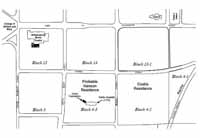 Figure 36. Map showing relationship between Hanson residence and Block 15.
Figure 36. Map showing relationship between Hanson residence and Block 15.
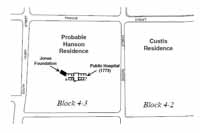 Figure 37. Map of Block 4 with Jones (Hanson) house and Public Hospital of 1773.
38
Figure 37. Map of Block 4 with Jones (Hanson) house and Public Hospital of 1773.
38
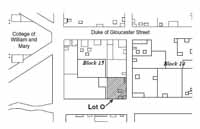 Figure 38. Frenchman's Map identifying Cole's Property on Lot O.
years, it is more probable that at a certain age Cole may have relied solely on the labor of others, such as apprentices, to perform his butchering activities, thereby allowing him to conduct business for such an extended period of time. Another possibility is that there may have been a father/son tandem of butchers, both of whom were named William.
Figure 38. Frenchman's Map identifying Cole's Property on Lot O.
years, it is more probable that at a certain age Cole may have relied solely on the labor of others, such as apprentices, to perform his butchering activities, thereby allowing him to conduct business for such an extended period of time. Another possibility is that there may have been a father/son tandem of butchers, both of whom were named William.
Both the historical and the archaeological record of Block 15 confirmed the use of the area as an eighteenth-century location for butchers to conduct their trade. The excavation of the Post Office site by Ivor Noël Hume in 1961 and the Firehouse site by Patricia Samford in 1983 identified three temporal components dating, respectively, to the early eighteenth century, the mid-eighteenth century, and to the late eighteenth through early nineteenth century.
Post Office Site
1700-1725
The first occupation of the site is represented by a brick-lined well, several boundary ditches, and Refuse Pit E.R. 410. A date range of 1700-1725 was established for the features, but the component could not be associated with any landowner. No butchery remains were identified for this occupational period.
1740-1765
A later component of the Post Office site consisted of an unlined cellar and a well. However, no evidence of butchering activities was uncovered for this occupational period.
1770-ca. 1820
The third component was represented by three features consisting of a structure with a destruction date of 1817 (based on a U.S. penny recovered from the cellar fill), a refuse
39
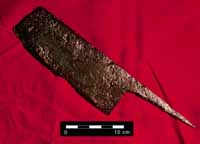 Figure 39. Photograph of eighteenth-century butcher's cleaver from 1961 Post Office excavation.
pit (E.R. 411) dating to 1770-1780 based on creamware, and a nineteenth-century well which remained unexcavated. As the building was extant during Cole's confirmed occupation of the site from 1785 to 1810, it is probable that the structure was put to use by Cole. While only a small number of faunal remains were associated with this occupation, the refuse pit was significant due to the recovery of a well-preserved butcher's cleaver (Figure 39). Given the 1770-1780 TPQ date for the feature, appeared to coincide with Cole's ownership of the property in 1785.
Figure 39. Photograph of eighteenth-century butcher's cleaver from 1961 Post Office excavation.
pit (E.R. 411) dating to 1770-1780 based on creamware, and a nineteenth-century well which remained unexcavated. As the building was extant during Cole's confirmed occupation of the site from 1785 to 1810, it is probable that the structure was put to use by Cole. While only a small number of faunal remains were associated with this occupation, the refuse pit was significant due to the recovery of a well-preserved butcher's cleaver (Figure 39). Given the 1770-1780 TPQ date for the feature, appeared to coincide with Cole's ownership of the property in 1785.
Firehouse Site
1740-1765
The refuse deposit at the Firehouse site produced a date range of 1740-1765 and overlapped the known period of Hanson's operations. The faunal assemblage associated with the Firehouse site is typical of an eighteenth-century butchery site in that it contains an overwhelming number of domestic animal remains. The services of a butcher were typically employed for those meats, such as beef, pork, and mutton, which were raised for the market. The introduction of increasing numbers of sheep in the Chesapeake during the late seventeenth and early eighteenth centuries is reflected by the predominance of sheep remains in the Firehouse assemblage. This butcher slaughtered and butchered the animals on site, as over 90% of the recovered sheep bones were from the head (Walsh 1997). As the head was the least desirable part throughout most of the eighteenth century, butchers slaughtered the animal and simply disposed of the unwanted crania. Local residents could pasture their live animals with Hanson and subsequently use his services as a butcher.
Nineteenth-Century Butchery on Block 15
(Williamsburg Movie Theater Site)
Given the destruction of the James City County records in the Civil War, a search of the historical record failed to uncover the identity of the nineteenth-century butcher who lived and worked on this portion of Block 15. The various faunal remains recovered from Refuse Pits 19 and 48 displayed evidence of having been cleaved, sawn, or a combination of both. During the late eighteenth to early nineteenth-century butchering techniques shifted from the use of a chopping instrument, such as a cleaver or axe, to the use of saws. Butchering methods appeared to evolve as the marketing of meat became increasingly commercialized (Bowen 1990). From the seventeenth to the mid nineteenth century there was a progression of cuts from relatively complete long bones to much smaller pieces, or "individual" cuts of meat. In the seventeenth and eighteenth century animals were butchered in large cuts which were then sold to consumers. The cooks would continue the butchering process in the kitchen, using chopping tools like a cleaver or knife to break up the meat into smaller pieces (Bowen 1994).
Industrialization of food processing in the nineteenth century reduced the need for this home butchering as urban consumers came to be further removed from the production process. Specialized slaughter houses developed to manage the increasing number of animals needed to satisfy the growing demand of the commercial market. Individual butchers no longer killed the animals they handled; instead, they purchased whole or parts of the animal carcass and continued the butchery process at their place of business.
This type of secondary butchery is evident at the nineteenth-century Williamsburg Movie Theater site as certain body parts were absent. Unlike the large percentage of heads and feet recovered at the eighteenth-century Firehouse site, the low number of recovered head remains and the complete absence of hooves from the Williamsburg Theater site indicates the animals were not slaughtered on this portion of Block 15. It appears the butcher purchased partially processed beef carcasses (i.e., minus the heads and hooves) and continued to butcher the meat into smaller, individual cuts for the local market. Also recovered from the site were sheep and swine remains, with the majority representing shoulder cuts of meat. The presence of these cuts indicates the butcher, rather than acquiring the entire animal, was simply purchasing a shoulder of pork or mutton and processing it for local consumers.
Secondary butchering allowed nineteenth-century residents to purchase meat in individual cuts sawn to the size they desired much in the same manner as today. The faunal remains uncovered at the Williamsburg Movie Theater site displayed evidence of this shift to hand sawn butchery but also revealed the continued reliance on cutting tools such as cleavers.
Butchery Waste Disposal Patterns on Block 15
With the removal of urban consumers from the butchering process, there developed a heightened sensitivity to the smells and health hazards involved with the slaughter of animals and disposal of the waste. City records consistently indicate this growing concern as laws became more strict, limiting the location of slaughterhouses to outside the city limits and regulating how butchers could conduct their trade (Bowen 1990). The developing 41 nineteenth-century awareness of the health hazard of animal waste appears to be related to the changing manner of disposal of the faunal remains on Block 15.
During the early to mid eighteenth century it was customary to dispose of most trash by simply dumping it on the ground surface. Such a practice is apparent at the mid-eighteenth-century Firehouse site in which the butchery leftovers were discarded by simply scattering them on the ground.
By the mid nineteenth century, the disposal of butchery waste was much more of a concern as can be seen through the three refuse pits uncovered at the Williamsburg Movie Theater site. The presence of butchered bone in the refuse features displays an effort by the occupant to conceal the animal remains. The attributes of the features—small irregular-shaped pits with a low number of recovered artifacts—indicates they were dug specifically for the disposal of the butchery waste. The absence of bone in Refuse Pit 163 was due to the high level of lime within the feature. Lime may have been placed within the pit as a means of accelerating the decomposition process of the deposited waste materials.
Block 15 and Landscape Identity in Williamsburg
Both the archaeological and historical records provided evidence for the continued use of Block 15 as a base of operations for butchers in eighteenth- and nineteenth-century Williamsburg. The next logical question which must be investigated is why Block 15 was chosen as a viable location for the rather unpleasant particulars of the butchering process and how it continued to maintain this identity throughout the eighteenth and early nineteenth centuries. Such an examination indicates that events in the early eighteenth century settlement of the city of Williamsburg had a direct impact on the later development and utilization of the block in the mid-eighteenth to early nineteenth century.
Early Land Development In Williamsburg
The background for this section draws heavily from the examination of private land development in Williamsburg from the years 1699-1748 by Colonial Williamsburg Foundation historian Cathleene Hellier (1989). Hellier's study examined two aspects of private land development within the city from 1699 through 1748 (the last year that development was contained within the original town boundaries) in order to obtain evidence about the social dynamics in Williamsburg as the community evolved. The first aspect was the formation of neighborhoods, and the second was the opportunity to purchase land in the city, both important indicators of way of life and quality of life in a community.
Middle Plantation, the future site of Williamsburg, was first settled in 1633 and maintained an air of limited political or cultural importance until 1693, when the English monarchs King William and Queen Mary chartered a college to provide Virginia with a means of educating clergy. Construction started in 1695 and by 1699 the College was completed. The College, coupled with the burning of the State House in Jamestown in October 1698, provided new impetus for the placement of the colonial capital at Middle Plantation (Hellier 1989). By June 1699 an act was passed in the Virginia House of Burgesses which directed not only the relocation of the capital but also the formation of the city of Williamsburg.
42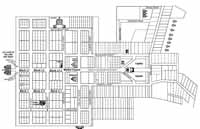 Figure 40. Town plan of Williamsburg.
Figure 40. Town plan of Williamsburg.
With the College located on the western boundary of town, construction of the Capitol and the prison was promptly started and finished on the eastern side of town (Figure 40). On October 29, 1705, as the Capitol neared completion, the College burned, leaving only the outer walls, and it was not until 1709 that an agreement was settled upon for its rebuilding (Hellier 1989). The early years were a key time in the settlement of Williamsburg and the destruction of the College and the subsequent delay in its reconstruction allowed the Capitol, both physically and functionally, to become the primary focal point for community development. The prominence of the Capitol and its governmental function made the area attractive for both business and residential purposes. Many of the gentry who built residences near the Capitol in the early years were colony-level officials who took advantage of the convenient location. Many residents, such as tavern keepers John Young and John Marot, even relocated to the eastern end of town to be near the Capitol since the College was no longer an economic draw (Hellier 1989). The integration of residential and business development appeared to be prevalent among the original purchasers of city lots and it was not uncommon to see early gentry residences amongst taverns and other shops.
The character of Block 15 evolved as a result of the larger developmental trends which shaped the eighteenth-century identity of Williamsburg. With most of the city lots purchased by the 1720s, the marked population expansion of the 1730s and 1740s caused a decided shortage of space within Williamsburg's original borders as much of the gentry developed into long-term owners who tended to occupy multiple lots in the western or more "retired" part of the city. By the late 1740s some areas of the town evolved more 43 toward one use or another. For example, the section of Duke of Gloucester Street east of Market Square was predominantly commercial. Similarly, the area north of Duke of Gloucester Street between Palace Street and Queen Street became less commercial and more residential.
Development of Block 15
Block 15 was one of the areas of Williamsburg distinctly affected by the burning of the College in 1705. Located at the westernmost edge of the original town, south of Duke of Gloucester Street and bordering the College of William and Mary, the block was not extensively settled early in the eighteenth century due to the temporary loss of the influence of the College. As with most of the southwestern part of town, Block 15 suffered early as most development shifted away from the College to Capitol on the eastern side of town. Throughout the mid to late eighteenth century, with commercial development focused to the east of Market Square and residential development to the north of Duke of Gloucester Street, much of Block 15 and adjacent areas to the south (Blocks 4 and 5) contained only widely spaced housing with large tracts of property owned by a few landowners (Figure 41).
Donna Hole (1981) noted that Block 5 and the adjoining properties exhibited a semi-rural character in the eighteenth and early-mid nineteenth century. William Byrd first purchased the eight lots on Block 5 in 1770/1. After Byrd's death in 1778, his estate subsequently sold the property to Samuel Griffin that same year. Block 5 remained in the Griffin family until at least 1846 when Griffin's daughter's second husband's son, F.S. Campbell Stewart, Jr., was informed the value of the land was greatly diminished by the mining of clay for bricks on the property (Hole 1981). This suggested that the large tract of land south of what is know called the William Byrd House remained undeveloped or in pasture until at least 1846.
Block 4 consisted of the property on which Benjamin Hanson lived from approximately 1745 to 1764. The only other known owner, Thomas Walker, sold all eight lots of Block 4 to the colony for the Public Hospital in 1770. The location of the hospital was possibly chosen due to the more retired, semi-rural character of the area as a means of sparing the "sensibilities of the townspeople from the unpleasant prospect of a close-up view of the Asylum inmates" (Hole 1981) .
Block 15, situated directly north of Block 5, also exhibited a semi-rural character in that the property appeared to have been part of an urban to rural transition zone between the more cosmopolitan eastern end of Williamsburg and the surrounding plantations to the west. The Frenchman's Map (1782) indicated, as with Block 5, that most of the houses and outbuildings were erected on the northern edge of Block 15. Block 15 also contained five buildings situated in the southeastern corner of the property, three of which were located on Lot O and most likely occupied by landowner William Cole in 1785. Aside from the northern and southeastern development of Block 15, it appears that in 1782 most of the block was undeveloped (see Figure 38). Block 15 even maintained a semi-rural character into the early twentieth century as B.B. Henderson, born in 1909, recalled the strip of land at the corner of North Henry and Francis Streets being used as an orchard (Henderson 1984).
44Rural/Urban Networks and Block 15
With the growth of Williamsburg in the early to mid-eighteenth century came the problem of food procurement for the town-dwelling families. As the community grew, the availability of town land for raising livestock diminished and most households became less and less self-sufficient. Urban demand for meat soon outdistanced the ability of residents to produce a surplus and it became necessary to formulate strategies in order to accommodate and take advantage of emerging urban needs. Such methods involved the increasing integration of rural areas into the urban market as a means of supplying the community with meat (Walsh 1997).
Crucial to the development of an rural-urban network was the creation of a provisioning system in which rural food and fuel production was transported to the urban community, processed by intermediaries, and distributed to consumers. With a decrease in self-sufficiency, there developed a social connection between town residents and the farmers in the countryside. However, as both rural production and urban consumption increased, markets and middlemen were required to process and distribute the ever-increasing volume of goods entering the town.
As a public market was a symbol of municipal action, a market in Williamsburg was an important part of the initial planning of the city. Governor Nicholson was given power to grant such a facility in 1699. Unlike the centralized commercial towns of New England, the town market was slow to take effect in Virginia because of the sparse population and 45 ample farmland in the early eighteenth century. By 1705, an act provided the trustees of Williamsburg with the power to enlarge the market place, but no market house is mentioned (Brown 1991). In 1710 and again in 1715, Governor Spotswood unsuccessfully proposed to appoint weekly markets in the town. However, by 1722 Williamsburg maintained two markets each week, once on Wednesday and once on Saturday. It was not until 1757 that there is evidence of a market house being constructed with a market being conducted six days a week, except on Sunday.
Only one in-depth description of the eighteenth-century market in Williamsburg has been identified and it consists of a rather derogatory diatribe of the affair in the Virginia Gazette by one "Timothy Telltruth":
In all well regulated cities and towns the utmost regard is paid to the health and circumstances of the inhabitants, by those in power enacting such laws as deter butchers, bakers, &c. from exposing any thing to sale but what is good in quality, and at a certain fixed rate. We of the good town of Williamsburg, metropolis of Virginia! have but too much reason to complain of being neglected in those particulars; for here meat for poverty not fit to eat, and sometimes almost spoiled, may hang in our market for hours, without any notice being taken of the venders of it; and any person may ask what price for his commodity that his conscience will allow him, which is generally exorbitant enough, especially on publick times, or when little meat is at market. And if a man has not got money enough to purchase a whole quarter of meat, the butcher generally demands a penny a pound extraordinary to cut it. In the same manner we are treated about all other provisions, the feller always taking advantage when in his power. In Norfolk, I have heard that the markets are so regulated there that good meat must only bear such a price as the Magistrates think reasonable; and the butcher is obliged to cut his meat upon a farthing a pound being paid more than he demands the quarter. An example worthy of imitation - And the bakers are suffered to make their bread of what weight they think proper, and to put such unwholesome ingredients into it, and bake it of such bad flower, as must be very prejudicial to the health of those who eat it. At this very juncture the bread they bake daily, and sell to the inhabitants, justly entitles them to the pillory, if they had their desserts. A good heavy fine, in all likelihood, would put a stop to their ubiquitous practices, so detrimental to the inhabitants…(Virginia Gazette, Purdie and Dixon, September 7, 1768).
Some aspects of the market may have improved by the end of the eighteenth century when in 1795, resident St. George Tucker noted how the market was neither regular nor well supplied but furnished excellent meat in season (Brown 1991). It appears the nineteenth-century view of the market in Williamsburg was also a positive one. In 1857, a local newspaper described, "…the dead meats we there saw were very nice and tempting, sufficient to excite the palate of the most luxorious epicure" (Ewing 1857) .
Public markets were the direct urban symbols of local agricultural productivity and town growth (Walsh 1997). They provided a control to ensure that food moved from producer to consumer in a timely fashion so as to provide quality goods. The market was frequented by a wide-range of urban society due to its location in a highly visible and public part of town. The Williamsburg Market Square was located near the courthouse and public magazine (see Figure 40). It provided a venue for urban consumers to purchase meat and other produce from butchers and other vendors.
Middlemen such as Benjamin Hanson and William Cole established commercial butchering enterprises in Williamsburg to purchase rural livestock which they then processed and sold to the urban community. Butchers played key roles in the ever-growing rural-urban 46 market network as they transformed the unprocessed commodity of livestock into individual cuts which could then be sold to consumers at the local market. However, it is important to note that as middlemen, butchers were not fully integrated into either the rural or urban side of the network. Butchers needed to locate their operations close to the community in order to sell their meat at the market and yet remain at a location suitable for farmers to distribute livestock for processing. Butchering operations were therefore typically situated at town edges, which not only provided a convenient distribution point, but also kept the rather unpleasant particulars of the butchery process from the sensibilities of the urban residents. Town regulations in the eighteenth and nineteenth century, such as those in place at Williamsburg and Norfolk, were careful to forbid butchering within the marketplace (Walsh 1997).
Just as butchers served as the intermediary between the rural producer and the urban consumer, Block 15 served as an intermediary between the rural and urban landscape. Given its semi-rural character located on the western edge of Williamsburg, Block 15 functioned as a rural to urban transition zone between the surrounding plantations and the more cosmopolitan eastern end of Williamsburg. The property allowed butchers such as Hanson and Cole a suitable location to process and distribute meat to the market, while maintaining an acceptable distance from the community. Later butchers, such as the unknown craftsmen at the Williamsburg Movie Theater site, continued to utilize the benefits of Block 15 into the early to mid-nineteenth century.
Bibliography
- 1933
- Memo dated December 13, 1933 in Allard Property File. Memorandum on file, Archives Department, Colonial Williamsburg Foundation, Williamsburg, Virginia.
- 1781
- Map on file, John D. Rockefeller Library, Colonial Williamsburg Foundation, Williamsburg, Virginia.
- 1994
- "Acquiring Meat in a Changing World." In Halchin, et al., Archaeological Views of the Upper Wager Block, A Domestic and Commercial Neighborhood in Harper's Ferry. U.S. Department of Interior, National Park Service. Harper's Ferry National Historical Park.
- 1990
- Zooarchaeological Report of Salvage Excavations at the Old Firehouse Site, Block 15, Area C, April 12-14, 1983. Report on file, Department of Archaeological Research, Colonial Williamsburg Foundation, Williamsburg, Virginia.
- 1800
- Plan of the City of Williamsburg. Map on file, John D. Rockefeller Library, Colonial Williamsburg Foundation, Williamsburg, Virginia.
- 1932
- Recollections of Williamsburg: As It Appeared at the Beginning of the Civil War and Just Previously Thereto, With Some Incidents in the Life of its Citizens. Special Collections, John D. Rockefeller Jr. Library, Williamsburg, Virginia.
- 1932
- Memo to Colonel Wood dated April 8, 1932. Memorandum on file, Archives Department, Colonial Williamsburg Foundation, Williamsburg, Virginia.
- Colonial Williamsburg Foundation
Photograph File ‒ Architectural Research Department. Negative or Catalog #'s N4543 ‒ Moving Trees, 1924 Aerial Photo Block 15. - n.d.
- Account Book: 1749-57, 1761-63. Microfilm in Special Collections, John D. Rockefeller Library, Colonial Williamsburg Foundation, Williamsburg, Virginia. 48
- 1782
- Carte des Environs de Williamsburg en Virginie, 1782. Rochambeau 57. Map on file, John D. Rockefeller Library, Colonial Williamsburg Foundation, Williamsburg, Virginia.
- 1857
- Williamsburg Weekly Gazette, October 7, 1857.
- 1781
- Plan de la Ville et Environs de Williamsburg en Virginie, 1782. Map on file, John D. Rockefeller Library, Colonial Williamsburg Foundation, Williamsburg, Virginia.
- 1950
- Block 15, 14 (South) & 23, 22 (North) Historical Report, Block 15. Colonial Williamsburg Foundation Library Research Report Series No. 1314. Colonial Williamsburg Foundation Library, Williamsburg, Virginia.
- 1994
- Archaeological Views of the Upper Wager Block, A Domestic and Commercial Neighborhood in Harper's Ferry. U.S. Department of the Interior, National Park Service, Harper's Ferry National Historical Park.
- 1989
- Private Land Development in Williamsburg, 1699-1748: Building a Community. M.A.thesis, College of William & Mary, Williamsburg, Virginia.
- 1984
- Interview conducted by Andrea Foster, September 26, 1983. Typescript on file, John D. Rockefeller Library, Colonial Williamsburg Foundation, Williamsburg, Virginia.
- 1981
- Memo to Ed Chappell on land use at the Griffin House in the eighteenth-century and nineteenth-centuries, Block 5, Building 1, date August 26, 1981. Original on file, Department of Architectural Research, Colonial Williamsburg Foundation, Williamsburg, Virginia.
- 2000
- Interim Report on the Phase II Archaeological Assessment in Advance of the Expansion of the Williamsburg Theater (Block 15, Lot 361). Memorandum on file, Department of Archaeological Research, Colonial Williamsburg Foundation, Williamsburg, Virginia. 49
- 1970
- The Post Office Site Block 15, Area A & B, Colonial Lots O & N, Report on the 1961 Archaeological Excavations Vol. II. The Artifacts from the Unlined Cellar Area 15A, Feature B. Report on file, Department of Archaeological Research, Colonial Williamsburg Foundation, Williamsburg, Virginia.
- 1973
- Monthly Report: June-December, 1973. Report on file, Department of Archaeological Research, Colonial Williamsburg Foundation. Williamsburg, Virginia.
- 1961
- The New Post Office Site, Block 15, Area A & B, Colonial Lots O & N; Report on 1961 Archaeological Excavations Vol. I. Report on file, Department of Archaeological Research, Colonial Williamsburg Foundation, Williamsburg, Virginia.
- 1745
- Virginia Gazette. October 24, 1745.
- n.d.
- Memorandum Book: 1796-1810. Special Collections, John D. Rockefeller Library, Colonial Williamsburg Foundation, Williamsburg, Virginia.
- 1768
- Virginia Gazette. September 7, 1768.
- 1990
- Salvage Excavations at the Old Firehouse Site, Block 15, Area C. April 12-14, 1983. Report on file, Department of Archaeological Research, Colonial Williamsburg Foundation, Williamsburg, Virginia.
- 1904
- Sanborn Fire Insurance Map, Williamsburg, James City County, Virginia. New York.
- 1921
- Sanborn Fire Insurance Map, Williamsburg, James City County, Virginia. New York.
- 1929
- Sanborn Fire Insurance Map, Williamsburg, James City County, Virginia. New York.
- 1933
- Sanborn Fire Insurance Map, Williamsburg, James City County, Virginia. New York.
- 1959
- Custis Square, Block 4. Report dated October, 1959, on file, John D. Rockefeller Library, Colonial Williamsburg Foundation, Williamsburg, Virginia.
- 1997
- Provisioning Early American Towns. The Chesapeake: A Multidisciplinary Case Study. Report to the National Endowment for the Humanities. Colonial Williamsburg Foundation, Williamsburg, Virginia.
Appendix A.
Analysis of Faunal Remains,
by Carrie B. Alblinger and Joanne Bowen
Introduction
Among the discoveries from the excavations conducted at the Williamsburg Movie Theater site was a collection of 3279 animal bones from two pits associated with a post-1820s domestic structure, about whose occupants nothing is known. Joanne Bowen and Stephen Atkins, zooarchaeologists studying the bones, quickly noticed that the assemblage did not look like that from a domestic site. For one thing, the artifact lists from the pits did not contain the typical assortment of trash associated with a domestic occupation; there were very few artifacts at all found in the pits with the bones, a highly unusual occurrence. Trash pits dug to house the garbage from a household do just that—they are filled not only with bone, but with broken and unwanted goods such as bottles, dishes, and other domestic debris as well. These pits contained little other than tightly packed bone, appearing as if they were dug solely for the purpose of disposing that material.
The recovery of "just bones" sent up a signal to examine those bones much more closely, because lack of artifacts was not the only odd thing about the assemblage. The bones themselves possessed some curious qualities, seeming to represent only three species: cattle, pigs, and sheep. This combination of animals is common; the discovery of them unaccompanied by other food species is not. Domestic sites ordinarily have the remains of domestic birds, wild birds and mammals, fish, and turtles, as well as domestic mammals. In addition, a large number of the bones showed butcher's marks, both hacking and sawing, the latter a nineteenth-century innovation indicative of increased commercialization in meat marketing.
The combination of characteristics described above led archaeologists to speculate that the pits contained the refuse not from a household, but from a butcher's operation. This conjecture was strengthened by evidence from archaeological and documentary investigations conducted on Block 15 in the 1960s (at the old Post Office site) and the 1980s (at the Firehouse site), which suggested that Block 15 had been the home and/or workspace for butchers through the middle and late eighteenth century. Block 15 was an intermediate area of colonial and nineteenth-century Williamsburg, not quite rural, but not entirely urban—an ideal location for a rather messy profession requiring contact with the country for its raw materials, and close interaction (but not too close, as ensured by increasing legal sanctions) with an urban area to distribute them. The finds at the Williamsburg Movie Theater appear to show that this trend continued into the nineteenth century as well.
The possibility that the occupant of the Williamsburg Movie Theater site was a butcher, and that the refuse in the pits was the detritus of this craft, presented a zooarchaeological opportunity. Other than the assemblage from the Firehouse site, no other butcher site has been explored in Williamsburg, or is known to have been analyzed in the Chesapeake region. In addition, the Williamsburg Movie Theater assemblage is the only known example of a possible nineteenth-century butcher to have been analyzed. While the food provisioning system in the Chesapeake has been extensively researched for the eighteenth century (Walsh et al. 1997), very little is known about how meat foods were produced, acquired, processed and cooked in the nineteenth century, a time period which saw major shifts in the performance and meaning of these actions (Bowen and Manning 1994). Discovery 54 of the faunal assemblage from the Williamsburg Movie Theater site provided a unique occasion to examine one possible aspect of this as-yet-poorly-understood system.
This study takes the first step in the quest for this knowledge: to ascertain, if possible, whether the bones from the Williamsburg Movie Theater site were indeed those from a butcher's enterprise. To accomplish this task, Colonial Williamsburg zooarchaeologists began a detailed analysis of the bones. Testing the assumption that the assemblage in question actually is refuse from a butcher's operation, however, given the relatively sparse documentary data relating to the nature of the site's occupation and use, was easier said than done. Since no butcher site from the nineteenth century was available, another way to isolate the characteristics of the Theater assemblage was sought. For this purpose, the mid-eighteenth-century Firehouse butcher's site was used to provide a comparison with a site of presumably the same type, although from an earlier time period. To determine if and how it differed from contemporary household faunal assemblages, the Theater assemblage also was contrasted with six early-to-mid nineteenth-century domestic sites from Williamsburg and environs. This combination of comparisons was thought to be able to define the nature of the Theater assemblage, and to make some preliminary statements about early nineteenth-century butchers' enterprises.
Comparisons were begun with the creation of hypotheses to be tested by the application of current theories about and measures of urbanization and its effect on faunal assemblages. Zooarchaeological studies of the establishment and growth of cities in Europe, the Near East, and North America have revealed patterns which, in general, are seen worldwide (Maltby 1979; Stein 1987; Zeder 1988; Crabtree 1990; Bowen 1992; Landon 1996). In brief, as human populations become more concentrated, the open spaces within towns necessary for households to raise their own livestock for food become restricted. Concurrently, rural areas surrounding the city react to the urban need for provisions by first selling excess produce in the city, then producing foodstuffs specifically for urban consumption. Middlemen, such as butchers or grocers, take on the role of procuring, processing, and distributing foods to urban dwellers. In addition, laws are commonly enacted limiting the location of noxious industries such as butchery, and the importation of their raw materials (animals or carcasses) and disposal of their waste products (bones and offal), as well as household disposal of the same.
Zooarchaeologists studying complex urban societies have isolated three measures by which the level of an assemblage's participation in an urban market economy could be ascertained: age ratio, species diversity, and element distribution comparisons. Walsh et al. (1997:68) summarize: "In an urban environment, age profiles from domesticated cattle, pigs, and sheep should show a mark of specialized forms of animal husbandry through the increased presence of younger livestock, hallmarks of a market economy. The variety and relative importance of different animals show whether markets and the decreasing availability of habitats suitable for wildlife constrained the availability of wild animals. Third, element distributions of the major domestic mammals demonstrate the restriction of certain portions of the carcass such as the heads and feet. Taken as a whole, these pieces of evidence provide a measure of the extent to which the provisioning system has become specialized."
Because we were interested in differentiating the remains of a butcher's operation from other types of assemblages in a society known to have had a specialized provisioning system, however, the use of age ratio comparisons was not considered appropriate for 55 this study, since there exists almost no comparative data from rural sites. This study must wait until more rural and urban nineteenth-century sites in this region have been excavated. At the same time, we believed that the other two measures of market participation, species diversity comparisons and element distribution analyses, would allow us to sort out differences between site types and give us the means to begin to recognize nineteenth-century butcher's sites.
We began our study of the sites in our data set with species diversity analysis. Zooarchaeologists looking to understand the nature and relationships of urban and rural domestic sites have often employed observation of the range of animal species utilized at a site. Elizabeth Reitz of the University of Georgia conducted a study of sixteen urban and rural sites from South Carolina and Georgia dating from the late eighteenth to the mid-nineteenth century, which revealed a clear pattern of difference between the two (Reitz 1986a:55-56). In contrast to the rural sites, which likely were more self-supporting entities, the urban diet consisted of greater amounts of meat from domestic animals, including domestic birds, and wild species were much less frequently found in urban assemblages than in rural. Reitz concluded that urban diets seemingly were less diverse than rural ones, a trend she related to the dependence of urban consumers on market distribution systems to obtain their meat.
Nan Rothschild echoes Reitz's conclusions in her 1989 article comparing the diversity of species between highly urbanized New York City and Florida's less developed St. Augustine, showing again that urban domestic sites have less diversity of species than rural sites, especially for those inhabitants most dependent on the market for their subsistence (Rothschild 1989:92-93). She also proposes that "…the increasing participation of an urban community in a market economy, and an increasing reliance on specialist provisioners (butchers and commercial fishermen)… will lead to greater standardization in foods consumed and consequently lower diversity" (Rothschild 1989:93) . The spectrum of diversity seen in these studies and others (Zeder 1988; Bowen 1992; Landon 1996), with highly diverse rural diets on one end, and less diverse urban ones on the other, is hypothesized to extend to and include the faunal assemblages from the "specialist provisioners" mentioned by Rothschild, bumping the urban domestic sites to the center of the range. The refuse from a butcher's operation in an urbanized area should be, by the logic used above, the least diverse faunal assemblage seen in our comparisons, a prediction that was indeed borne out in the data (see below).
Element distribution analyses were conducted next on the sites in the study. However, selection of an appropriate technique for interpreting the butchery patterns seen at the Theater site was somewhat daunting. Prehistoric archaeologists have long employed intersite comparisons of faunal remains to explore issues of slaughter, transport, distribution, and exchange within hunter/gatherer societies. As Walsh et al. outline (1997:315), in order to explain the differential presence of some body parts over others, archaeologists have looked at bone density and resulting differential element preservation, some have looked at the differences in nutritional content of various bones, a number have focused on the meat vs. bone content in various cuts, and others have focused on efficiency as the main determining factor. These studies have tended to focus on either the weight of various cuts or ease of stripping the meat from the bone as being the determining factor of which bones get left at the hunting sites and which get transported back, or "schlepped," to the 56 base camp (White 1952; Perkins and Daly 1968; Yellen 1977; Binford 1978; Lyman 1979; Gifford 1981; Jones and Metcalfe 1988; O'Connell et al. 1988).
Historical archaeologists, too, have applied the techniques of element distribution analysis to explain the patterns of butchery found on more recent sites. Zooarchaeologists studying faunal assemblages from eighteenth-century urban and rural domestic sites have made use of a basic method popularized by Reitz (1986b) of comparing a site's ratios of head, body and foot skeletal elements to the proportion seen in a whole animal to isolate discrete patterns in these ratios. At sites which participate in an urban market economy, a preponderance of meaty body elements is seen, greatly outnumbering the presumably less desirable head and foot parts (Landon 1996:8; Walsh et al. 1997:73). Rural sites, in contrast, where animals are raised, slaughtered, and disposed of on site, show an element distribution approaching that of the normal ratio seen in the complete skeleton. This pattern is seen as well in studies conducted in New England (Bowen 1992) and in the Near East (Zeder 1988). Extending this model for our study, butchers' sites, as processor/distributor, not consumer, sites were hypothesized to possess mostly waste parts—heads and feet—a reversal of the pattern seen at urban domestic sites, the likely final destination of the missing fleshy parts.
Unfortunately, this expected pattern did not materialize for the sites looked at in this study. The Theater site and the domestic sites all shared a similar, almost indistinguishable profile. This rather unexpected result caused us to rethink our technique. We postulated that individual bone elements may not have been the most suitable measure for exploring differences between processor/distributor sites and those of consumers. A butcher would generally have sold parts of an animal as cuts of meat, not individual bones. So, we made use of an alternative working of element distributions, but this time studying meat cuts, not individual bones, in the hope of a more rewarding outcome.
Element distributions based on meat cuts have been often employed in studies attempting to determine the level of wealth or socioeconomic status of a site's occupants. Schulz and Gust (1983), for example, looked at the ratios of different cuts of beef found at a range of sites from late nineteenth-century Sacramento, among them a high-class hotel, saloons of varying distinction, and a prison. Using contemporary data about meat cuts and prices, they created a rank value of meats and found that, indeed, the establishments catering to wealthier, higher status clients had faunal assemblages containing the remains of pricier cuts of meat, and those entertaining lower-class patrons had correspondingly cheaper meat remains. Lyman (1987) elaborated on Schulz and Gust's method, but, hearkening back to the prehistorians, proposed that bones should be sorted into meat cuts ranked by greatest meat to bone ratios, creating more- and less-cost-efficient meat cuts. We felt that this type of method could be "tweaked" to our purposes, but, because of constraints imposed by availability of contemporary documentary information able to provide context, we had to accomplish this in two configurations: first, through the creation of a comparison between rankings of caprine and pig fore- and hindquarter elements; next, by looking at rank values of adult cattle meat cut percentages.
Contemporary accounts reveal that in the early nineteenth-century, the hindquarters of pigs and caprines were in greater demand and were considered more desirable than the forequarters. The relative prices of these pieces given by contemporary writers bear this out. Lydia Child, for example, urges economy-minded housewives to buy the forequarters of both animals "for economy," noting that a hindquarter of mutton was more expensive 57 than the shoulder (Child 1833: 46). Fogg, too, prices the hindquarter at two to four cents more than the forequarter (1832: xxxii-xxxiii). In light of this, the relative percentages of these parts were examined for each site to see whether there was a preponderance of hindquarter elements in relation to forequarter parts at the domestic sites, the former being the more highly valued parts of these animals. Urban domestic sites were hypothesized to possess more hindquarter elements—representing the purchase of such coveted, meaty parts as hams, for example, or legs of mutton—than would a butcher's site, which would have sold off those pieces to consumers.
Similarly, the adult cattle bones in the assemblages were ranked according to the meat cut value found in contemporary records. Arthur Young, in his 1793 "Annals of Agriculture and Other Useful Arts," presents a diagram of the cuts of meat created from a steer, along with a chart providing the price of each cut in London at that time. From this, the adult cattle faunal remains from the sites in this study were broken down into the relative percentage of elements present for each cut of meat, then plotted by price category. An hypothesis was formulated that bones from cheaper, less desirable cuts of meat would be found at a butcher's site, not as markers of socioeconomic status, but under the assumption that consumers would be more likely to purchase the more desirable (read, higher priced) cuts, which remains would then be found in greater relative quantities at the urban domestic sites in the study. The bones remaining at the butcher's were supposed to be representing cheaper cuts, as the butcher would be more motivated to sell high priced cuts of beef.
The results of these analyses were puzzling. For the most part, the analyses did not work the way they were "supposed" to. When the basic element distribution analyses were conducted, the Williamsburg Movie Theater site looked very different from the eighteenth-century Firehouse butcher site, but could not be easily, if at all, distinguished from nineteenth-century domestic sites, with their general lack of heads and feet and preponderance of body cuts. As with the basic element distribution comparison, no common pattern was seen among the domestic sites which made them distinguishable as a group from the Theater assemblage when meat cuts were the unit of analysis, not individual bones.
Possible explanations are many, definite ones few. One relates to the fact that the Theater assemblage is located behind a dwelling. Perhaps the assemblage is the refuse from a butcher's operation; at the same time, however, it may have served as the repository for meat food remains consumed by his own family, presumably the less desirable, cheaper pieces of meat. This commingling of distributor-processor and household food remains may have masked any attributes that would have been apparent had only processing gone on at the site.
An alternative explanation is the possibility of the filleting of meat before sale, leaving the quantities of meaty bones seen at the Theater site that confounded the hypotheses posed above. Filleting also allows for the potentiality that the ambiguities found in the Theater assemblage in comparison to the domestic sites, and likely the lack of pattern seen in the domestic sites themselves is a result of the supposedly "modern" purchasing practice of selling and buying boneless meats. This in itself could explain the quantities of bones representing both high and low priced cuts of meat found at all the nineteenth-century sites in this study.
58The current results do not deny or confirm that the Theater site is a butcher's site so much as they indicate that one of the traditional tests and measures commonly used by zooarchaeologists, element distributional analysis, may not be appropriate to study of more recent time periods, of areas where laws have altered the nature of urban processing and disposal of meat remains, or, as is most likely in this case, in towns such as Williamsburg, for which a lack of context for the results exists because the nineteenth-century distribution system is not well understood.
Species Diversity
Based on results from species diversity analyses (summarized above), refuse from the butcher's shop was hypothesized to harbor only a narrow range of species, as would be expected from a specialized producer/distributor. The Williamsburg Movie Theater assemblage fits the proposed scenario perfectly, almost shockingly so, and in great contrast to all other sites in the sample under discussion (Table 1). Fully 97% of the Theater bones belong to the domestic mammal category: cattle, pigs, and sheep or goat. The remaining 3% came from a dog, a commensal species (that is, a species not normally part of the cuisine of the culture under study, but often, as with dogs, cats, and mice in Anglo-American culture, associated with human habitation). This extreme lack of species diversity was entirely unexpected; faunal assemblages like that from the Theater are just not seen ordinarily.
The other sites in the sample are typical of urban and rural domestic sites: the urban sites display more reliance on domestic meats, mammal and bird, and have fewer wild species than the rural sites, which reverse these generalizations. However, regardless of overall abundance or lack of diversity, all of the domestic sites have in their faunal assemblages domestic mammals and birds, wild mammals and birds, turtles, and fish, in varying proportions. Next to these assemblages, the overwhelming concentration of domestic mammal bones—to the exclusion of all else—from that of the Theater makes it stands out as something very different.
Basic Element Distributions
To recap models of relative levels of market participation based on basic element distributions, rural sites, where animals are raised, slaughtered, and disposed of on site, show an element distribution approaching that of the normal ratio seen in the complete skeleton. At sites which participate in an urban market economy, a preponderance of meaty body elements is seen, greatly outnumbering the less desirable head and foot parts. A butcher's site, then, is hypothesized to possess mostly waste parts—heads and feet—reversing the pattern seen at urban domestic sites.
The Firehouse butcher's assemblage illustrates this model very well (Table 2). In this assemblage, body parts are never the dominant proportion of bones for any of the major domesticates under study. Head bones are most likely to be the majority element, followed typically by body elements, with foot elements making up the smallest proportion of the total. The Theater element distribution differs from this pattern, as a rule showing an inverse profile to that described above, which makes it look surprisingly like a typical urban domestic site. Body part elements are the greatest percentage of bones in the pig,
59
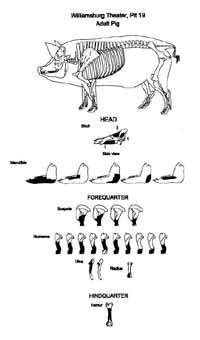 60
60
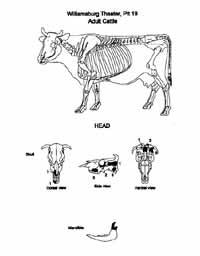 61
adult cattle, and caprine (sheep or goat) assemblages, accompanied by smaller proportions of head elements, and few if any foot elements. The immature cattle pattern differs from that seen for the other species, a possible consequence of small sample size. The calf head elements just outnumber in proportion the body elements, which in turn are more than double the percentage of foot elements.
61
adult cattle, and caprine (sheep or goat) assemblages, accompanied by smaller proportions of head elements, and few if any foot elements. The immature cattle pattern differs from that seen for the other species, a possible consequence of small sample size. The calf head elements just outnumber in proportion the body elements, which in turn are more than double the percentage of foot elements.
The Theater site does not evince such a clear pattern of difference in comparison with the domestic sites in the sample (see Table 1), on the whole looking very much like household refuse on the basis of the element distributions. The proportions of head/body/feet elements for adult cattle and caprines are very similar for both the Theater site and the various domestic sites. In each case, body elements predominate over the other skeletal parts. Three of the sites mirror that of the Theater, with head elements showing up as the next most prevalent bone type, followed by foot bones. The remaining three sites reverse that pattern; foot elements predominate over head elements. The element distribution for immature cattle does not show a strong correlation among the domestic sites, but appears in the main to show more body part elements than heads and feet. The Theater assemblage, however, has a bare majority of its immature cattle bones in head elements, followed closely by body elements.
The pig elements display the only marked difference between the Theater assemblage and the domestic sites. The nineteenth-century domestic sites all have a significant proportion of pig bones in the form of head elements, all greater than 60%. The second most prevalent bone type is body elements (never more than 30% of the total), followed by feet elements in every case. In contrast, the Theater site has a slim majority of pig bones in body elements (54.2%), followed by head elements (45.8%). Also unlike all the other sites, no pig foot elements appear at the Theater site.
Forequarter/Hindquarter Ratios
As noted above, the failure of the basic element distributional analysis, based on individual head, body, and foot bone ratios, required a reexamination of the method. Because animal foods were not generally distributed as individual bones, but as cuts of meat, the analysis was run again, this time using data that reflected the historical values and desirability of specific animal parts. In this section, caprine and pig fore- and hindquarters are compared in light of known historical preferences. The body elements of the animals were combined into forequarter (scapula, humerus, radius, and ulna) and hindquarter (inominate, femur, tibia, and fibula) groups, as suggested by contemporary accounts. Then the ratios of each versus the other were compared (adult cattle, possessing a different, more detailed historical value ranking, were handled separately, see below). Urban domestic sites were hypothesized to possess more hindquarter elements—representing the purchase of such coveted, meaty parts as hams, for example, or legs of mutton—than would a butcher's site, which would have sold off those pieces to consumers.
Again, as in the study of overall element distributions, the Firehouse butcher site fits the model, with a minimum of 60% of elements in the forequarter category for these two species (Table 3). So, too, does the Theater site, having proportionately more pig and caprine forequarter than hindquarter elements. The domestic sites, however, do not fall into place quite as neatly. When the Theater assemblage is compared to the domestic sites in terms of ratios of fore- and hind-quarter elements, again no true pattern emerges. Four
62
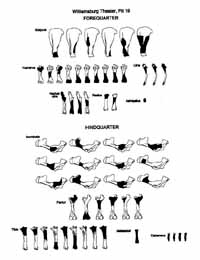 63
of the domestic sites have a nearly equal proportion of pig fore- and hindquarters. The other two sites are split—one possesses the expected preponderance of hindquarters for a domestic site; the other shows a proportion like that hypothesized for a butcher's establishment. The caprine bones likewise display no dominant pattern: three sites do have a greater frequency of hindquarter elements; however, two other sites have an equal distribution of fore- and hindquarter elements, and the remaining site has more fore- than hind- parts. Like the element distributions, the urban domestic sites have no common profile—no site has a consistent majority of fore- or hindquarter elements, varying both by site and by species.
63
of the domestic sites have a nearly equal proportion of pig fore- and hindquarters. The other two sites are split—one possesses the expected preponderance of hindquarters for a domestic site; the other shows a proportion like that hypothesized for a butcher's establishment. The caprine bones likewise display no dominant pattern: three sites do have a greater frequency of hindquarter elements; however, two other sites have an equal distribution of fore- and hindquarter elements, and the remaining site has more fore- than hind- parts. Like the element distributions, the urban domestic sites have no common profile—no site has a consistent majority of fore- or hindquarter elements, varying both by site and by species.
Ranked Meat Cut Percentages
Beef cuts, too, were ranked according to contemporary notions of value. Here, though, more detailed historical information was available, allowing for the ranking of beef not just into fore-or hindquarters as with caprines and pigs, but into specific meat cuts, such as "rump" or "mouse buttock." These historical sources gave price information as well, facilitating comparisons of the sites based on ratios of high priced versus lower priced beef cuts (Table 4). We posited that the higher priced cuts would appear at the domestic sites, a result of consumer preference for desirable, higher-priced beef cuts, and butcher preference to profit from selling these pieces before they spoiled. Lower priced cuts, in general, we expected to find in the butcher's refuse, presuming a smaller incentive to rid oneself of less expensive meat cuts.
As with the other element distribution comparisons attempted above, no common pattern was seen among the domestic sites which made them distinguishable as a group from the Theater assemblage. The expected meat cut distributions did not appear. Among the domestic sites, results were highly variable, each site exhibiting a mix of bones from meat cuts in all price categories. This pattern was seen as well at the Theater site, where a surprisingly high percentage of bones associated with more expensive meat cuts such as sirloin and rump cuts were seen, along with the expected remains from cheaper cuts.
This unexpected bone distribution at the Theater site may be a result of de-boning and filleting meat before sale, an activity implied in contemporary cookbook instructions to acquire boned meat for such dishes as veal cutlets, and which would result in the bones from expensive cuts remaining at the processing site: "Have the veal cut into slices about 3/ of an inch in thickness…" (Beeton 1865: 354). However, Child's household economy book The American Frugal Housewife recommends the purchase of the bones leftover from filleting meat: "Bones from which roasting pieces [more expensive cuts] have been cut may be bought in the market for ten or twelve cents, from which a very rich soup may be made… If the bones left from the rump [another pricey portion] be bought, they will be found full of marrow…" (Child 1833:44). This practice should restore the expected pattern, as bones from expensive cuts would still leave the butcher's shop. It appears that, in early nineteenth-century Williamsburg, at least, this practice was not a factor in influencing the pattern seen at the sites in our study.
64Discussion
After an examination of the element distribution results, only two definitive statements can be made about the marketing and distribution of meat as seen in the Williamsburg Theater faunal remains: they represent only large domestic mammals, and the occupant of the site was not acquiring and processing whole animals on-site. While all element types, except pig foot elements, were represented in the assemblage, the generally low ratio of head and foot to body elements indicates that animals had been partially processed—likely having their heads and feet removed—prior to their arrival at the Theater site. This is consistent with patterns established once municipal areas implement laws prohibiting certain activities, such as slaughtering, within city limits (Landon 1996:8).
Beyond this, few definite assertions may be made. None of the sites in the sample display the patterns hypothesized by this study, or truly any pattern at all when the element distribution analysis was performed. Possibly, a differentiation would be visible if the domestic sites in question were understood in greater detail. Information about the inhabitants of the sites, their levels of wealth, or their social standing, is sparse, and few other early nineteenth-century faunal assemblages from the Chesapeake have been analyzed to put them into context. Little information is currently available as well on links these households had to the surrounding areas, and the level of their ability to bypass the urban distributors. A project undertaking a greater understanding of domestic faunal assemblages of the nineteenth century, a task beyond the scope of this analysis, would be of great aid in creating a backdrop against which to explore contemporary processing and distribution sites. Perhaps a pattern is present in element distributions, but is not understood because of lack of knowledge about the nature of nineteenth-century faunal assemblages.
Some other possibilities exist, however, for explaining the perceived lack of pattern in the element distributions. As proposed above, possible commingling of business and household food refuse may have corrupted the profile for the Theater site, giving it some of the characteristics of a domestic site. Perhaps, too, the practice of butchery in the nineteenth century, of selling and buying boneless meats as well as cuts on the bone, left its mark. The results of this study appear to say that the day-to-day working of butchers and other middlemen processors and distributors are not well enough understood to enable the creation of fruitful predictions about differences between these sites and domestic sites. Research in this direction, again, beyond the scope of this project would be essential to further analytical attempts akin to that tried here.
Only the species diversity analysis proved successful in revealing an obvious difference in the assemblages, one which may be the key element in distinguishing between processor and consumer sites in the nineteenth century: the Theater site evinced an amazing lack of diversity, showing only large domestic mammals, in contrast to the other sites in the study, which had birds, fish, and wild species in evidence. This measure of difference may be the way, at this point, to mark the Theater assemblage as a different type of site than the domestic sites. The high concentration of only domestic mammal remains may be an attribute of nineteenth-century butchers' faunal assemblages, and one piece in the puzzle of the distribution systems of which they were a part.
Conclusion
The faunal assemblage from the Williamsburg Movie Theater site may well be that from a butcher practicing his trade in the early to mid nineteenth-century. However, until further work is conducted to delineate the nature of both nineteenth-century domestic sites (and the differences among them) and processor/distributor sites, the attribution will be in doubt. A few characteristics of the site do, however, appear to support the notion that the Theater site is indeed that of a butcher: the extreme lack of species diversity in the assemblage, the relatively small percentage of domestic refuse found in the pits along with the bones, and the clustering of earlier butchering activity in the vicinity of the site.
Williamsburg's well understood eighteenth-century market system did not come to a complete halt with the removal of the capital of Virginia to Richmond in 1780. The population of the city and environs changed very little, remaining above a thousand inhabitants, well above the threshold proposed by Walsh et al. to effect a focus on market production of animal foods on the surrounding farms (Walsh et al. 1997:61). From the perspective of the faunal evidence, however, something different began to happen. The sites examined have little apparent patterning, and the models that explain the patterns seen in eighteenth-century assemblages do not appear to have their usual utility. It is likely that new models will have to be created to explain the relationships described here. It is to be hoped that further studies of both processor and consumer sites within this new style of market economy will provide the information that is now lacking, information that reveal the true role in that economy of the faunal assemblage excavated at the Williamsburg Movie Theater.
Bibliography
- 1865
- Mrs. Beeton's Every Day Cookery and Housekeeping Book. Reprinted 1984 for Gallery Books, New York.
- 1978
- Nunamiut Ethnoarchaeology. Academic Press, New York.
- 1992
- Faunal Remains and Urban Household Subsistence in New England. In The Art and Mystery of Historical Archaeology: Essays in Honor of James Deetz, edited by Anne Yentsch and Mary C. Beaudry. CRC Press, Boca Raton, Florida.
- 1994
- Acquiring Meat in a Changing World. In Archaeological Views of the Upper Wager Block, A Domestic and Commercial Neighborhood in Harper's Ferry, edited by Jill Halchin, et al. U.S. Department of Interior, National Park Service. Harper's Ferry National Historical Park.
- 1833
- The American Frugal Housewife. Reprinted 1971 by the Ohio State University Libraries. 67
- 1990
- Zooarchaeology and Complex Societies: Some Uses of Faunal Analysis for the Study of Trade, Social Status, and Ethnicity. In Archaeological Method and Theory, Vol. 2, edited by Michael B. Schiffer. University of Arizona Press, Tucson.
- 1832
- The Cooks Own Book. Reprinted 1997 by Rare Book Publishers, Merrifield, Virginia.
- 1981
- Taphonomy and Paleoecology: A Critical Review of Archaeology's Sister Disciplines. Advances in Archaeological Method and Theory 4:365-438.
- 1988
- Bare Bones Archaeology: Bone Marrow Indices and Efficiency. Journal of Archaeological Science 15(4):415-423.
- 1996
- Feeding Colonial Boston: A Zooarchaeological Study. Historical Archaeology 30(1).
- 1979
- Available Meat from Faunal Remains: A Consideration of Techniques. American Antiquity 44(3):536-546.
- 1987
- On Zooarchaeological Measures of Socioeconomic Position and Cost-Efficient Meat Purchases. Historical Archaeology 21(1):58-66.
- 1979
- Faunal Studies on Urban Sites: The Animal Bones from Exeter, 1971-1975. Exeter Archaeological Reports 2. Sheffield University Department of Prehistory and Archaeology, Sheffield, England.
- 1988
- Hadza Hunting, Butchering, and Bone Transport and their Archaeological Implications. Journal of Anthropological Research 44(2):113-150.
- 1968
- A Hunter's Village in Neolithic Turkey. Scientific American 219(5):96-106.
- 1986a
- Urban/Rural Contrasts in Vertebrate Fauna From the Southern Atlantic Coastal Plain. Historical Archaeology 20(2):47-58.
- 1986b
- A Faunal Report on the Calvert House Faunal Assemblages. Report on file, Historic Annapolis, Inc., Annapolis, Maryland. 68
- 1989
- The Effect of Urbanization on Faunal Diversity: a Comparison between New York City and St. Augustine, Florida, in the Sixteenth to Eighteenth Centuries. In Quantifying Diversity in Archaeology, edited by Robert Leonard and George Jones, pp. 92-99. Cambridge University Press, Cambridge.
- 1983
- Faunal Remains and Social Status in 19th-Century Sacramento. Historical Archaeology 17(1):44-53.
- 1987
- Regional Economic Integration in Early State Societies: Third Millennium B.C. Pastoral Production at Gritille, Southeast Turkey. Paleorient 13(2):101-111.
- 1997
- Provisioning Early American Towns. The Chesapeake: A Multidisciplinary Case Study. Report to the National Endowment for the Humanities. Colonial Williamsburg Foundation, Williamsburg, Virginia.
- 1952
- Observations on the Butchering Techniques of Some Aboriginal Peoples, No. 1. American Antiquity 17:337-338.
- 1793
- Annals of Agriculture and Other Useful Arts. Vol. XVIII. Bury St. Edmonds, London.
- 1977
- Cultural Patterning in Faunal Remains: Evidence from the !Kung Bushmen. In Experimental Archaeology, edited by D. Ingersoll, J.E. Yellen, and W. MacDonald. Columbia University Press, New York.
- 1988
- Understanding Urban Process through the Study of Specialized Subsistence Economy in the Near East. Journal of Anthropological Archaeology 7:1-55.
Appendix B.
Context List
82
83
| Context No. | Coordinates | Description |
|---|---|---|
| 15DB-1 | 501/520 | PARKING LOT FILL |
| 15DB-2 | 512/500 | PARKING LOT FILL |
| 15DB-3 | 512/500 | COMPACT SILT LOAM W/BRICK |
| 15DB-4 | 501/520 | MODERN POST HOLE FILL |
| 15DB-5 | 501/520 | CUT FOR 00004 |
| 15DB-6 | 501/520 | MODERN POSTHOLE FILL |
| 15DB-7 | 501/520 | CUT FOR 00006 |
| 15DB-8 | 501/520 | DARK BROWN LAYER |
| 15DB-9 | 512/500 | MOTTLED SILTY LOAM |
| 15DB-10 | 501/520 | DARK BROWN MOTTLED LAYER |
| 15DB-19 | 500/519-20 | CIRCULAR FEATURE WITH BONE |
| 15DB-20 | 500/519-20 | CIRCULAR FEATURE WITH BONE |
| 15DB-21 | 504-5/513 | CUT FOR 20 |
| 15DB-22 | 506/516 | NORTH-SOUTH LINEAR TRENCH |
| 15DB-27 | 512/500 | NW FEATURE FILL |
| 15DB-28 | 512/500 | NW FEATURE CUT |
| 15DB-29 | 511-512/500 | SW FEATURE FILL |
| 15DB-30 | 511-512/500 | SW FEATURE CUT |
| 15DB-35 | 504/506 | 19TH C BRICK FOUNDATION |
| 15DB-37 | 504/516 | PARKING LOT FILL |
| 15DB-38 | 503/512 | PARKING LOT FILL |
| 15DB-40 | 503/512 | BROWN SILT LOAM |
| 15DB-41 | 503/512 | LIGHT BROWN SILT LOAM (TRANSITION TO SUB) |
| 15DB-42 | 508/500 | PARKING LOT FILL |
| 15DB-43 | 508.5/507 | PARKING LOT FILL |
| 15DB-44 | 508.5/507 | DARK BROWN LAYER |
| 15DB-45 | 504/506 | BRICK RUBBLE LAYER |
| 15DB-46 | 508/500 | BROWN-GREY SANDY CLAY LOAM |
| 15DB-47 | 504/516 | TRANSISITON TO SUB |
| 15DB-48 | 504/516-17 | IRREGULAR FEATURE WITH BONE |
| 15DB-49 | 504/516 | CUT FOR 48 |
| 15DB-50 | 504/516 | POSTMOLD |
| 15DB-51 | 504/516 | FILL FOR POSTHOLE |
| 15DB-52 | 504/516 | CUT FOR 51 |
| 15DB-53 | 508/500 | MOTTLED TRANSITION LAYER |
| 15DB-54 | 508/500 | CIRCULAR FEATURE |
| 15DB-55 | 508/500 | CIRCULAR FEATURE CUT |
| 15DB-56 | 508.5/507 | DARK BROWN MOTTLED SANDY CLAY LOAM |
| 15DB-59 | 504/506 | DK BROWN SANDY LOAM |
| 15DB-60 | 504/506 | LIGHT BROWN SANDY LOAM (TRANSITION) |
| 15DB-61 | 504/506 | SMALL FEATURE |
| 15DB-62 | 504/506 | CUT FOR SMALL FEATURE |
| 15DB-63 | 504/504 | BRICK RUBBLE LAYER |
| 15DB-64 | 508.5/507 | TRANSITIONTO SUB |
| 15DB-65 | 502/501 | PARKING LOT FILL |
| 15DB-66 | 502/501 | DARK BROWN LAYER |
| 15DB-67 | 504/505 | BRICK RUBBLE/FILL |
| 84 | ||
| 15DB-68 | 504/504 | MOTTLED SANDY LOAM |
| 15DB-69 | 502/501 | POST MOLD |
| 15DB-70 | 502/501 | POST HOLE FILL |
| 15DB-71 | 502/501 | CUT FOR 70 |
| 15DB-72 | ||
| 15DB-73 | ||
| 15DB-74 | 502/501 | TRANSITION TO SUBSOIL |
| 15DB-75 | 504/504 | TRANSITION TO SUB |
| 15DB-76 | 502/510 | COMPACT LOAM WITH BRICK RUBBLE |
| 15DB-77 | 508.5/517 | PARKING LOT FILL |
| 15DB-78 | 508.5/517 | BROWN SANDY LOAM |
| 15DB-79 | 508.5/517 | MOTTLED BROWN SANDY CLAY LOAM |
| 15DB-80 | 501-504/510 | BUILDER'S TRENCH |
| 15DB-81 | 501-504/510 | CUT FOR 80 |
| 15DB-82 | 502/510 | MOTTLED SANDY LOAM |
| 15DB-83 | 502/510 | UTLITY TRENCH FILL |
| 15DB-84 | 502/510 | UTLITLITY TRENCH CUT |
| 15DB-85 | 504/505 | DARK BROWN SANDY LOAM |
| 15DB-86 | 508.5/517 | UNKNOWN FEATURE FILL |
| 15DB-87 | 58.5/517 | CUT FOR 00086 |
| 15DB-88 | 508.5/517 | MOTTLED BROWN SANDY LOAM |
| 15DB-89 | 504/505 | SMALL CIRCULAR FEATURE |
| 15DB-90 | 504/505 | POST HOLE FILL |
| 15DB-93 | 504/505 | SMALL CIRCULAR FEATURE CUT |
| 15DB-99 | 504/510 | COMPACT LOAM WITH BRICK RUBBLE |
| 15DB-100 | 504/505 | MOTTLED TRANSITIONAL LAYER SANDY |
| 15DB-101 | 502/514 | PARKING LOT FILL |
| 15DB-103 | 504/500 | OUTER FOUNDATION PARKING |
| 15DB-104 | 504/510 | MODERN CIRCULAR POSTHOLE |
| 15DB-105 | 504/510 | CUT FOR 104 |
| 15DB-106 | 504/510 | BROWN SANDY LOAM |
| 15DB-107 | 503/510 | COMPACT SANDY LOAM WITH BRICK |
| 15DB-108 | 502/514 | GRAY SANDY CLAY LOAM |
| 15DB-109 | 504/500 | DARK BROWN SANDY CLAY LOAM |
| 15DB-110 | 504/500 | MOTTLED TRANSITION TO SUBSOIL |
| 15DB-111 | 503/510 | SMALL CIRCULAR FEATURE (MODERN) |
| 15DB-112 | 503/510 | CUT FOR 112 |
| 15DB-113 | 503/510 | BROWN SANDY LOAM |
| 15DB-114 | 502/514 | MOTTLED GRAY SANDY CLAY LOAM |
| 15DB-115 | 502/514 | TRANSITION TO SUB |
| 15DB-116 | 502/514 | MODERN WOODEN POST |
| 15DB-117 | 502/514 | SQUARE FEATURE 1 |
| 15DB-118 | 502/514 | CUT FOR 117 |
| 15DB-119 | 502/514 | LINEAR FEATURE |
| 15DB-120 | 502/514 | CUT FOR 119 |
| 15DB-121 | 502/514 | SQUARE FEATURE 2 |
| 15DB-122 | 502/514 | CUT FOR 121 |
| 15DB-125 | 501/510 | BROWN SANDY LOAM |
| 85 | ||
| 15DB-126 | 504/500 | LINEAR FEATURE (INTERIOR OF |
| 15DB-128 | 503-505/500-503 | CIRCULAR FEATURE |
| 15DB-131 | 503-504/500 | CIRCULAR FEATURE |
| 15DB-132 | 503-504/500 | CIRCULAR FEATURE |
| 15DB-133 | 503/508 | PARKING LOT FILL/ BRICK DESTRUCTION |
| 15DB-134 | 503/508 | DARK BROWN SANDY LOAM |
| 15DB-135 | 502/501 | TRIANGULAR FEATURE |
| 15DB-136 | 502/501 | CUT FOR 135 |
| 15DB-139 | 504/501 | 19TH - 20TH C LAYER |
| 15DB-140 | 503/501 | 19TH - 20TH C LAYER |
| 15DB-141 | 504/501 | TRANSITION TO SUB |
| 15DB-142 | 503/501 | TRANSITION TO SUB |
| 15DB-143 | 504/514 | PARKING LOT FILL |
| 15DB-144 | 504/514 | MOTTLED DARK BROWN SANDY LOAM |
| 15DB-145 | 504/514 | RECTANGULAR FEATURE |
| 15DB-146 | 504/514 | CUT FOR 145 |
| 15DB-147 | 504/514 | MOTTLED BROWN SANDY LOAM (TRANSITION TO SUB) |
| 15DB-149 | 503/508 | DARK BROWM SANDY LOAM WITH LIGHT |
| 15DB-152 | 502/505 | PARKING LOT FILL |
| 15DB-153 | 503/508 | IRREGULAR FEATURE FILL |
| 15DB-154 | 503/508 | CUT FOR 153 |
| 15DB-155 | 503/508 | TRANSITION TO SUB |
| 15DB-156 | 502/505 | SANDY BROWN WITH BRICK RUBBLE |
| 15DB-157 | 502/506 | PARKING LOT FILL |
| 15DB-159 | 502/505 | BRICK IN COURSE |
| 15DB-163 | 503/515 | LARGE IRREGULAR FEATURE |
| 15DB-165 | 509/500 | UNDEFINED CIRCULAR FEATURE W/BRICK |
| 15DB-166 | 509/500 | CUT FOR 165 |
| 15DB-167 | 508/500 | UNIDENTIFIED SQUARE FEATURE |
| 15DB-168 | 508/500 | UNIDENTIFIED SQUARE FEATURE |
| 15DB-169 | 507-508/500 | UNDEFINED ROUND FEATURE, SANDY CLAY |
| 15DB-170 | 507-508/500 | UNDEFINED CIRCULAR FEATURE CUT |
| 15DB-171 | 507/500 | ROUND FEATURE |
| 15DB-172 | 507/500 | ROUND FEATURE |
| 15DB-173 | 506/507 | SMALL OVATE FEATURE |
| 15DB-174 | 506/507 | CUT FOR SMALL OVATE FEATURE |
| 15DB-181 | 506/507 | SMALL OVATE FEATURE |
| 15DB-182 | 506/507 | SMALL OVATE FEATURE |
| 15DB-191 | 505/508 | SMALL OVATE FEATURE |
| 15DB-192 | 505/508 | SMALL OVATE FEATURE |
| 15DB-199 | 502/511-512 | DRIVEN STAKE HOLE RECTANGULAR |
| 15DB-200 | 504/515 | DRIVEN POST SQUARE FEATURE |
| 15DB-201 | 503/512 | DRIVEN STAKE |
| 15DB-202 | 504/512 | DRIVEN POST |
| 15DB-203 | 503/513 | DRIVEN POST |
| 15DB-206 | 502/513 | IRREGULAR FEATURE (POSTHOLE) |
| 86 | ||
| 15DB-207 | 502/513 | CUT FOR 206 |
| 15DB-208 | 503-504/513 | SQUARE FEATURE |
| 15DB-209 | 503-504/513 | CUT FOR 208 |
| 15DB-210 | 504-5/513 | RECTANGULAR FEATURE FILL |
| 15DB-212 | 503-5404/513 | DRIVEN POST(MODERN) |
| 15DB-213 | 506/514 | DRIVEN STAKE |
| 15DB-214 | 506-507/514 | DRIVEN STAKE |
| 15DB-215 | 502-503/514 | DRIVEN STAKE |
| 15DB-216 | 506-7/516 | OVATE FEATURE (POSTHOLE) |
| 15DB-217 | 503/516 | OVATE FEATURE |
| 15DB-223 | 506/516 | CUT FOR 222 |
| 15DB-224 | 506/516 | POST HOLE MODERN |
| 15DB-226 | 509/516 | DRIVEN STAKE SQUARE |
| 15DB-227 | 509/522 | DRIVEN STAKE |
| 15DB-228 | 509/522 | IRREGULAR LINEAR FEATURE |
Appendix C.
Artifact Inventory
Note: Inventory is printed from the Re:discovery cataloguing program used by Colonial Williamsburg, manufactured and sold by Re:discovery Software, Charlottesville, Virginia.
Brief explanation of terms:
- Context No.
- Arbitrary designation for a particular deposit (layer or feature), consisting of a four-digit "site/area" designation and a five-digit context designation. The site/area for this project is "15DB."
- TPQ
- "Date after which" the layer or feature was deposited, based on the artifact with the latest initial manufacture date. Deposits without a diagnostic artifact have the designation "NDA," or no date available.
- Listing
- The individual artifact listing includes the catalog "line designation," followed by the number of fragments or pieces, followed by the description.
| AA | 3 | PORCELAIN, PORCELLANEOUS, FRAGMENT, MAKER'S MARK, "…CARR CHINA Co…", PLATE |
| AB | 2 | PORCELAIN, PORCELLANEOUS, FRAGMENT, CUP |
| AC | 2 | PORCELAIN, PORCELLANEOUS, FRAGMENT |
| AD | 1 | PORCELAIN, OTHER PORC, DOLL PART, ARM |
| AE | 1 | PORCELAIN, PORCELLANEOUS, STOPPER, LIGHTNING-TYPE BOTTLE STOPPER |
| AF | 2 | COARSE EARTHEN, BUCKLEY WARE, FRAGMENT |
| AG | 1 | COARSE EARTHEN, RED-BOD SLIP, FRAGMENT, 19TH CENTURY |
| AH | 2 | CERAMIC, TOY MARBLE |
| AI | 1 | CERAMIC, WIG/HAIR CURLER |
| AJ | 1 | CERAMIC, TOBACCO PIPE, IMPORTED, PRESS MOLDED, STEM, 6/64 INCHES |
| AK | 1 | GLASS, FRAGMENT, WINE BOTTLE, FRENCH WINE BOTTLE PUSH-UP |
| AL | 1 | GLASS, COLORED GLASS, JAR, MULT PC/NON-EM, WHITE, MAKER'S MARK, "MENTHOLATUM REG TRADE MARK", CONTINUOUS THREAD |
| AM | 1 | GLASS, CLRLESS NON-LD, BOTTLE, MULT PC/NON-EM, LETTERING/NUMB, "LARKIN CO. BUFFALO" |
| AN | 1 | GLASS, CLRLESS NON-LD, BOTTLE, PHARM BOTTLE, MULT PC/NON-EM, LETTERING/NUMB, "QUALITY" "PURITY" |
| AO | 1 | GLASS, COLORED GLASS, BOTTLE, MACHINE-MADE, GREEN, OWENS MACHINE; CLUB SAUCE BOTTLE |
| AP | 1 | GLASS, COLORED GLASS, BOTTLE, MULT PC/NON-EM, AQUA |
| AQ | 1 | PORCELAIN, PORCELLANEOUS, BEAD, WHITE, SPUN MOLDED |
| AR | 1 | GLASS, COLORED GLASS, BEAD, MOLD, GREEN, CUT FACETS |
| AS | 1 | BONE, BRUSH, TOOTH |
| AT | 1 | CHERT, DEBITAGE, POSSIBLE CORE |
| AU | 1 | COPPER ALLOY, COIN, LETTERING/NUMB, (OBVERSE) "UNITED STATES OF AMERICA 1906" (REVERSE) "ONE CENT", INDIAN HEAD PENNY; 1906 |
| AV | 1 | IRON ALLOY, SPIKE |
| AA | 1 | EARTHENWARE, DELFTWARE ENG, FRAGMENT |
| AB | 1 | REFINED EARTHEN, CREAMWARE, FRAGMENT |
| AC | 1 | REFINED EARTHEN, PEARLWARE, FRAGMENT |
| AD | 1 | REFINED EARTHEN, WHITEWARE, FRAGMENT, PAINTED UNDER, BLUE, BURNED |
| AE | 5 | REFINED EARTHEN, WHITEWARE, FRAGMENT |
| AF | 1 | STONEWARE, WH SALT-GLAZED, FRAGMENT, BARLEYCORN, PRESS MOLDED |
| AG | 1 | STONEWARE, WH SALT-GLAZED, FRAGMENT |
| AH | 1 | PORCELAIN, CH PORCELAIN, FRAGMENT, PAINT OVER/UNDR, BLUE |
| AI | 4 | PORCELAIN, PORCELLANEOUS, FRAGMENT |
| AJ | 4 | PORCELAIN, ENG BONE CHINA, FRAGMENT, PRINTED OVER, POLYCHROME |
| AK | 1 | PORCELAIN, ENG BONE CHINA, FRAGMENT, MAKER'S MARK, "…STONE CHINA…" |
| AL | 8 | PORCELAIN, ENG BONE CHINA, FRAGMENT, BURNED |
| AM | 3 | GLASS, CLRLESS LEAD, FRAGMENT, CONTAINER |
| AN | 4 | GLASS, CLRLESS LEAD, FRAGMENT |
| AO | 1 | GLASS, CLRLESS NON-LD, FRAGMENT, MULTI-PC MOLD, LETTERING/NUMB, "…[D]…" |
| AP | 3 | GLASS, CLRLESS NON-LD, FRAGMENT, MULTI-PC MOLD |
| AQ | 1 | GLASS, CLRLESS NON-LD, FRAGMENT, VENTED MOLD |
| AR | 2 | GLASS, CLRLESS NON-LD, FRAGMENT, BEER/POP BOTTLE, CROWN CAP |
| 90 | ||
| AS | 1 | GLASS, CLRLESS NON-LD, FRAGMENT, BOTTLE, MULTI-PC MOLD |
| AT | 1 | GLASS, CLRLESS NON-LD, FRAGMENT, BOTTLE, MOLD BLOWN |
| AU | 1 | GLASS, CLRLESS NON-LD, FRAGMENT, BOTTLE, MOLD BLN/EMPONT, BASE, CHAMFERED CORNERS, PANELED |
| AV | 33 | GLASS, CLRLESS NON-LD, FRAGMENT |
| AW | 6 | GLASS, CLRLESS NON-LD, FRAGMENT, LEIGHTON'S PATENT GLASS |
| AX | 1 | GLASS, MANG SOLARIZED, FRAGMENT, MULTI-PC MOLD, BALL NECK |
| AY | 1 | GLASS, CLRLESS NON-LD, FRAGMENT, TABLE GLASS, LEIGHTON'S PATENT GLASS |
| AZ | 7 | GLASS, MANG SOLARIZED, FRAGMENT, CONTAINER |
| BA | 15 | GLASS, COLORED GLASS, FRAGMENT, AQUA |
| BB | 2 | GLASS, COLORED GLASS, FRAGMENT, GREEN |
| BC | 2 | GLASS, FRAGMENT, WINE BOTTLE |
| BD | 22 | GLASS, FRAGMENT, WINDOW GLASS |
| BE | 6 | BONE, FAUNAL SPECIMEN |
| BF | 1 | SHELL, SHELL, OYSTER |
| BG | 1 | COAL, COAL |
| BH | 8 | CHARCOAL |
| BI | 1 | STONE, STONE |
| BJ | 1 | FRAGMENT, EVERREADY CARBON BATTERY FILAMENT |
| BK | 1 | MORTAR, MORTAR |
| BL | 7 | CEMENT, BURNED |
| BM | 3 | OTHER INORGANIC, BURNED, ARCHITECTURAL? |
| BN | 7 | OTHER INORGANIC, BURNED |
| BO | 2 | OTHER INORGANIC, BURNED |
| BP | 1 | OTHER INORGANIC |
| BQ | 2 | OTHER INORGANIC, BURNED, CONTAINS NAIL FRAGMENT; ARCHITECTURAL? |
| BR | 10 | LEATHER, LEATHER FROM A CAR SEAT |
| BS | 1 | COPPER ALLOY, OTHER HARDWARE, HINGED TEMPLE FROM EYE GLASSES |
| BT | 2 | IRON ALLOY, OTHER HARDWARE |
| BU | 1 | IRON ALLOY, OTHER HARDWARE, KEY-OPENED VACUUM PACKED COFFEE CAN KEY |
| BV | 2 | IRON ALLOY, UNID HARDWARE |
| BW | 2 | IRON ALLOY, NAIL, 2 TO 4 IN, CUT |
| BX | 1 | IRON ALLOY, NAIL, OVER 4 IN, WIRE |
| BY | 2 | IRON ALLOY, NAIL, 2 TO 4 IN, WIRE |
| BZ | 1 | IRON ALLOY, NAIL, LESS THAN 2 IN, WIRE |
| CA | 31 | IRON ALLOY, NAIL, FRAGMENT |
| AA | 2 | REFINED EARTHEN, CREAMWARE, FRAGMENT |
| AB | 1 | REFINED EARTHEN, WHITEWARE, FRAGMENT |
| AC | 1 | REFINED EARTHEN, BENNINGTON, FRAGMENT |
| AD | 1 | GLASS, CLRLESS NON-LD, FRAGMENT |
| AE | 1 | GLASS, CLRLESS NON-LD, FRAGMENT, LEIGHTON'S PATENT GLASS |
| AF | 1 | GLASS, CLRLESS NON-LD, FRAGMENT, BLUE |
| AG | 1 | GLASS, CLRLESS NON-LD, FRAGMENT, AMBER |
| AH | 1 | GLASS, FRAGMENT, WINDOW GLASS |
| AI | 17 | BONE, FAUNAL SPECIMEN |
| AJ | 2 | SHELL, SHELL, OYSTER |
| AK | 1 | BAKELITE, FRAGMENT |
| AL | 1 | COAL, COAL |
| AM | 1 | IRON ALLOY, UNID HARDWARE |
| AN | 8 | IRON ALLOY, UNID HARDWARE |
| AA | 1 | EARTHENWARE, DELFTWARE ENG, FRAGMENT |
| AB | 18 | REFINED EARTHEN, CREAMWARE, FRAGMENT |
| AC | 1 | REFINED EARTHEN, CREAMWARE, FRAGMENT, FEATHER EDGE, PRESS MOLDED |
| AD | 2 | REFINED EARTHEN, CREAMWARE, FRAGMENT, BEADED |
| AE | 13 | REFINED EARTHEN, PEARLWARE, FRAGMENT |
| AF | 3 | REFINED EARTHEN, PEARLWARE, FRAGMENT, PAINTED UNDER, POLYCHROME |
| AG | 1 | REFINED EARTHEN, PEARLWARE, FRAGMENT, SHELL EDGE, PRESS MOLDED, BLUE |
| AH | 1 | REFINED EARTHEN, PEARLWARE, FRAGMENT, SHELL EDGE, PRESS MOLDED, GREEN |
| AI | 7 | REFINED EARTHEN, PEARLWARE, FRAGMENT, PRINTED UNDER, BLUE |
| AJ | 12 | REFINED EARTHEN, WHITEWARE, FRAGMENT |
| AK | 2 | REFINED EARTHEN, FRAGMENT, BURNED |
| AL | 16 | REFINED EARTHEN, BENNINGTON, FRAGMENT |
| AM | 1 | COARSE EARTHEN, RED-BOD SLIP, FRAGMENT |
| AN | 1 | COARSE EARTHEN, BK-GZ REDWARE, FRAGMENT |
| AO | 4 | STONEWARE, WH SALT-GLAZED, FRAGMENT |
| AP | 1 | REFINED EARTHEN, FRAGMENT, PAINTED UNDER, BLUE |
| AQ | 1 | STONEWARE, FULHAM SW, FRAGMENT |
| AR | 1 | STONEWARE, WESTERWALD, FRAGMENT |
| AS | 1 | PORCELAIN, CH PORCELAIN, FRAGMENT, PAINTED OVER, POLYCHROME |
| AT | 1 | PORCELAIN, CH PORCELAIN, FRAGMENT, PAINTED OVER |
| AU | 1 | PORCELAIN, CH PORCELAIN, FRAGMENT |
| AV | 1 | PORCELAIN, ENG SOFT PASTE, FRAGMENT, PAINTED UNDER, BLUE |
| AW | 1 | PORCELAIN, PORCELLANEOUS, FRAGMENT |
| AX | 6 | GLASS, CLRLESS LEAD, FRAGMENT |
| AY | 24 | GLASS, CLRLESS NON-LD, FRAGMENT, LEIGHTON'S PATENT GLASS |
| AZ | 1 | GLASS, CLRLESS NON-LD, FRAGMENT, BOTTLE, MOLD BLOWN, PACKER'S MARK, "…E…" "…[EN]…", LEIGHTON'S PATENT GLASS; WHISKY BOTTLE |
| BA | 1 | GLASS, CLRLESS NON-LD, FRAGMENT, BOTTLE, MOLD BLOWN, MAKER'S MARK, "…O…" "…USA…" |
| BB | 1 | GLASS, CLRLESS NON-LD, FRAGMENT, CONTAINER, OTHER MOLD DEC, MULTI-PC MOLD, STAIR-LIKE DECORATION |
| BC | 2 | GLASS, CLRLESS NON-LD, FRAGMENT |
| BD | 4 | GLASS, MANG SOLARIZED, FRAGMENT, TUMBLER, OTHER MOLD DEC, PRESSED, BASE, FLUTES |
| BE | 2 | GLASS, MANG SOLARIZED, FRAGMENT, CONTAINER, OTHER MOLD DEC, MOLD BLOWN, RIBED |
| BF | 7 | GLASS, COLORED GLASS, FRAGMENT, AQUA |
| BG | 2 | GLASS, COLORED GLASS, FRAGMENT, CONTAINER, MOLD BLOWN, AQUA |
| BH | 6 | GLASS, COLORED GLASS, FRAGMENT, CONTAINER, OTHER MOLD DEC, MOLD BLOWN, AMBER, 1 FRAG. IS FLUTED |
| BI | 1 | GLASS, COLORED GLASS, FRAGMENT, PRESSED, OTHER COLOR, YELLOW-GREEN; RIBS WITH VERTICAL BEADS |
| BK | 23 | GLASS, FRAGMENT, WINE BOTTLE |
| BL | 29 | GLASS, FRAGMENT, WINE BOTTLE |
| BM | 1 | GLASS, BUTTON, WHITE, FOUR HOLES |
| BN | 35 | BONE, FAUNAL SPECIMEN |
| BO | 4 | SHELL, SHELL, OYSTER |
| BP | 17 | COAL, COAL |
| BQ | 4 | SLAG/CLINKER |
| BR | 1 | SLATE, SLATE |
| 92 | ||
| BS | 3 | STONE, STONE |
| BT | 6 | COPPER ALLOY, UNID HARDWARE, ROLLED/SHEET |
| BU | 1 | LEAD ALLOY, SHOT |
| BV | 1 | IRON ALLOY, UNID HARDWARE |
| BW | 13 | IRON ALLOY, UNID HARDWARE |
| BX | 1 | IRON ALLOY, NAIL, OVER 4 IN, WROUGHT/FORGED |
| BY | 3 | IRON ALLOY, NAIL, 2 TO 4 IN, WROUGHT/FORGED |
| BZ | 5 | IRON ALLOY, NAIL, LESS THAN 2 IN, WROUGHT/FORGED |
| CA | 4 | IRON ALLOY, NAIL, 2 TO 4 IN, WIRE |
| CB | 1 | IRON ALLOY, UNID HARDWARE |
| CC | 1 | IRON ALLOY, UNID HARDWARE |
| CD | 1 | IRON ALLOY, UNID HARDWARE |
| CE | 1 | IRON ALLOY, UNID HARDWARE |
| CF | 14 | IRON ALLOY, UNID HARDWARE |
| CG | 142 | IRON ALLOY, NAIL, FRAGMENT |
| AA | 1 | REFINED EARTHEN, CREAMWARE, FRAGMENT |
| AB | 3 | GLASS, CLRLESS NON-LD, FRAGMENT |
| AC | 1 | IRON ALLOY, NAIL, LESS THAN 2 IN, WROUGHT/FORGED |
| AD | 3 | IRON ALLOY, NAIL, FRAGMENT |
| AA | 1 | MARL, BURNED |
| AB | 1 | IRON ALLOY, NAIL, FRAGMENT |
| AA | 1 | EARTHENWARE, DELFTWARE ENG, FRAGMENT |
| AB | 1 | REFINED EARTHEN, CREAMWARE, FRAGMENT, PAINTED UNDER |
| AC | 12 | REFINED EARTHEN, CREAMWARE, FRAGMENT |
| AD | 4 | REFINED EARTHEN, PEARLWARE, FRAGMENT |
| AE | 1 | REFINED EARTHEN, PEARLWARE, FRAGMENT, PAINTED UNDER, BLUE |
| AF | 1 | REFINED EARTHEN, PEARLWARE, FRAGMENT, PAINTED UNDER, BLUE, BURNED |
| AG | 1 | REFINED EARTHEN, CREAMWARE, FRAGMENT, MOCHA/DENDRITIC, POLYCHROME |
| AH | 1 | REFINED EARTHEN, CREAMWARE, FRAGMENT, PAINTED UNDER, POLYCHROME |
| AI | 1 | REFINED EARTHEN, WHITEWARE, FRAGMENT, PRESS MOLDED |
| AJ | 1 | REFINED EARTHEN, WHITEWARE, FRAGMENT, PRINTED UNDER, STIPPLED |
| AK | 1 | REFINED EARTHEN, WHITEWARE, FRAGMENT, BEADED, OTHER COLOR, TURQUOISE |
| AL | 2 | REFINED EARTHEN, WHITEWARE, FRAGMENT |
| AM | 2 | REFINED EARTHEN, FRAGMENT, BURNED |
| AN | 1 | REFINED EARTHEN, BENNINGTON, FRAGMENT |
| AO | 1 | REFINED EARTHEN, N MIDLAND SLIP, FRAGMENT, COMBED/DOTTED |
| AP | 1 | REFINED EARTHEN, N MIDLAND SLIP, FRAGMENT |
| AQ | 1 | REFINED EARTHEN, FRAGMENT, ALBANY SLIP, ALBANY SLIP ON BOTH SIDES OF A TAN BODY |
| AR | 1 | STONEWARE, FULHAM SW, FRAGMENT |
| AS | 1 | STONEWARE, DRY-BODIED SW, BLACK |
| AT | 1 | STONEWARE, OTHER STONEW, FRAGMENT |
| AU | 2 | STONEWARE, OTHER STONEW, FRAGMENT |
| AV | 1 | PORCELAIN, CH PORCELAIN, FRAGMENT, PAINTED UNDER, BLUE |
| AW | 2 | PORCELAIN, CH PORCELAIN, FRAGMENT |
| AX | 1 | PORCELAIN, OTHER PORC, FRAGMENT, PART OF DOLL'S FACE |
| AY | 1 | PORCELAIN, PORCELLANEOUS, FRAGMENT |
| 93 | ||
| AZ | 1 | PORCELAIN, PORCELLANEOUS, FRAGMENT, PRINTED UNDER, PRESS MOLDED, POLYCHROME, STIPPLE; GOLD TRANSFER PRINT OVER |
| BA | 1 | PORCELAIN, OTHER PORC, FRAGMENT |
| BB | 3 | REFINED EARTHEN, WHITEWARE, FRAGMENT, PRINTED UNDER, POLYCHROME |
| BC | 1 | REFINED EARTHEN, WHITEWARE, FRAGMENT, PRINTED OVER, POLYCHROME, GOLD TRANSFERPRINT WITH ENAMLE PAINTED OVER (?) |
| BD | 5 | REFINED EARTHEN, WHITEWARE, FRAGMENT, PRINTED OVER, PRESS MOLDED, OTHER COLOR, GOLD |
| BE | 8 | REFINED EARTHEN, WHITEWARE, FRAGMENT, PRESS MOLDED, RUST STAINED |
| BF | 1 | REFINED EARTHEN, WHITEWARE, FRAGMENT, PRESS MOLDED, BURNED |
| BG | 7 | REFINED EARTHEN, WHITEWARE, FRAGMENT, RUST STAINED |
| BH | 1 | REFINED EARTHEN, WHITEWARE, FRAGMENT, MAKER'S MARK, "…MI PORO…" |
| BI | 1 | CERAMIC, FRAGMENT, DRAINAGE PIPE |
| BJ | 14 | GLASS, CLRLESS LEAD, FRAGMENT |
| BK | 3 | GLASS, CLRLESS NON-LD, FRAGMENT, CONTAINER |
| BL | 23 | GLASS, CLRLESS NON-LD, FRAGMENT |
| BM | 4 | GLASS, CLRLESS NON-LD, FRAGMENT, LEIGHTON'S PATENT GLASS |
| BN | 2 | GLASS, CLRLESS NON-LD, FRAGMENT, TABLE GLASS |
| BO | 2 | GLASS, CLRLESS NON-LD, FRAGMENT, TUMBLER, PRESSED, TINY RIBBED PATTERN |
| BP | 2 | GLASS, CLRLESS NON-LD, FRAGMENT, CONTAINER, MULTI-PC MOLD, LETTERING/NUMB, "…UER'S…" "…[S E]…" |
| BQ | 2 | GLASS, CLRLESS NON-LD, FRAGMENT, CONTAINER, PRESSED |
| BR | 3 | GLASS, CLRLESS NON-LD, FRAGMENT, CONTAINER, PRESSED, CANDY DISH? |
| BS | 7 | GLASS, CLRLESS NON-LD, FRAGMENT, MOLD BLOWN |
| BT | 1 | GLASS, CLRLESS NON-LD, FRAGMENT, MOLD BLOWN |
| BU | 0 | GLASS, CLRLESS NON-LD, FRAGMENT, PRESSED |
| BV | 1 | GLASS, COLORED GLASS, FRAGMENT, AQUA |
| BW | 1 | GLASS, COLORED GLASS, FRAGMENT, AQUA |
| BX | 15 | GLASS, COLORED GLASS, FRAGMENT, AQUA |
| BY | 2 | GLASS, COLORED GLASS, FRAGMENT, AQUA, BURNED |
| BZ | 1 | GLASS, COLORED GLASS, FRAGMENT, WHITE, RUST STAINED |
| CA | 1 | GLASS, COLORED GLASS, FRAGMENT, BLUE |
| CB | 3 | GLASS, CLRLESS NON-LD, FRAGMENT, PHARMACEUTICAL |
| CC | 23 | GLASS, FRAGMENT, WINDOW GLASS |
| CD | 6 | GLASS, FRAGMENT, WINE BOTTLE |
| CE | 1 | GLASS, BUTTON, WHITE, FOUR HOLES |
| CF | 1 | GLASS, COLORED GLASS, FRAGMENT, AMBER |
| CG | 9 | BONE, FAUNAL SPECIMEN |
| CH | 3 | SHELL, SHELL, OYSTER |
| CI | 2 | OTHER INORGANIC, FRAGMENT |
| CJ | 1 | MORTAR, MORTAR, SHELL |
| CK | 7 | CHARCOAL |
| CL | 7 | COAL, COAL |
| CM | 1 | OTHER INORGANIC, BURNED |
| CN | 1 | QUARTZ, MISC/UNMODIF ST |
| CO | 1 | CERAMIC, TOY MARBLE, BURNED |
| CP | 13 | SLAG/CLINKER |
| CQ | 1 | COPPER ALLOY, FERRULE, CU ALLOY FERRULE ATTACHED TO UNIDENTIFIED IRON ALLOY OBJECT |
| CR | 1 | IRON ALLOY, UNID HARDWARE, STEEL |
| CS | 1 | IRON ALLOY, UNID HARDWARE, IRON WASTE MOST LIKELY CUT OFF OF A PIPE |
| 94 | ||
| CT | 1 | IRON ALLOY, SCISSORS, FINGER LOOP WITHOUT THE BLADE |
| CU | 1 | IRON ALLOY, UNID HARDWARE |
| CV | 1 | IRON ALLOY, UNID HARDWARE |
| CW | 1 | IRON ALLOY, UNID HARDWARE |
| CX | 1 | IRON ALLOY, UNID HARDWARE |
| CY | 1 | IRON ALLOY, UNID HARDWARE |
| CZ | 1 | IRON ALLOY, UNID HARDWARE |
| DA | 1 | IRON ALLOY, UNID HARDWARE |
| DB | 1 | IRON ALLOY, UNID HARDWARE |
| DC | 1 | IRON ALLOY, UNID HARDWARE |
| DD | 1 | IRON ALLOY, UNID HARDWARE |
| DE | 1 | IRON ALLOY, UNID HARDWARE |
| DF | 7 | IRON ALLOY, UNID HARDWARE |
| DG | 4 | IRON ALLOY, NAIL, 2 TO 4 IN, WROUGHT/FORGED |
| DH | 2 | IRON ALLOY, NAIL, LESS THAN 2 IN, WROUGHT/FORGED |
| DI | 2 | IRON ALLOY, NAIL, 2 TO 4 IN, CUT |
| DJ | 1 | IRON ALLOY, NAIL, OVER 4 IN, WIRE |
| DK | 4 | IRON ALLOY, NAIL, 2 TO 4 IN, WIRE |
| DL | 3 | IRON ALLOY, NAIL, LESS THAN 2 IN, WIRE |
| DM | 140 | IRON ALLOY, NAIL, FRAGMENT |
| AA | 1 | REFINED EARTHEN, CREAMWARE, FRAGMENT |
| AB | 1 | REFINED EARTHEN, PEARLWARE, FRAGMENT, PAINTED UNDER, POLYCHROME |
| AC | 2 | REFINED EARTHEN, PEARLWARE, FRAGMENT |
| AD | 2 | REFINED EARTHEN, WHITEWARE, FRAGMENT |
| AE | 1 | REFINED EARTHEN, FRAGMENT, MISSING GLAZE |
| AF | 1 | GLASS, CLRLESS NON-LD, FRAGMENT |
| AG | 1 | GLASS, COLORED GLASS, FRAGMENT, OTHER COLOR, TURQUOISE |
| AH | 2 | GLASS, FRAGMENT, WINE BOTTLE |
| AI | 2 | GLASS, FRAGMENT, WINDOW GLASS |
| AJ | 6 | BONE, FAUNAL SPECIMEN |
| AK | 2 | SHELL, SHELL, OYSTER |
| AL | 1 | SLAG/CLINKER |
| AM | 1 | COPPER ALLOY, FURNITURE ELE, FURNITURE HINGE; COUNTER SUNK, OFF SET, SCREW HOLE |
| AN | 1 | IRON ALLOY, NAIL, LESS THAN 2 IN, WROUGHT/FORGED |
| AO | 25 | IRON ALLOY, NAIL, FRAGMENT |
| AP | 1 | OTHER INORGANIC |
| AA | 1 | EARTHENWARE, DELFTWARE ENG, FRAGMENT, PAINTED UNDER, GREEN |
| AB | 1 | EARTHENWARE, DELFTWARE ENG, FRAGMENT |
| AC | 7 | REFINED EARTHEN, CREAMWARE, FRAGMENT |
| AD | 3 | REFINED EARTHEN, PEARLWARE, FRAGMENT |
| AE | 1 | REFINED EARTHEN, PEARLWARE, FRAGMENT, PRINTED OVER, BLUE |
| AF | 2 | REFINED EARTHEN, PEARLWARE, FRAGMENT, PAINTED UNDER, BLUE |
| AG | 1 | REFINED EARTHEN, WHITEWARE, FRAGMENT, PAINTED OVER, RED |
| AH | 1 | COARSE EARTHEN, N MIDLAND SLIP, FRAGMENT, COMBED/DOTTED |
| AI | 1 | STONEWARE, ENGLISH SW, FRAGMENT |
| AJ | 1 | STONEWARE, WH SALT-GLAZED, FRAGMENT |
| AK | 1 | PORCELAIN, CH PORCELAIN, FRAGMENT, PAINTED OVER, GHOST IMAGE |
| AL | 1 | CERAMIC, TOBACCO PIPE, IMPORTED, STEM, 4/64 INCHES |
| AM | 1 | GLASS, COLORED GLASS, FRAGMENT, AQUA |
| AN | 8 | GLASS, FRAGMENT, WINDOW GLASS |
| 95 | ||
| AO | 1 | SHELL, SHELL, OYSTER |
| AP | 1 | IRON ALLOY, NAIL, 2 TO 4 IN, WROUGHT/FORGED |
| AQ | 1 | IRON ALLOY, NAIL, LESS THAN 2 IN, WROUGHT/FORGED |
| AR | 1 | IRON ALLOY, NAIL, 2 TO 4 IN, WIRE |
| AS | 34 | IRON ALLOY, NAIL, FRAGMENT |
| AA | 5 | REFINED EARTHEN, CREAMWARE, FRAGMENT |
| AB | 11 | REFINED EARTHEN, PEARLWARE, FRAGMENT |
| AC | 2 | REFINED EARTHEN, PEARLWARE, FRAGMENT, PAINTED UNDER, BLUE |
| AD | 3 | REFINED EARTHEN, PEARLWARE, FRAGMENT, PAINTED UNDER, POLYCHROME |
| AE | 3 | REFINED EARTHEN, WHITEWARE, FRAGMENT |
| AF | 1 | REFINED EARTHEN, YELLOW WARE, FRAGMENT |
| AG | 2 | REFINED EARTHEN, FRAGMENT, MISSING GLAZE |
| AH | 1 | STONEWARE, AMER BROWN, FRAGMENT, ALBANY SLIP |
| AI | 3 | STONEWARE, WH SALT-GLAZED, FRAGMENT |
| AJ | 1 | CERAMIC, TOBACCO PIPE, REED STEM, BOWL |
| AK | 1 | GLASS, COLORED GLASS, FRAGMENT, CONTAINER, MOLD BLOWN, AQUA |
| AL | 1 | GLASS, COLORED GLASS, FRAGMENT, CONTAINER, AQUA |
| AM | 7 | GLASS, FRAGMENT, WINDOW GLASS |
| AN | 3 | GLASS, FRAGMENT, WINE BOTTLE |
| AO | 2 | CHARCOAL |
| AP | 3 | COAL, COAL |
| AQ | 2 | BONE, BUTTON, ONE PIECE, BURNED, FOUR HOLE |
| AR | 1 | SLATE, SLATE |
| AS | 1 | MORTAR, MORTAR, SHELL |
| AT | 1 | IRON ALLOY, UNID HARDWARE |
| AU | 1 | IRON ALLOY, UNID HARDWARE |
| AV | 1 | IRON ALLOY, UNID HARDWARE |
| AW | 1 | IRON ALLOY, UNID HARDWARE |
| AX | 1 | IRON ALLOY, UNID HARDWARE |
| AY | 4 | IRON ALLOY, UNID HARDWARE |
| AZ | 27 | IRON ALLOY, NAIL, FRAGMENT |
| BA | 2018 | BONE, FAUNAL SPECIMEN, ANALYSIS IS BEING CONDUCTED IN THE FAUNAL LAB |
| BB | 1 | IRON ALLOY, UNID HARDWARE |
| BC | 1 | COARSE EARTHEN, OTHER EW, FRAGMENT |
| BD | 5 | GLASS, CLRLESS LEAD, FRAGMENT, CONTAINER |
| AA | 2 | REFINED EARTHEN, CREAMWARE, FRAGMENT |
| AB | 2 | REFINED EARTHEN, BENNINGTON, FRAGMENT |
| AC | 1 | STONEWARE, DRY-BODIED SW, FRAGMENT, BLACK |
| AD | 1 | GLASS, CLRLESS LEAD, FRAGMENT |
| AE | 3 | GLASS, CLRLESS NON-LD, FRAGMENT, LEIGHTON'S PATENT GLASS |
| AF | 1 | GLASS, CLRLESS NON-LD, FRAGMENT, MOLD BLOWN, LEIGHTON'S PATENT GLASS; RIBS |
| AG | 1 | GLASS, MANG SOLARIZED, FRAGMENT, BURNED |
| AH | 1 | GLASS, MANG SOLARIZED, FRAGMENT, MOLD BLOWN |
| AI | 2 | GLASS, FRAGMENT, WINDOW GLASS |
| AJ | 2 | SHELL, SHELL, OYSTER |
| AK | 1 | SHELL, SHELL, CLAM |
| AL | 2 | IRON ALLOY, UNID HARDWARE |
| AM | 1 | IRON ALLOY, NAIL, LESS THAN 2 IN, WROUGHT/FORGED |
| AN | 5 | IRON ALLOY, NAIL, FRAGMENT |
| AA | 1 | GLASS, CLRLESS NON-LD, FRAGMENT |
| AB | 6 | GLASS, FRAGMENT, WINE BOTTLE |
| AC | 6 | BONE, FAUNAL SPECIMEN |
| AD | 1 | CHARCOAL |
| AE | 1 | COPPER ALLOY, UNID HARDWARE |
| AF | 3 | IRON ALLOY, NAIL, FRAGMENT |
| AG | 1 | REFINED EARTHEN, CREAMWARE, FRAGMENT, FEATHER EDGE |
| AH | 6 | REFINED EARTHEN, CREAMWARE, FRAGMENT |
| AI | 3 | REFINED EARTHEN, PEARLWARE, FRAGMENT |
| AJ | 1 | REFINED EARTHEN, FRAGMENT, BURNED |
| AK | 2 | REFINED EARTHEN, BENNINGTON, FRAGMENT |
| AL | 2 | REFINED EARTHEN, WHITEWARE, FRAGMENT |
| AM | 1 | GLASS, CLRLESS LEAD, FRAGMENT |
| AN | 1 | GLASS, CLRLESS NON-LD, FRAGMENT, BOTTLE, MACHINE-MADE, MAKER'S MARK, LEIGHTON'S PATENT GLASS; OWEN'S "SCAR" |
| AO | 6 | GLASS, CLRLESS NON-LD, FRAGMENT, CONTAINER, LEIGHTON'S PATENT GLASS |
| AP | 4 | GLASS, FRAGMENT, WINDOW GLASS |
| AQ | 1 | GLASS, CLRLESS NON-LD, FRAGMENT, BURNED |
| AR | 1 | GLASS, CLRLESS NON-LD, FRAGMENT, HAND TOOLED FIN, FINISH |
| AS | 1 | GLASS, COLORED GLASS, FRAGMENT, BOTTLE, MOLD BLOWN, WHITE |
| AT | 2 | GLASS, COLORED GLASS, FRAGMENT, CONTAINER, AMBER |
| AU | 5 | SHELL, SHELL, OYSTER |
| AV | 3 | COAL, COAL |
| AW | 1 | BAKELITE, COMB |
| AX | 1 | BOG IRON |
| AY | 1 | WOOD, FRAGMENT |
| AZ | 1 | IRON ALLOY, UNID HARDWARE |
| BA | 1 | IRON ALLOY, STOVE PART, LEG |
| BB | 1 | CHARCOAL |
| BC | 3 | IRON ALLOY, NAIL, 2 TO 4 IN, WROUGHT/FORGED |
| BD | 2 | IRON ALLOY, NAIL, LESS THAN 2 IN, WROUGHT/FORGED |
| BE | 1 | IRON ALLOY, UNID HARDWARE |
| BF | 32 | IRON ALLOY, NAIL, FRAGMENT |
| AA | 4 | REFINED EARTHEN, CREAMWARE, FRAGMENT |
| AB | 1 | REFINED EARTHEN, PEARLWARE, FRAGMENT |
| AC | 1 | REFINED EARTHEN, MAJOLICA, FRAGMENT, POLYCHROME, AMERICAN |
| AD | 13 | REFINED EARTHEN, WHITEWARE, FRAGMENT, RUST STAINED |
| AE | 1 | PORCELAIN, CH PORCELAIN, FRAGMENT, GHOST IMAGE |
| AF | 1 | PORCELAIN, OTHER PORC, FRAGMENT, PAINTED OVER, RED |
| AG | 1 | PORCELAIN, PORCELLANEOUS, FRAGMENT |
| AH | 7 | GLASS, CLRLESS NON-LD, FRAGMENT, MOLD BLOWN, LEIGHTON'S PATENT GLASS |
| AI | 5 | GLASS, CLRLESS NON-LD, FRAGMENT, LEIGHTON'S PATENT GLASS |
| AJ | 2 | GLASS, CLRLESS NON-LD, FRAGMENT, MOLD BLOWN |
| AK | 3 | GLASS, CLRLESS NON-LD, FRAGMENT |
| AL | 1 | GLASS, CLRLESS NON-LD, FRAGMENT, MULTI-PC MOLD, LETTERING/NUMB, "…XTR[A]…", LEIGHTON'S PATENT GLASS |
| AM | 1 | GLASS, COLORED GLASS, FRAGMENT, OTHER COLOR, GREEN AQUA |
| AN | 10 | GLASS, COLORED GLASS, FRAGMENT, AQUA |
| AO | 1 | GLASS, COLORED GLASS, FRAGMENT, CONTAINER, PRESSED |
| AP | 1 | GLASS, COLORED GLASS, FRAGMENT, CONTAINER, AMBER |
| AQ | 1 | GLASS, COLORED GLASS, FRAGMENT, CONTAINER, YELLOW, CLEAR & YELLOW |
| 97 | ||
| AR | 1 | GLASS, COLORED GLASS, FRAGMENT, CONTAINER, MOLD BLOWN, WHITE |
| AS | 4 | GLASS, FRAGMENT, WINDOW GLASS |
| AT | 1 | BONE, FAUNAL SPECIMEN |
| AU | 2 | SHELL, SHELL, OYSTER |
| AV | 1 | SHELL, FRAGMENT, WINE BOTTLE |
| AW | 3 | COAL, COAL |
| AX | 3 | TIN ALLOY, CAN, CRIMPED TOP TIN CAN |
| AY | 2 | IRON ALLOY, UNID HARDWARE |
| AZ | 2 | IRON ALLOY, NAIL, 2 TO 4 IN, WROUGHT/FORGED |
| BA | 3 | IRON ALLOY, NAIL, LESS THAN 2 IN, WROUGHT/FORGED |
| BB | 22 | IRON ALLOY, NAIL, FRAGMENT |
| AA | 1 | EARTHENWARE, DELFTWARE ENG, FRAGMENT, PAINTED OVER, BLUE |
| AB | 1 | EARTHENWARE, DELFTWARE ENG, FRAGMENT |
| AC | 1 | EARTHENWARE, DELFTWARE ENG, FRAGMENT, MISSING GLAZE |
| AD | 19 | REFINED EARTHEN, CREAMWARE, FRAGMENT |
| AE | 3 | REFINED EARTHEN, PEARLWARE, FRAGMENT, PAINTED OVER, PRESS MOLDED, BLUE |
| AF | 1 | REFINED EARTHEN, PEARLWARE, FRAGMENT, PRINTED UNDER, PURPLE, STIPPLE |
| AG | 4 | REFINED EARTHEN, PEARLWARE, FRAGMENT, PRINTED UNDER, BROWN, STIPPLE |
| AH | 3 | REFINED EARTHEN, PEARLWARE, FRAGMENT, PAINTED UNDER, POLYCHROME |
| AI | 1 | REFINED EARTHEN, PEARLWARE, FRAGMENT, SHELL EDGE, PRESS MOLDED, GREEN |
| AJ | 5 | REFINED EARTHEN, PEARLWARE, FRAGMENT, PAINTED UNDER, BLUE |
| AK | 3 | REFINED EARTHEN, PEARLWARE, FRAGMENT, PRINTED UNDER, BLUE |
| AL | 18 | REFINED EARTHEN, PEARLWARE, FRAGMENT |
| AM | 2 | REFINED EARTHEN, WHITEWARE, FRAGMENT, PRINTED UNDER, BLUE, STIPPLE |
| AN | 2 | REFINED EARTHEN, WHITEWARE, FRAGMENT |
| AO | 1 | REFINED EARTHEN, FRAGMENT, PAINTED UNDER, BLUE, RED BODIED (1830S), FLINT GLAZE |
| AP | 1 | COARSE EARTHEN, FRAGMENT, BURNED |
| AQ | 1 | REFINED EARTHEN, SLIPWARE, FRAGMENT |
| AR | 2 | COARSE EARTHEN, N MIDLAND SLIP, FRAGMENT |
| AS | 1 | COARSE EARTHEN, FRAGMENT, LEAD GLAZE |
| AT | 1 | COARSE EARTHEN, WHITE SANDY, FRAGMENT |
| AU | 1 | STONEWARE, WH SALT-GLAZED, FRAGMENT |
| AV | 1 | STONEWARE, AMER STONEWARE, FRAGMENT |
| AW | 1 | STONEWARE, STAFFS BROWN, FRAGMENT, ROULETTED |
| AX | 2 | PORCELAIN, CH PORCELAIN, FRAGMENT |
| AY | 4 | PORCELAIN, CH PORCELAIN, FRAGMENT, PAINTED UNDER, BLUE |
| AZ | 2 | PORCELAIN, PORCELLANEOUS, FRAGMENT |
| BA | 1 | STONEWARE, WH SALT-GLAZED, FRAGMENT, SCRATCH/FILL |
| BB | 1 | CERAMIC, TOBACCO PIPE, IMPORTED, PRESS MOLDED, BOWL |
| BC | 1 | CERAMIC, TOBACCO PIPE, IMPORTED, PRESS MOLDED, STEM, 4/64 INCHES |
| BD | 1 | CERAMIC, TOBACCO PIPE, REED STEM, PRESS MOLDED, STEM, MISSING GLAZE |
| BE | 2 | CERAMIC, TOBACCO PIPE, REED STEM, PRESS MOLDED, BOWL |
| BF | 2 | GLASS, CLRLESS NON-LD, FRAGMENT |
| BG | 1 | STONEWARE, FULHAM SW, FRAGMENT |
| BH | 2 | STONEWARE, FULHAM SW, FRAGMENT |
| BI | 2 | GLASS, CLRLESS NON-LD, FRAGMENT, LEIGHTON'S PATENT GLASS |
| 98 | ||
| BJ | 1 | GLASS, CLRLESS NON-LD, FRAGMENT, MOLD BLOWN |
| BK | 1 | GLASS, CLRLESS NON-LD, FRAGMENT, PHARMACEUTICAL, MACHINE-MADE, LETTERING/NUMB, "…5…[0]…", LEIGHTON'S PATENT GLASS |
| BL | 1 | GLASS, COLORED GLASS, FRAGMENT, MOLD BLOWN, AQUA |
| BM | 1 | GLASS, COLORED GLASS, FRAGMENT, AQUA |
| BN | 1 | GLASS, COLORED GLASS, FRAGMENT, BLUE |
| BO | 1 | GLASS, COLORED GLASS, FRAGMENT, AMBER |
| BP | 13 | GLASS, FRAGMENT, WINDOW GLASS |
| BQ | 30 | GLASS, FRAGMENT, WINE BOTTLE |
| BR | 1 | GLASS, MANG SOLARIZED, FRAGMENT, JAR, MULTI-PC MOLD |
| BS | 214 | BONE, FAUNAL SPECIMEN |
| BT | 1 | SHELL, SHELL, OYSTER |
| BU | 6 | SLATE, SLATE |
| BV | 5 | COAL, COAL |
| BW | 2 | CHARCOAL |
| BX | 2 | SLAG/CLINKER |
| BY | 1 | COPPER ALLOY, CARTRIDGE CASE, MAKER'S MARK, "U", RIM FIRE CARTRIDGE FROM 22 CALIBER FILE RIFLE |
| BZ | 1 | IRON ALLOY, UNID HARDWARE |
| CA | 1 | IRON ALLOY, UNID HARDWARE |
| CB | 1 | IRON ALLOY, UNID HARDWARE |
| CC | 1 | IRON ALLOY, UNID HARDWARE |
| CD | 4 | IRON ALLOY, UNID HARDWARE |
| CE | 5 | IRON ALLOY, UNID HARDWARE |
| CF | 1 | IRON ALLOY, UNID HARDWARE |
| CG | 3 | IRON ALLOY, NAIL, 2 TO 4 IN, WROUGHT/FORGED |
| CH | 8 | IRON ALLOY, NAIL, LESS THAN 2 IN, WROUGHT/FORGED |
| CI | 72 | IRON ALLOY, NAIL, FRAGMENT |
| AA | 1 | EARTHENWARE, DELFTWARE ENG, FRAGMENT, PAINTED UNDER, BLUE |
| AB | 34 | REFINED EARTHEN, CREAMWARE, FRAGMENT |
| AC | 24 | REFINED EARTHEN, PEARLWARE, FRAGMENT |
| AD | 5 | REFINED EARTHEN, PEARLWARE, FRAGMENT, PRINTED UNDER, BLUE |
| AE | 4 | REFINED EARTHEN, PEARLWARE, FRAGMENT, PAINTED UNDER, BLUE |
| AF | 1 | REFINED EARTHEN, PEARLWARE, FRAGMENT, SHELL EDGE, PRESS MOLDED, GREEN |
| AG | 1 | REFINED EARTHEN, PEARLWARE, FRAGMENT, ANNULAR, POLYCHROME, BANDED |
| AH | 2 | REFINED EARTHEN, PEARLWARE, FRAGMENT, MOCHA/DENDRITIC, POLYCHROME |
| AI | 2 | REFINED EARTHEN, PEARLWARE, FRAGMENT, PAINTED UNDER, POLYCHROME |
| AJ | 1 | REFINED EARTHEN, WHITEWARE, FRAGMENT, PRINTED UNDER, POLYCHROME, COBALT BLUE OVER BLACK PRINT DESIGN |
| AK | 1 | REFINED EARTHEN, WHITEWARE, FRAGMENT |
| AL | 1 | REFINED EARTHEN, WHITEWARE, FRAGMENT, SPONGED, POLYCHROME |
| AM | 1 | REFINED EARTHEN, WHITEWARE, FRAGMENT, PRINTED UNDER, BROWN, STIPPLE |
| AN | 1 | REFINED EARTHEN, WEDGWOOD GREEN, FRAGMENT |
| AO | 1 | REFINED EARTHEN, RED-BOD SLIP, FRAGMENT, SLIP DECORATED, POLYCHROME, FLINT SLIP |
| AP | 1 | REFINED EARTHEN, ASTBURY-TYPE, FRAGMENT, ENGINE-TURNED, PIERCED |
| AQ | 1 | REFINED EARTHEN, JACKFIELD-TYPE, FRAGMENT |
| AR | 1 | COARSE EARTHEN, FRAGMENT, UNGLAZED |
| 99 | ||
| AS | 5 | STONEWARE, WH SALT-GLAZED, FRAGMENT |
| AT | 2 | PORCELAIN, CH PORCELAIN, FRAGMENT, PAINTED UNDER, BLUE |
| AU | 2 | PORCELAIN, CH PORCELAIN, FRAGMENT, PAINTED OVER, GHOST IMAGE |
| AV | 3 | PORCELAIN, CH PORCELAIN, FRAGMENT |
| AW | 1 | PORCELAIN, ENG BONE CHINA, FRAGMENT |
| AX | 1 | GLASS, CLRLESS LEAD, FRAGMENT, CONTAINER |
| AY | 5 | GLASS, CLRLESS LEAD, FRAGMENT |
| AZ | 2 | GLASS, CLRLESS NON-LD, FRAGMENT |
| BA | 1 | GLASS, COLORED GLASS, FRAGMENT, AQUA |
| BB | 2 | GLASS, COLORED GLASS, FRAGMENT, PHARM BOTTLE, MULTI-PC MOLD, AQUA, CHAMFERED CORNERS; PANNEL MOLD |
| BC | 2 | GLASS, COLORED GLASS, FRAGMENT, BLUE |
| BD | 17 | GLASS, FRAGMENT, WINE BOTTLE |
| BE | 15 | GLASS, FRAGMENT, WINDOW GLASS |
| BF | 5 | SHELL, SHELL, OYSTER |
| BG | 2 | SLATE, SLATE |
| BH | 1 | COAL, COAL |
| BI | 9 | BONE, FAUNAL SPECIMEN |
| BJ | 1 | SLATE, SLATE PENCIL |
| BK | 1 | COPPER ALLOY, BUTTON, STAMPED METAL, LETTERING/NUMB, "[HO]LMERS & F[00]…" "WATE[RRRURY]", 4 HOLES, ONE PIECE |
| BL | 1 | COPPER ALLOY, UPHOLSTERY TACK, CAST |
| BM | 1 | IRON ALLOY, NAIL, 2 TO 4 IN, WROUGHT/FORGED |
| BN | 8 | IRON ALLOY, NAIL, LESS THAN 2 IN, WROUGHT/FORGED |
| BO | 50 | IRON ALLOY, NAIL, FRAGMENT |
| AA | 1 | EARTHENWARE, DELFTWARE ENG, FRAGMENT |
| AB | 9 | REFINED EARTHEN, CREAMWARE, FRAGMENT |
| AC | 11 | REFINED EARTHEN, PEARLWARE, FRAGMENT |
| AD | 7 | REFINED EARTHEN, PEARLWARE, FRAGMENT, PRINTED UNDER, BLUE |
| AE | 1 | REFINED EARTHEN, PEARLWARE, FRAGMENT, PRINTED UNDER, BLUE, STIPPLE |
| AF | 1 | REFINED EARTHEN, PEARLWARE, FRAGMENT, SHELL EDGE, PRESS MOLDED, GREEN |
| AG | 1 | REFINED EARTHEN, PEARLWARE, FRAGMENT, PAINTED UNDER, POLYCHROME |
| AH | 2 | REFINED EARTHEN, WHITEWARE, FRAGMENT |
| AI | 1 | REFINED EARTHEN, FRAGMENT, BURNED |
| AJ | 1 | REFINED EARTHEN, ASTBURY-TYPE, FRAGMENT, PRESS MOLDED |
| AK | 1 | COARSE EARTHEN, BK-GZ REDWARE, FRAGMENT |
| AL | 1 | COARSE EARTHEN, FRAGMENT, RED BODIED; NO GLAZE |
| AM | 2 | STONEWARE, WH SALT-GLAZED, FRAGMENT |
| AN | 1 | STONEWARE, FULHAM SW, FRAGMENT |
| AO | 1 | STONEWARE, STAFFS BROWN, FRAGMENT |
| AP | 1 | STONEWARE, AMER STONEWARE, FRAGMENT |
| AQ | 1 | STONEWARE, FRAGMENT |
| AR | 1 | CERAMIC, TOBACCO PIPE, IMPORTED, PRESS MOLDED, STEM, 5/64 INCHES |
| AS | 1 | CERAMIC, TOBACCO PIPE, IMPORTED, PRESS MOLDED, STEM, 4/64 INCHES |
| AT | 2 | GLASS, CLRLESS LEAD, FRAGMENT |
| AU | 1 | GLASS, CLRLESS NON-LD, FRAGMENT, PHARM BOTTLE, LETTERING/NUMB, "…SAU[E]…" |
| AV | 1 | GLASS, CLRLESS NON-LD, FRAGMENT |
| AW | 6 | GLASS, CLRLESS NON-LD, FRAGMENT, CONTAINER, LEIGHTON'S PATENT GLASS |
| 100 | ||
| AX | 2 | GLASS, COLORED GLASS, FRAGMENT, AQUA |
| AY | 10 | GLASS, FRAGMENT, WINE BOTTLE |
| AZ | 28 | GLASS, FRAGMENT, WINDOW GLASS |
| BA | 20 | BONE, FAUNAL SPECIMEN |
| BB | 3 | SHELL, SHELL, OYSTER |
| BC | 1 | SHELL, SHELL, CLAM |
| BD | 1 | SHELL, SHELL, BARNACLE? |
| BE | 1 | PLASTIC, COMB |
| BF | 1 | SLATE, SLATE PENCIL |
| BG | 2 | COAL, COAL |
| BH | 9 | MORTAR, MORTAR |
| BI | 1 | OTHER INORGANIC, FRAGMENT |
| BJ | 1 | BOG IRON |
| BK | 2 | IRON ALLOY, CLOSURE, CROWN CAP |
| BL | 18 | IRON ALLOY, UNID HARDWARE |
| BM | 1 | IRON ALLOY, UNID HARDWARE |
| BN | 5 | IRON ALLOY, NAIL, 2 TO 4 IN, WROUGHT/FORGED |
| BO | 7 | IRON ALLOY, NAIL, LESS THAN 2 IN, WROUGHT/FORGED |
| BP | 162 | IRON ALLOY, NAIL, FRAGMENT |
| BQ | 1 | REFINED EARTHEN, DELFTWARE ENG, MISSING GLAZE |
| AA | 2 | EARTHENWARE, DELFTWARE ENG, FRAGMENT |
| AB | 2 | REFINED EARTHEN, CREAMWARE, FRAGMENT |
| AC | 1 | REFINED EARTHEN, PEARLWARE, FRAGMENT |
| AD | 2 | REFINED EARTHEN, PEARLWARE, FRAGMENT, PAINTED UNDER, POLYCHROME |
| AE | 3 | REFINED EARTHEN, PEARLWARE, FRAGMENT, PAINTED UNDER, BLUE |
| AF | 1 | REFINED EARTHEN, PEARLWARE, FRAGMENT, PRINTED UNDER, BLUE |
| AG | 1 | REFINED EARTHEN, PEARLWARE, FRAGMENT, SHELL EDGE, PRESS MOLDED, GREEN |
| AH | 2 | REFINED EARTHEN, WHITEWARE, FRAGMENT |
| AI | 1 | REFINED EARTHEN, FRAGMENT, BURNED |
| AJ | 2 | REFINED EARTHEN, JACKFIELD-TYPE, FRAGMENT |
| AK | 1 | REFINED EARTHEN, ASTBURY-TYPE, FRAGMENT |
| AL | 1 | STONEWARE, AMER STONEWARE, FRAGMENT |
| AM | 1 | PORCELAIN, CH PORCELAIN, FRAGMENT, PAINTED UNDER, BLUE |
| AN | 1 | CERAMIC, TOBACCO PIPE, IMPORTED, PRESS MOLDED, BOWL |
| AO | 2 | GLASS, CLRLESS LEAD, FRAGMENT, TABLE GLASS |
| AP | 1 | GLASS, CLRLESS LEAD, FRAGMENT, CONTAINER |
| AQ | 1 | GLASS, CLRLESS NON-LD, FRAGMENT, BOTTLE, MULT PC/NON-EM, BASE, LEIGHTON'S PATENT GLASS |
| AR | 1 | GLASS, CLRLESS NON-LD, FRAGMENT, CONTAINER, MACHINE-MADE, LEIGHTON'S PATENT GLASS |
| AS | 2 | GLASS, CLRLESS NON-LD, FRAGMENT, CONTAINER, MULTI-PC MOLD |
| AT | 1 | GLASS, CLRLESS NON-LD, FRAGMENT, CONTAINER, MOLD BLOWN |
| AU | 2 | GLASS, CLRLESS NON-LD, FRAGMENT, CONTAINER, MOLD BLOWN, LEIGHTON'S PATENT GLASS |
| AV | 2 | GLASS, CLRLESS NON-LD, FRAGMENT, CONTAINER, COPPER WHL ENGR |
| AW | 3 | GLASS, CLRLESS NON-LD, FRAGMENT, LEIGHTON'S PATENT GLASS |
| AX | 5 | GLASS, CLRLESS NON-LD, FRAGMENT |
| AY | 1 | GLASS, FRAGMENT, WINDOW GLASS |
| AZ | 1 | GLASS, FRAGMENT, WINE BOTTLE, DOWN TOOLED RIM |
| BA | 5 | GLASS, FRAGMENT, WINE BOTTLE |
| BB | 6 | BONE, FAUNAL SPECIMEN |
| BC | 1 | SLATE, SLATE |
| BD | 1 | SLAG/CLINKER |
| 101 | ||
| BE | 1 | CEMENT, PORTLAND |
| BF | 1 | COPPER ALLOY, BUCKLE, SHOE, CAST |
| BG | 1 | IRON ALLOY, NAIL, 2 TO 4 IN, WROUGHT/FORGED |
| BH | 6 | IRON ALLOY, NAIL, LESS THAN 2 IN, WROUGHT/FORGED |
| BI | 2 | IRON ALLOY, NAIL, LESS THAN 2 IN, CUT |
| BJ | 1 | IRON ALLOY, NAIL, 2 TO 4 IN, CUT, HAND HEAD |
| BK | 2 | IRON ALLOY, NAIL, LESS THAN 2 IN, WIRE |
| BL | 20 | IRON ALLOY, NAIL, FRAGMENT |
| BM | 1 | SHELL, SHELL, OYSTER |
| AA | 4 | REFINED EARTHEN, CREAMWARE, FRAGMENT |
| AB | 1 | REFINED EARTHEN, CREAMWARE, FRAGMENT, FEATHER EDGE, PRESS MOLDED |
| AC | 1 | REFINED EARTHEN, FRAGMENT, FEATHER EDGE, PRESS MOLDED, BURNED |
| AD | 1 | REFINED EARTHEN, WHITEWARE, FRAGMENT |
| AE | 1 | EARTHENWARE, SLIPWARE, FRAGMENT |
| AF | 3 | GLASS, CLRLESS NON-LD, FRAGMENT, CONTAINER, LEIGHTON'S PATENT GLASS, OPTIC MOLDING |
| AG | 2 | GLASS, CLRLESS NON-LD, FRAGMENT, CONTAINER, PRESSED, BEER MUG MADE TO RESEMBLE A BUCKET; SOLD BY WHISKY COMPANIES SUCH AS KENTUKY WHISKY; LEIGHTON'S PATENT GLASS |
| AH | 1 | GLASS, CLRLESS NON-LD, FRAGMENT, LEIGHTON'S PATENT GLASS |
| AI | 5 | GLASS, FRAGMENT, WINDOW GLASS |
| AJ | 4 | GLASS, FRAGMENT, WINE BOTTLE |
| AK | 1 | GLASS, COLORED GLASS, FRAGMENT, AQUA |
| AL | 1 | CERAMIC, TOBACCO PIPE, IMPORTED, STEM, 4/64 INCHES |
| AM | 13 | BONE, FAUNAL SPECIMEN |
| AN | 3 | SHELL, SHELL, OYSTER |
| AO | 15 | SLATE, SLATE |
| AP | 6 | COAL, COAL |
| AQ | 1 | COARSE EARTHEN, OTHER EW, FRAGMENT, GLAZE SPALLING |
| AR | 1 | OTHER INORGANIC, MISC/UNMODIF ST |
| AS | 1 | IRON ALLOY, NAIL, TIRE/STRAKE |
| AT | 1 | IRON ALLOY, UNID HARDWARE |
| AU | 1 | IRON ALLOY, UNID HARDWARE |
| AV | 2 | IRON ALLOY, NAIL, 2 TO 4 IN, WROUGHT/FORGED |
| AW | 4 | IRON ALLOY, NAIL, LESS THAN 2 IN, WROUGHT/FORGED |
| AX | 11 | IRON ALLOY, NAIL, FRAGMENT |
| AA | 4 | REFINED EARTHEN, CREAMWARE, FRAGMENT |
| AB | 1 | REFINED EARTHEN, PEARLWARE, FRAGMENT |
| AC | 1 | REFINED EARTHEN, PEARLWARE, FRAGMENT, PAINTED UNDER, POLYCHROME |
| AD | 1 | REFINED EARTHEN, PEARLWARE, FRAGMENT, SPONGED |
| AE | 3 | REFINED EARTHEN, WHITEWARE, FRAGMENT |
| AF | 1 | REFINED EARTHEN, YELLOW WARE, FRAGMENT |
| AG | 1 | REFINED EARTHEN, FRAGMENT, BURNED |
| AH | 1 | COARSE EARTHEN, BK-GZ REDWARE, FRAGMENT |
| AI | 1 | COARSE EARTHEN, COLORED GLASS, FRAGMENT, AQUA |
| AJ | 1 | GLASS, FRAGMENT, CASE BOTTLE |
| AK | 1 | GLASS, FRAGMENT, WINDOW GLASS |
| AL | 5 | GLASS, FRAGMENT, WINE BOTTLE |
| AM | 1 | GLASS, CLRLESS NON-LD, FRAGMENT |
| AN | 1261 | BONE, FAUNAL SPECIMEN |
| AO | 1 | SHELL, SHELL, OYSTER |
| 102 | ||
| AP | 5 | CHARCOAL |
| AQ | 8 | COAL, COAL |
| AR | 1 | IRON ALLOY, NAIL, 2 TO 4 IN |
| AS | 10 | IRON ALLOY, NAIL, FRAGMENT |
| AA | 1 | EARTHENWARE, DELFTWARE ENG, FRAGMENT |
| AB | 10 | REFINED EARTHEN, CREAMWARE, FRAGMENT |
| AC | 1 | REFINED EARTHEN, CREAMWARE, FRAGMENT, ENGINE-TURNED, BROWN |
| AD | 3 | REFINED EARTHEN, PEARLWARE, FRAGMENT |
| AE | 1 | REFINED EARTHEN, PEARLWARE, FRAGMENT, PAINTED UNDER, BLUE |
| AF | 1 | REFINED EARTHEN, PEARLWARE, FRAGMENT, PAINTED UNDER, POLYCHROME |
| AG | 2 | STONEWARE, ENGLISH SW, FRAGMENT, ENGLISH BROWN SW |
| AH | 1 | PORCELAIN, CH PORCELAIN, FRAGMENT, GHOST IMAGE |
| AI | 1 | CERAMIC, TOBACCO PIPE, IMPORTED, PRESS MOLDED, STEM, 5/64 INCHES |
| AJ | 1 | GLASS, CLRLESS LEAD, FRAGMENT |
| AK | 1 | GLASS, COLORED GLASS, FRAGMENT, AQUA |
| AL | 2 | GLASS, FRAGMENT, WINDOW GLASS |
| AM | 8 | GLASS, FRAGMENT, WINE BOTTLE |
| AN | 8 | BONE, FAUNAL SPECIMEN |
| AO | 1 | MORTAR, MORTAR |
| AP | 1 | CERAMIC, TILE, ROOFING |
| AQ | 1 | BOG IRON |
| AR | 1 | IRON ALLOY, UNID HARDWARE |
| AS | 1 | IRON ALLOY, UNID HARDWARE |
| AT | 4 | IRON ALLOY, UNID HARDWARE |
| AU | 2 | IRON ALLOY, NAIL, 2 TO 4 IN, WROUGHT/FORGED |
| AV | 3 | IRON ALLOY, NAIL, LESS THAN 2 IN, WROUGHT/FORGED |
| AW | 30 | IRON ALLOY, NAIL, FRAGMENT |
| AA | 13 | REFINED EARTHEN, CREAMWARE, FRAGMENT |
| AB | 2 | REFINED EARTHEN, CREAMWARE, FRAGMENT, FEATHER EDGE, PRESS MOLDED |
| AC | 10 | REFINED EARTHEN, PEARLWARE, FRAGMENT |
| AD | 7 | REFINED EARTHEN, PEARLWARE, FRAGMENT, PAINTED UNDER, BLUE |
| AE | 1 | REFINED EARTHEN, PEARLWARE, FRAGMENT, SHELL EDGE, PRESS MOLDED, BLUE |
| AF | 4 | REFINED EARTHEN, PEARLWARE, FRAGMENT, PRINTED UNDER, BLUE |
| AG | 2 | REFINED EARTHEN, PEARLWARE, FRAGMENT, PAINTED UNDER, POLYCHROME |
| AH | 2 | REFINED EARTHEN, FRAGMENT, BURNED |
| AI | 1 | REFINED EARTHEN, FRAGMENT, MISSING GLAZE |
| AJ | 1 | REFINED EARTHEN, WHITEWARE, FRAGMENT, PRINTED OVER, BLUE |
| AK | 1 | REFINED EARTHEN, WHITEWARE, FRAGMENT |
| AL | 1 | STONEWARE, WH SALT-GLAZED, FRAGMENT |
| AM | 1 | STONEWARE, FULHAM SW, FRAGMENT |
| AN | 2 | PORCELAIN, CH PORCELAIN, FRAGMENT |
| AO | 1 | CERAMIC, TOBACCO PIPE, IMPORTED, PRESS MOLDED, STEM, 5/64 INCHES |
| AP | 3 | GLASS, CLRLESS LEAD, FRAGMENT |
| AQ | 5 | GLASS, COLORED GLASS, FRAGMENT, AQUA |
| AR | 1 | GLASS, COLORED GLASS, FRAGMENT, AMBER |
| AS | 11 | GLASS, FRAGMENT, WINE BOTTLE |
| 103 | ||
| AT | 15 | GLASS, FRAGMENT, WINDOW GLASS |
| AU | 12 | BONE, FAUNAL SPECIMEN |
| AV | 8 | COAL, COAL |
| AW | 3 | SLAG/CLINKER |
| AX | 3 | WOOD |
| AY | 1 | LEAD ALLOY, SHOT |
| AZ | 1 | IRON ALLOY, UNID HARDWARE |
| BA | 2 | IRON ALLOY, NAIL, 2 TO 4 IN, WROUGHT/FORGED |
| BB | 3 | IRON ALLOY, NAIL, LESS THAN 2 IN, WROUGHT/FORGED |
| BC | 64 | IRON ALLOY, NAIL, FRAGMENT |
| AA | 1 | EARTHENWARE, DELFTWARE ENG, FRAGMENT, MISSING GLAZE |
| AB | 4 | REFINED EARTHEN, CREAMWARE, FRAGMENT |
| AC | 1 | REFINED EARTHEN, JACKFIELD-TYPE, FRAGMENT |
| AD | 1 | COARSE EARTHEN, N MIDLAND SLIP, FRAGMENT |
| AE | 2 | GLASS, FRAGMENT, WINDOW GLASS |
| AF | 7 | GLASS, FRAGMENT, WINE BOTTLE |
| AG | 8 | BONE, FAUNAL SPECIMEN |
| AH | 2 | SHELL, SHELL, OYSTER |
| AI | 1 | SHELL, SHELL, CLAM |
| AJ | 1 | MORTAR, MORTAR, SHELL |
| AK | 1 | SLAG/CLINKER |
| AL | 10 | IRON ALLOY, NAIL, FRAGMENT |
| AA | 1 | REFINED EARTHEN, CREAMWARE, FRAGMENT |
| AB | 2 | BAKELITE, FRAGMENT |
| AC | 1 | GLASS, FRAGMENT, WINE BOTTLE |
| AD | 3 | BONE, FAUNAL SPECIMEN |
| AE | 1 | SLAG/CLINKER |
| AF | 1 | COAL, COAL |
| AG | 1 | MORTAR, MORTAR |
| AH | 1 | GLASS, CLRLESS NON-LD, FRAGMENT, LEIGHTON'S PATENT GLASS |
| AI | 1 | IRON ALLOY, NAIL, 2 TO 4 IN, WROUGHT/FORGED |
| AJ | 1 | IRON ALLOY, UNID HARDWARE |
| AA | 1 | EARTHENWARE, DELFTWARE ENG, FRAGMENT |
| AB | 1 | EARTHENWARE, DELFTWARE ENG, FRAGMENT, PAINTED UNDER, BLUE |
| AC | 1 | EARTHENWARE, DELFTWARE ENG, FRAGMENT, MISSING GLAZE |
| AD | 37 | REFINED EARTHEN, CREAMWARE, FRAGMENT |
| AE | 1 | REFINED EARTHEN, CREAMWARE, FRAGMENT, FEATHER EDGE, PRESS MOLDED |
| AF | 3 | REFINED EARTHEN, PEARLWARE, FRAGMENT, PAINTED UNDER, POLYCHROME |
| AG | 2 | REFINED EARTHEN, PEARLWARE, FRAGMENT, PRINTED UNDER, BLACK, STIPPLE |
| AH | 6 | REFINED EARTHEN, PEARLWARE, FRAGMENT, PRINTED UNDER, BLUE |
| AI | 17 | REFINED EARTHEN, PEARLWARE, FRAGMENT |
| AJ | 1 | REFINED EARTHEN, BORDER WARE, FRAGMENT, ENGINE-TURNED, BROWN |
| AK | 2 | REFINED EARTHEN, FRAGMENT, BURNED |
| AL | 2 | REFINED EARTHEN, WHITEWARE, FRAGMENT |
| AM | 1 | STONEWARE, WH SALT-GLAZED, FRAGMENT |
| AN | 1 | STONEWARE, AMER BLUE/GREY, FRAGMENT |
| 104 | ||
| AO | 1 | STONEWARE, FRECHEN BROWN, FRAGMENT |
| AP | 2 | PORCELAIN, CH PORCELAIN, FRAGMENT, PAINTED UNDER, BLUE |
| AQ | 3 | PORCELAIN, CH PORCELAIN, FRAGMENT |
| AR | 1 | PORCELAIN, CH PORCELAIN, FRAGMENT, PAINTED OVER, GHOST IMAGE |
| AS | 1 | PORCELAIN, ENG SOFT PASTE, FRAGMENT, PAINTED UNDER, BLUE |
| AT | 1 | PORCELAIN, ENG BONE CHINA, FRAGMENT, PAINTED UNDER, POLYCHROME |
| AU | 1 | PORCELAIN, OTHER PORC, FRAGMENT |
| AV | 1 | EARTHENWARE, FRAGMENT, MISSING GLAZE |
| AW | 1 | PORCELAIN, OTHER PORC, FRAGMENT, BURNED |
| AX | 1 | GLASS, CLRLESS LEAD, FRAGMENT, TABLE GLASS |
| AY | 4 | GLASS, CLRLESS LEAD, FRAGMENT |
| AZ | 2 | GLASS, CLRLESS NON-LD, FRAGMENT, CONTAINER, LEIGHTON'S PATENT GLASS |
| BA | 3 | GLASS, CLRLESS NON-LD, FRAGMENT |
| BB | 1 | GLASS, COLORED GLASS, FRAGMENT, CONTAINER, MULT PC/NON-EM, AQUA, POST BOTTOM MOLD |
| BC | 1 | GLASS, COLORED GLASS, FRAGMENT, CONTAINER, MULT PC/NON-EM, AQUA |
| BD | 8 | GLASS, COLORED GLASS, FRAGMENT, CONTAINER, AQUA |
| BE | 1 | GLASS, COLORED GLASS, FRAGMENT, AMBER |
| BF | 13 | GLASS, FRAGMENT, WINE BOTTLE |
| BG | 15 | GLASS, FRAGMENT, WINDOW GLASS |
| BH | 1 | CERAMIC, TOBACCO PIPE, IMPORTED, PRESS MOLDED, STEM |
| BI | 11 | BONE, FAUNAL SPECIMEN |
| BJ | 3 | SHELL, SHELL, OYSTER |
| BK | 3 | SLAG/CLINKER |
| BL | 1 | COAL, COAL |
| BM | 3 | MORTAR, MORTAR |
| BN | 13 | MINERAL |
| BO | 1 | IRON ALLOY, UNID HARDWARE |
| BP | 1 | IRON ALLOY, UNID HARDWARE |
| BQ | 1 | IRON ALLOY, UNID HARDWARE |
| BR | 1 | IRON ALLOY, UNID HARDWARE |
| BS | 4 | IRON ALLOY, UNID HARDWARE |
| BT | 4 | IRON ALLOY, UNID HARDWARE |
| BU | 1 | IRON ALLOY, NAIL, 2 TO 4 IN, WROUGHT/FORGED |
| BV | 11 | IRON ALLOY, NAIL, LESS THAN 2 IN, WROUGHT/FORGED |
| BW | 2 | IRON ALLOY, NAIL, 2 TO 4 IN, CUT |
| BX | 2 | IRON ALLOY, NAIL, LESS THAN 2 IN, WIRE |
| BY | 78 | IRON ALLOY, NAIL, FRAGMENT |
| AA | 1 | REFINED EARTHEN, CREAMWARE, FRAGMENT, FEATHER EDGE, PRESS MOLDED |
| AB | 7 | REFINED EARTHEN, CREAMWARE, FRAGMENT |
| AC | 3 | REFINED EARTHEN, PEARLWARE, FRAGMENT |
| AD | 1 | REFINED EARTHEN, FRAGMENT, BURNED |
| AE | 1 | REFINED EARTHEN, PEARLWARE, FRAGMENT, PRINTED UNDER, BLUE |
| AF | 1 | REFINED EARTHEN, PEARLWARE, FRAGMENT, PAINTED UNDER, BLUE |
| AG | 1 | REFINED EARTHEN, WHITEWARE, FRAGMENT, PRINTED UNDER, BLUE, STIPPLE |
| AH | 9 | REFINED EARTHEN, WHITEWARE, FRAGMENT |
| AI | 1 | REFINED EARTHEN, IRONST/WH GRAN, FRAGMENT, PRESS MOLDED |
| AJ | 1 | EARTHENWARE, FRAGMENT, ALBANY SLIP, BROWN, ALBAYNY SLIP ON BOTH SIDES OF A TAN BODY |
| 105 | ||
| AK | 1 | COARSE EARTHEN, FRAGMENT, LEAD GLAZE, RED BODY WITH LEAD GLAZE |
| AL | 1 | COARSE EARTHEN, BUCKLEY WARE, FRAGMENT |
| AM | 3 | STONEWARE, WH SALT-GLAZED, FRAGMENT |
| AN | 2 | PORCELAIN, ENG BONE CHINA, FRAGMENT |
| AO | 1 | PORCELAIN, PORCELLANEOUS, FRAGMENT |
| AP | 1 | PORCELAIN, OTHER PORC, DOLL PART, LEG W/ FOOT |
| AQ | 6 | GLASS, CLRLESS LEAD, FRAGMENT |
| AR | 1 | GLASS, CLRLESS LEAD, FRAGMENT, CONTAINER |
| AS | 14 | GLASS, CLRLESS NON-LD, FRAGMENT |
| AT | 1 | GLASS, CLRLESS NON-LD, FRAGMENT, BOTTLE, MULT PC/NON-EM |
| AU | 1 | GLASS, CLRLESS NON-LD, FRAGMENT, CONTAINER, MOLD BLOWN |
| AV | 1 | GLASS, CLRLESS NON-LD, FRAGMENT, CONTAINER |
| AW | 1 | GLASS, COLORED GLASS, FRAGMENT, CONTAINER, AMBER |
| AX | 2 | GLASS, COLORED GLASS, FRAGMENT, WHITE |
| AY | 1 | GLASS, COLORED GLASS, FRAGMENT, AQUA |
| AZ | 8 | GLASS, FRAGMENT, WINDOW GLASS |
| BA | 2 | GLASS, FRAGMENT, WINE BOTTLE |
| BB | 7 | BONE, FAUNAL SPECIMEN |
| BC | 5 | SHELL, SHELL, OYSTER |
| BD | 1 | PLASTER, PLASTER, WHITE WASH |
| BE | 1 | QUARTZITE |
| BF | 1 | IRON ALLOY, UNID HARDWARE |
| BG | 1 | IRON ALLOY, UNID HARDWARE |
| BH | 1 | IRON ALLOY, UNID HARDWARE |
| BI | 3 | IRON ALLOY, NAIL, LESS THAN 2 IN, WROUGHT/FORGED |
| BJ | 1 | IRON ALLOY, NAIL, 2 TO 4 IN, CUT |
| BK | 45 | IRON ALLOY, NAIL, FRAGMENT |
| AA | 2 | EARTHENWARE, DELFTWARE ENG, FRAGMENT |
| AB | 25 | REFINED EARTHEN, CREAMWARE, FRAGMENT |
| AC | 4 | REFINED EARTHEN, PEARLWARE, FRAGMENT |
| AD | 1 | REFINED EARTHEN, PEARLWARE, FRAGMENT, SHELL EDGE, PRESS MOLDED, GREEN |
| AE | 3 | REFINED EARTHEN, PEARLWARE, FRAGMENT, BLUE |
| AF | 2 | REFINED EARTHEN, PEARLWARE, FRAGMENT, PAINTED UNDER, BROWN |
| AG | 3 | REFINED EARTHEN, PEARLWARE, FRAGMENT, PAINTED UNDER, POLYCHROME |
| AH | 1 | REFINED EARTHEN, PEARLWARE, FRAGMENT, PAINTED UNDER, GREEN |
| AI | 1 | REFINED EARTHEN, PEARLWARE, FRAGMENT, ENGINE-TURNED, ANNULAR, POLYCHROME |
| AJ | 6 | REFINED EARTHEN, PEARLWARE, FRAGMENT, PRINTED UNDER, BLUE |
| AK | 7 | REFINED EARTHEN, WHITEWARE, FRAGMENT |
| AL | 5 | REFINED EARTHEN, FRAGMENT, MISSING GLAZE |
| AM | 1 | EARTHENWARE, FRAGMENT, UNGLAZED; FLOWER POT? |
| AN | 4 | STONEWARE, AMER STONEWARE, FRAGMENT, ALBANY SLIP |
| AO | 2 | STONEWARE, WH SALT-GLAZED, FRAGMENT |
| AP | 2 | STONEWARE, AMER BLUE/GREY, FRAGMENT, INCISED |
| AQ | 1 | PORCELAIN, CH PORCELAIN, FRAGMENT, PAINTED OVER, GHOST IMAGE |
| AR | 1 | PORCELAIN, CH PORCELAIN, FRAGMENT, PAINTED UNDER |
| AS | 1 | CERAMIC, TOBACCO PIPE, IMPORTED, PRESS MOLDED, STEM, 5/64 INCHES |
| AT | 2 | CERAMIC, TOBACCO PIPE, IMPORTED, PRESS MOLDED, STEM, 4/64 INCHES |
| 106 | ||
| AU | 1 | CERAMIC, TOY MARBLE, CROSS SECTION FRAGMENT |
| AV | 1 | EARTHENWARE, FRAGMENT |
| AW | 1 | EARTHENWARE, BK-GZ REDWARE, FRAGMENT |
| AX | 8 | GLASS, CLRLESS LEAD, FRAGMENT |
| AY | 1 | GLASS, CLRLESS NON-LD, FRAGMENT, BOTTLE, MOLD BLOWN |
| AZ | 2 | GLASS, CLRLESS NON-LD, FRAGMENT, TABLE GLASS |
| BA | 16 | GLASS, CLRLESS NON-LD, FRAGMENT |
| BB | 5 | GLASS, CLRLESS NON-LD, FRAGMENT, LEIGHTON'S PATENT GLASS |
| BC | 1 | GLASS, COLORED GLASS, FRAGMENT, PHARM BOTTLE, MOLD BLOWN, AQUA |
| BD | 2 | GLASS, COLORED GLASS, FRAGMENT, CONTAINER, AQUA |
| BE | 15 | GLASS, COLORED GLASS, FRAGMENT, CONTAINER, WHITE |
| BF | 1 | GLASS, COLORED GLASS, BUTTON, WHITE, 4 HOLES |
| BG | 25 | GLASS, FRAGMENT, WINDOW GLASS |
| BH | 21 | GLASS, FRAGMENT, WINE BOTTLE |
| BI | 13 | BONE, FAUNAL SPECIMEN |
| BJ | 3 | SHELL, SHELL, OYSTER |
| BK | 2 | COAL, COAL |
| BL | 1 | COPPER ALLOY, SNAP |
| BM | 1 | IRON ALLOY, UNID HARDWARE |
| BN | 1 | IRON ALLOY, UNID HARDWARE |
| BO | 1 | IRON ALLOY, UNID HARDWARE |
| BP | 1 | IRON ALLOY, UNID HARDWARE |
| BQ | 1 | IRON ALLOY, UNID HARDWARE |
| BR | 1 | IRON ALLOY, UNID HARDWARE |
| BS | 1 | IRON ALLOY, UNID HARDWARE |
| BT | 1 | IRON ALLOY, UNID HARDWARE |
| BU | 1 | IRON ALLOY, UNID HARDWARE |
| BV | 3 | IRON ALLOY, UNID HARDWARE |
| BW | 6 | IRON ALLOY, UNID HARDWARE |
| BX | 2 | IRON ALLOY, NAIL, 2 TO 4 IN, WROUGHT/FORGED |
| BY | 2 | IRON ALLOY, NAIL, LESS THAN 2 IN, WROUGHT/FORGED |
| BZ | 1 | IRON ALLOY, NAIL, LESS THAN 2 IN, CUT |
| CA | 95 | IRON ALLOY, NAIL, FRAGMENT |
| CB | 1 | CHARCOAL |
| CC | 1 | COARSE EARTHEN, NATIVE AMER POT, FRAGMENT |
| AA | 17 | REFINED EARTHEN, CREAMWARE, FRAGMENT |
| AB | 1 | REFINED EARTHEN, CREAMWARE, FRAGMENT, PAINTED UNDER, GREEN, EARLY 19TH CENTURY |
| AC | 15 | REFINED EARTHEN, PEARLWARE, FRAGMENT |
| AD | 1 | REFINED EARTHEN, PEARLWARE, FRAGMENT, SHELL EDGE, PRESS MOLDED, BLUE |
| AE | 1 | REFINED EARTHEN, PEARLWARE, FRAGMENT, ANNULAR, OTHER COLOR, BANDED; ORANGE |
| AF | 1 | REFINED EARTHEN, PEARLWARE, FRAGMENT, ANNULAR, OTHER COLOR, GRAY BLUE |
| AG | 1 | REFINED EARTHEN, PEARLWARE, FRAGMENT, PAINTED UNDER, POLYCHROME |
| AH | 1 | REFINED EARTHEN, PEARLWARE, FRAGMENT, PAINTED UNDER, BROWN |
| AI | 2 | REFINED EARTHEN, PEARLWARE, FRAGMENT, PRINTED UNDER, BLUE, STIPPLE |
| AJ | 5 | REFINED EARTHEN, PEARLWARE, FRAGMENT, PRINTED UNDER, BLUE |
| AK | 6 | REFINED EARTHEN, WHITEWARE, FRAGMENT |
| AL | 1 | REFINED EARTHEN, IRONST/WH GRAN, FRAGMENT, PRESS MOLDED |
| AM | 2 | REFINED EARTHEN, FRAGMENT, MISSING GLAZE |
| 107 | ||
| AN | 2 | COARSE EARTHEN, N MIDLAND SLIP, FRAGMENT |
| AO | 2 | COARSE EARTHEN, FRAGMENT, LEAD GLAZE |
| AP | 1 | COARSE EARTHEN, FRAGMENT, LEAD GLAZE, ENGLISH |
| AQ | 1 | COARSE EARTHEN, COLONO WARE, FRAGMENT |
| AR | 1 | STONEWARE, WH SALT-GLAZED, FRAGMENT |
| AS | 2 | STONEWARE, AMER STONEWARE, FRAGMENT |
| AT | 1 | STONEWARE, FULHAM SW, FRAGMENT |
| AU | 1 | STONEWARE, FULHAM SW, FRAGMENT, INK BOTTLE, 19TH CENTURY; LONG NARROW STONEWARE BOTTLE USED TO HOLD INK IN BULK |
| AV | 2 | PORCELAIN, CH PORCELAIN, FRAGMENT, PAINTED UNDER, BLUE |
| AW | 2 | PORCELAIN, CH PORCELAIN, FRAGMENT |
| AX | 1 | PORCELAIN, CH PORCELAIN, FRAGMENT, PAINTED OVER, GHOST IMAGE |
| AY | 1 | PORCELAIN, ENG BONE CHINA, FRAGMENT, PAINTED OVER, OTHER COLOR, BABY BLUE |
| AZ | 4 | PORCELAIN, PORCELLANEOUS, FRAGMENT |
| BA | 2 | CERAMIC, TOBACCO PIPE, IMPORTED, PRESS MOLDED, STEM, 4/64 INCHES |
| BB | 1 | GLASS, CLRLESS LEAD, FRAGMENT, CONTAINER |
| BC | 1 | GLASS, CLRLESS NON-LD, FRAGMENT, TABLE GLASS |
| BD | 1 | GLASS, CLRLESS NON-LD, FRAGMENT, CONTAINER |
| BE | 0 | GLASS, CLRLESS NON-LD, FRAGMENT, CONTAINER |
| BF | 3 | GLASS, COLORED GLASS, FRAGMENT, CONTAINER, MOLD BLOWN, AQUA |
| BG | 15 | GLASS, COLORED GLASS, FRAGMENT, CONTAINER, AQUA |
| BH | 4 | GLASS, COLORED GLASS, FRAGMENT, WHITE |
| BI | 4 | GLASS, COLORED GLASS, FRAGMENT, CONTAINER, AMBER |
| BJ | 22 | GLASS, FRAGMENT, WINDOW GLASS |
| BK | 20 | GLASS, FRAGMENT, WINE BOTTLE |
| BL | 16 | GLASS, CLRLESS NON-LD, FRAGMENT, CONTAINER, LEIGHTON'S PATENT GLASS |
| BM | 1 | GLASS, COLORED GLASS, BEAD, BLACK, WOUND |
| BN | 1 | GLASS, COLORED GLASS, BUTTON, BLACK, CU ALLOY SHANK |
| BO | 11 | BONE, FAUNAL SPECIMEN |
| BP | 3 | SHELL, SHELL, OYSTER |
| BQ | 4 | COAL, COAL |
| BR | 2 | SLAG/CLINKER |
| BS | 1 | CHERT, DEBITAGE, ANG/BLOCKY FRAG |
| BT | 1 | COPPER ALLOY, CLOCK/WATCH PRT |
| BU | 1 | COPPER ALLOY, BUTTON, ONE PIECE, STAMPED METAL, LETTERING/NUMB, "…TWO PLY…" |
| BV | 7 | IRON ALLOY, UNID HARDWARE |
| BW | 3 | IRON ALLOY, UNID HARDWARE |
| BX | 1 | IRON ALLOY, UNID HARDWARE |
| BY | 3 | IRON ALLOY, UNID HARDWARE |
| BZ | 1 | GLASS, FRAGMENT, BURNED |
| CA | 2 | IRON ALLOY, NAIL, OVER 4 IN, WROUGHT/FORGED |
| CB | 2 | IRON ALLOY, NAIL, 2 TO 4 IN, WROUGHT/FORGED |
| CC | 6 | IRON ALLOY, NAIL, LESS THAN 2 IN, WROUGHT/FORGED |
| CD | 6 | IRON ALLOY, NAIL, LESS THAN 2 IN, CUT |
| CE | 117 | IRON ALLOY, NAIL, FRAGMENT |
| AA | 2 | EARTHENWARE, DELFTWARE ENG, FRAGMENT, PAINTED UNDER, BLUE |
| AB | 7 | REFINED EARTHEN, CREAMWARE, FRAGMENT |
| AC | 2 | REFINED EARTHEN, PEARLWARE, FRAGMENT |
| AD | 1 | REFINED EARTHEN, PEARLWARE, FRAGMENT, SHELL EDGE, PRESS MOLDED, BLUE |
| 108 | ||
| AE | 1 | REFINED EARTHEN, PEARLWARE, FRAGMENT, PAINTED UNDER, POLYCHROME |
| AF | 1 | REFINED EARTHEN, FRAGMENT, PRINTED UNDER, BROWN, BURNED |
| AG | 4 | STONEWARE, WH SALT-GLAZED, FRAGMENT |
| AH | 4 | EARTHENWARE, FRAGMENT, INCISED, BURNED, OVER FIRED, HEAVILY BURNED |
| AI | 1 | STONEWARE, FULHAM SW, FRAGMENT |
| AJ | 1 | STONEWARE, AMER BROWN, FRAGMENT |
| AK | 1 | PORCELAIN, CH PORCELAIN, FRAGMENT |
| AL | 1 | PORCELAIN, CH PORCELAIN, FRAGMENT, PAINTED UNDER, BLUE |
| AM | 17 | GLASS, FRAGMENT, WINE BOTTLE |
| AN | 6 | GLASS, FRAGMENT, WINDOW GLASS |
| AO | 1 | BONE, FAUNAL SPECIMEN |
| AP | 1 | COAL, COAL |
| AQ | 1 | QUARTZ, DEBITAGE, FLAKE FRAG/SHAT |
| AR | 1 | LEAD ALLOY, CASTING WASTE |
| AS | 3 | SHELL, SHELL, OYSTER |
| AT | 11 | IRON ALLOY, NAIL, FRAGMENT |
| AU | 1 | COARSE EARTHEN, FRAGMENT, LEAD GLAZE, BURNED |
| AA | 4 | IRON ALLOY, NAIL, FRAGMENT |
| AB | 1 | REFINED EARTHEN, CREAMWARE, FRAGMENT |
| AA | 23 | REFINED EARTHEN, CREAMWARE, FRAGMENT |
| AB | 16 | REFINED EARTHEN, PEARLWARE, FRAGMENT |
| AC | 4 | REFINED EARTHEN, PEARLWARE, FRAGMENT, PRINTED UNDER, BLUE |
| AD | 3 | REFINED EARTHEN, PEARLWARE, FRAGMENT, PAINTED UNDER, BLUE |
| AE | 4 | REFINED EARTHEN, WHITEWARE, FRAGMENT, PRINTED UNDER, BLUE, STIPPLE |
| AF | 3 | REFINED EARTHEN, PEARLWARE, FRAGMENT, SHELL EDGE, PRESS MOLDED, GREEN |
| AG | 2 | REFINED EARTHEN, PEARLWARE, FRAGMENT, PAINTED UNDER, BROWN |
| AH | 1 | REFINED EARTHEN, WHITEWARE, FRAGMENT, PRINTED UNDER, BROWN |
| AI | 4 | REFINED EARTHEN, WHITEWARE, FRAGMENT |
| AJ | 2 | STONEWARE, WH SALT-GLAZED, FRAGMENT |
| AK | 1 | REFINED EARTHEN, N MIDLAND SLIP, FRAGMENT, STAFFISHIRE RED BODIED SLIP |
| AL | 1 | STONEWARE, WH SALT-GLAZED, FRAGMENT |
| AM | 2 | PORCELAIN, CH PORCELAIN, FRAGMENT |
| AN | 2 | PORCELAIN, CH PORCELAIN, FRAGMENT, PAINTED UNDER, BLUE |
| AO | 2 | CERAMIC, TOBACCO PIPE, IMPORTED, PRESS MOLDED, STEM, 5/64 INCHES |
| AP | 5 | GLASS, CLRLESS LEAD, FRAGMENT, CONTAINER |
| AQ | 1 | GLASS, CLRLESS NON-LD, FRAGMENT |
| AR | 5 | GLASS, COLORED GLASS, FRAGMENT, CONTAINER, AQUA |
| AS | 4 | GLASS, COLORED GLASS, FRAGMENT, PHARM BOTTLE, MOLD BLOWN, AQUA |
| AT | 10 | GLASS, FRAGMENT, WINDOW GLASS |
| AU | 13 | GLASS, FRAGMENT, WINE BOTTLE |
| AV | 13 | BONE, FAUNAL SPECIMEN |
| AW | 4 | SHELL, SHELL, OYSTER |
| AX | 2 | COAL, COAL |
| AY | 1 | IRON ALLOY, UNID HARDWARE |
| 109 | ||
| AZ | 3 | IRON ALLOY, NAIL, 2 TO 4 IN, WROUGHT/FORGED |
| BA | 4 | IRON ALLOY, NAIL, LESS THAN 2 IN, WROUGHT/FORGED |
| BB | 68 | IRON ALLOY, NAIL, FRAGMENT |
| BC | 3 | COARSE EARTHEN, OTHER EW, FRAGMENT, LEAD GLAZE, ENGLISH? |
| AA | 1 | REFINED EARTHEN, FRAGMENT |
| AB | 7 | REFINED EARTHEN, CREAMWARE, FRAGMENT |
| AC | 2 | REFINED EARTHEN, CREAMWARE, FRAGMENT, FEATHER EDGE, PRESS MOLDED |
| AD | 8 | REFINED EARTHEN, PEARLWARE, FRAGMENT |
| AE | 1 | REFINED EARTHEN, PEARLWARE, FRAGMENT, SHELL EDGE, PRESS MOLDED, BLUE |
| AF | 1 | REFINED EARTHEN, PEARLWARE, FRAGMENT, PAINTED UNDER, BLUE |
| AG | 1 | REFINED EARTHEN, PEARLWARE, FRAGMENT, PRINTED UNDER, BLUE, STIPPLE |
| AH | 1 | REFINED EARTHEN, PEARLWARE, FRAGMENT, PRINTED UNDER, BLUE, DIAPER DESIGN |
| AI | 2 | REFINED EARTHEN, PEARLWARE, FRAGMENT, PAINTED UNDER, POLYCHROME |
| AJ | 1 | REFINED EARTHEN, WHITEWARE, FRAGMENT |
| AK | 1 | COARSE EARTHEN, BUCKLEY WARE, FRAGMENT |
| AL | 1 | STONEWARE, AMER BROWN, FRAGMENT |
| AM | 1 | PORCELAIN, ENG BONE CHINA, FRAGMENT |
| AN | 1 | PORCELAIN, CH PORCELAIN, FRAGMENT, PAINTED UNDER, BLUE |
| AO | 2 | GLASS, CLRLESS LEAD, FRAGMENT |
| AP | 3 | GLASS, CLRLESS NON-LD, FRAGMENT |
| AQ | 2 | GLASS, COLORED GLASS, FRAGMENT, AQUA |
| AR | 6 | GLASS, FRAGMENT, WINDOW GLASS |
| AS | 7 | GLASS, FRAGMENT, WINE BOTTLE |
| AT | 15 | BONE, FAUNAL SPECIMEN |
| AU | 1 | SHELL, SHELL, OYSTER |
| AV | 5 | MORTAR, MORTAR, LIME |
| AW | 1 | BOG IRON |
| AX | 1 | CEMENT, LIME, LATE 19TH/EARLY 20TH CENTURY |
| AY | 1 | IRON ALLOY, NAIL, LESS THAN 2 IN, WROUGHT/FORGED |
| AZ | 19 | IRON ALLOY, NAIL, FRAGMENT |
| AA | 1 | EARTHENWARE, DELFTWARE ENG, FRAGMENT, PAINTED UNDER, BLUE |
| AB | 24 | REFINED EARTHEN, CREAMWARE, FRAGMENT |
| AC | 5 | REFINED EARTHEN, PEARLWARE, FRAGMENT |
| AD | 2 | REFINED EARTHEN, PEARLWARE, FRAGMENT, SHELL EDGE, PRESS MOLDED, BLUE |
| AE | 3 | REFINED EARTHEN, PEARLWARE, FRAGMENT, PAINTED UNDER, BLUE |
| AF | 3 | REFINED EARTHEN, PEARLWARE, FRAGMENT, PRINTED OVER, BLUE |
| AG | 2 | REFINED EARTHEN, PEARLWARE, FRAGMENT, PAINTED UNDER, BROWN |
| AH | 1 | REFINED EARTHEN, PEARLWARE, FRAGMENT, PAINTED OVER, PRESS MOLDED, BLUE |
| AI | 2 | REFINED EARTHEN, PEARLWARE, FRAGMENT, PAINTED UNDER, POLYCHROME |
| AJ | 3 | REFINED EARTHEN, FRAGMENT, BURNED |
| AK | 3 | REFINED EARTHEN, YELLOW WARE, FRAGMENT |
| AL | 1 | COARSE EARTHEN, N MIDLAND SLIP, FRAGMENT |
| AM | 1 | COARSE EARTHEN, BUCKLEY WARE, FRAGMENT |
| AN | 1 | COARSE EARTHEN, FRAGMENT, LEAD GLAZE, BURNED |
| AO | 1 | PORCELAIN, CH PORCELAIN, FRAGMENT |
| 110 | ||
| AP | 1 | PORCELAIN, CH PORCELAIN, FRAGMENT, PAINTED UNDER, BLUE |
| AQ | 1 | PORCELAIN, OTHER PORC, KNOB |
| AR | 2 | GLASS, CLRLESS LEAD, FRAGMENT |
| AS | 1 | GLASS, CLRLESS NON-LD, FRAGMENT |
| AT | 1 | GLASS, COLORED GLASS, FRAGMENT, AQUA |
| AU | 1 | GLASS, COLORED GLASS, FRAGMENT, WHITE |
| AV | 16 | GLASS, FRAGMENT, WINDOW GLASS |
| AW | 14 | GLASS, FRAGMENT, WINE BOTTLE |
| AX | 6 | BONE, FAUNAL SPECIMEN |
| AY | 1 | WOOD, FRAGMENT |
| AZ | 3 | COAL, COAL |
| BA | 1 | COPPER ALLOY, UPHOLSTERY TACK |
| BB | 1 | IRON ALLOY, NAIL, 2 TO 4 IN, WROUGHT/FORGED |
| BC | 1 | IRON ALLOY, NAIL, LESS THAN 2 IN, WROUGHT/FORGED |
| BD | 30 | IRON ALLOY, NAIL, FRAGMENT |
| AA | 7 | REFINED EARTHEN, CREAMWARE, FRAGMENT |
| AB | 2 | REFINED EARTHEN, PEARLWARE, FRAGMENT |
| AC | 1 | REFINED EARTHEN, PEARLWARE, FRAGMENT, SHELL EDGE, PRESS MOLDED, GREEN |
| AD | 1 | REFINED EARTHEN, PEARLWARE, FRAGMENT, PRESS MOLDED, BLUE |
| AE | 1 | REFINED EARTHEN, WHIELDON TYPE, FRAGMENT, BROWN, TORTOISE SHELL |
| AF | 1 | STONEWARE, STAFFS BROWN, FRAGMENT |
| AG | 1 | STONEWARE, WH SALT-GLAZED, FRAGMENT |
| AH | 1 | PORCELAIN, CH PORCELAIN, FRAGMENT, PAINTED UNDER, BLUE |
| AI | 1 | REFINED EARTHEN, FRAGMENT, BURNED |
| AJ | 1 | GLASS, CLRLESS NON-LD, FRAGMENT |
| AK | 7 | GLASS, FRAGMENT, WINDOW GLASS |
| AL | 3 | GLASS, FRAGMENT, WINE BOTTLE |
| AM | 1 | BONE, FAUNAL SPECIMEN |
| AN | 1 | SLATE, SLATE |
| AO | 1 | COPPER ALLOY, UNID HARDWARE, PIERCED |
| AP | 1 | LEAD ALLOY, BUTTON, ONE PIECE, CAST, IRON ALLOY SHANK |
| AQ | 16 | IRON ALLOY, NAIL, FRAGMENT |
| AR | 1 | IRON ALLOY, NAIL, LESS THAN 2 IN, CUT, MACHINE HEAD |
| AA | 1 | REFINED EARTHEN, PEARLWARE, FRAGMENT, PRINTED UNDER, BLUE |
| AB | 1 | GLASS, FRAGMENT, WINE BOTTLE |
| AC | 3 | BONE, FAUNAL SPECIMEN |
| AD | 1 | IRON ALLOY, NAIL, LESS THAN 2 IN, WROUGHT/FORGED |
| AE | 7 | IRON ALLOY, NAIL, FRAGMENT |
| AA | 1 | REFINED EARTHEN, CREAMWARE, FRAGMENT |
| AB | 1 | GLASS, FRAGMENT, WINDOW GLASS |
| AC | 1 | SHELL, SHELL, OYSTER |
| AA | 1 | REFINED EARTHEN, PEARLWARE, FRAGMENT |
| AB | 1 | REFINED EARTHEN, PEARLWARE, FRAGMENT, PRINTED UNDER, BLUE |
| AC | 1 | REFINED EARTHEN, ASTBURY-TYPE, FRAGMENT |
| AD | 1 | IRON ALLOY, NAIL, FRAGMENT |
| AA | 2 | GLASS, CLRLESS NON-LD, FRAGMENT, LEIGHTON'S PATENT GLASS |
| AB | 1 | GLASS, FRAGMENT, WINDOW GLASS |
| AC | 2 | IRON ALLOY, UNID HARDWARE |
| AA | 6 | REFINED EARTHEN, CREAMWARE, FRAGMENT |
| AB | 4 | REFINED EARTHEN, PEARLWARE, FRAGMENT |
| AC | 1 | REFINED EARTHEN, CREAMWARE, FRAGMENT, MOCHA/DENDRITIC, POLYCHROME |
| AD | 2 | REFINED EARTHEN, PEARLWARE, FRAGMENT, ANNULAR, BROWN, BANDED |
| AE | 1 | REFINED EARTHEN, PEARLWARE, FRAGMENT, PAINTED UNDER, BROWN |
| AF | 3 | REFINED EARTHEN, WHITEWARE, FRAGMENT |
| AG | 4 | REFINED EARTHEN, FRAGMENT, BURNED |
| AH | 1 | REFINED EARTHEN, WEDGWOOD GREEN, FRAGMENT |
| AI | 1 | COARSE EARTHEN, BUCKLEY WARE, FRAGMENT |
| AJ | 2 | STONEWARE, WH SALT-GLAZED, FRAGMENT |
| AK | 1 | PORCELAIN, ENG BONE CHINA, FRAGMENT, PAINTED OVER, POLYCHROME, BABY BLUE & BROWN |
| AL | 1 | PORCELAIN, CH PORCELAIN, FRAGMENT |
| AM | 1 | GLASS, CLRLESS LEAD, FRAGMENT, TABLE GLASS |
| AN | 2 | GLASS, CLRLESS LEAD, FRAGMENT, TUMBLER, DIP MOLD/NON-EM, MOLDED BOTTOM |
| AO | 7 | GLASS, CLRLESS NON-LD, FRAGMENT, CONTAINER |
| AP | 2 | GLASS, CLRLESS NON-LD, FRAGMENT, CONTAINER, LEIGHTON'S PATENT GLASS |
| AQ | 1 | GLASS, COLORED GLASS, FRAGMENT, CONTAINER, MULTI-PC MOLD |
| AR | 3 | GLASS, COLORED GLASS, FRAGMENT, MOLD BLOWN, AQUA |
| AS | 14 | GLASS, COLORED GLASS, FRAGMENT, CONTAINER |
| AT | 7 | GLASS, FRAGMENT, WINDOW GLASS |
| AU | 9 | BONE, FAUNAL SPECIMEN |
| AV | 5 | SHELL, SHELL, OYSTER |
| AW | 3 | COAL, COAL |
| AX | 1 | GLASS, FRAGMENT, BURNED |
| AY | 1 | COPPER ALLOY, OTHER HARDWARE, ONE EDGE IS FINISHED; MOST LIKELY IS THE RIM OF A CONTAINER |
| AZ | 1 | IRON ALLOY, OTHER HARDWARE, FOLDED TO POSSIBLY FORM A RIM |
| BA | 2 | IRON ALLOY, NAIL, 2 TO 4 IN, WROUGHT/FORGED |
| BB | 1 | IRON ALLOY, NAIL, LESS THAN 2 IN, WROUGHT/FORGED |
| BC | 2 | IRON ALLOY, NAIL, 2 TO 4 IN, CUT, MACHINE HEAD |
| BD | 1 | IRON ALLOY, NAIL, LESS THAN 2 IN, CUT, MACHINE HEAD |
| BE | 21 | IRON ALLOY, NAIL, FRAGMENT |
| BF | 1 | IRON ALLOY, UNID HARDWARE |
| BG | 2 | GLASS, COLORED GLASS, FRAGMENT, AMBER |
| AA | 8 | REFINED EARTHEN, CREAMWARE, FRAGMENT |
| AB | 4 | REFINED EARTHEN, PEARLWARE, FRAGMENT |
| AC | 3 | REFINED EARTHEN, PEARLWARE, FRAGMENT, PRINTED UNDER, BLUE |
| AD | 2 | REFINED EARTHEN, WHITEWARE, FRAGMENT |
| AE | 1 | REFINED EARTHEN, WHITEWARE, FRAGMENT, PRINTED UNDER, BROWN |
| AF | 2 | STONEWARE, WH SALT-GLAZED, FRAGMENT |
| AG | 1 | REFINED EARTHEN, FRAGMENT, MISSING GLAZE |
| AH | 1 | PORCELAIN, CH PORCELAIN, FRAGMENT |
| 112 | ||
| AI | 2 | PORCELAIN, CH PORCELAIN, FRAGMENT, PAINTED OVER, GHOST IMAGE |
| AJ | 1 | GLASS, CLRLESS LEAD, FRAGMENT |
| AK | 5 | GLASS, FRAGMENT, WINDOW GLASS |
| AL | 9 | GLASS, FRAGMENT, WINE BOTTLE |
| AM | 2 | BONE, FAUNAL SPECIMEN |
| AN | 1 | QUARTZITE, BIFACE, GREY, LOOKS SIMILAR TO CALVERT STEMMED TYPE |
| AO | 1 | IRON ALLOY, UNID HARDWARE |
| AP | 1 | IRON ALLOY, NAIL, 2 TO 4 IN, CUT, MACHINE HEAD |
| AQ | 8 | IRON ALLOY, NAIL, FRAGMENT |
| AA | 1 | EARTHENWARE, DELFTWARE ENG, FRAGMENT |
| AB | 16 | REFINED EARTHEN, CREAMWARE, FRAGMENT |
| AC | 18 | REFINED EARTHEN, PEARLWARE, FRAGMENT |
| AD | 4 | REFINED EARTHEN, PEARLWARE, FRAGMENT, PAINTED UNDER, BLUE |
| AE | 2 | REFINED EARTHEN, PEARLWARE, FRAGMENT, PRINTED UNDER, BLUE, STIPPLE |
| AF | 6 | REFINED EARTHEN, PEARLWARE, FRAGMENT, PRINTED UNDER, BLUE |
| AG | 4 | REFINED EARTHEN, PEARLWARE, FRAGMENT, SHELL EDGE, PRESS MOLDED, BLUE |
| AH | 1 | REFINED EARTHEN, PEARLWARE, FRAGMENT, PRINTED UNDER, RED |
| AI | 1 | REFINED EARTHEN, PEARLWARE, FRAGMENT, SHELL EDGE, PRESS MOLDED, GREEN |
| AJ | 1 | REFINED EARTHEN, PEARLWARE, FRAGMENT, PAINTED UNDER, POLYCHROME |
| AK | 2 | REFINED EARTHEN, PEARLWARE, FRAGMENT, ANNULAR, POLYCHROME, BANDED |
| AL | 2 | REFINED EARTHEN, PEARLWARE, FRAGMENT, PRINTED UNDER, BROWN |
| AM | 4 | REFINED EARTHEN, WHITEWARE, FRAGMENT |
| AN | 3 | REFINED EARTHEN, YELLOW WARE, FRAGMENT |
| AO | 1 | COARSE EARTHEN, BUCKLEY WARE, FRAGMENT |
| AP | 1 | STONEWARE, WH SALT-GLAZED, FRAGMENT |
| AQ | 1 | STONEWARE, AMER BROWN, FRAGMENT |
| AR | 5 | PORCELAIN, PORCELLANEOUS, FRAGMENT |
| AS | 2 | REFINED EARTHEN, IRONST/WH GRAN, FRAGMENT |
| AT | 1 | REFINED EARTHEN, OTHER EW, FRAGMENT, LUSTRE GLAZE, GOLD COLOR (COPPER) |
| AU | 1 | CERAMIC, TOBACCO PIPE, REED STEM, PRESS MOLDED, BOWL |
| AV | 1 | GLASS, CLRLESS LEAD, FRAGMENT, CONTAINER |
| AW | 1 | GLASS, CLRLESS LEAD, FRAGMENT, TABLE GLASS, MOLD BLOWN |
| AX | 2 | GLASS, CLRLESS LEAD, FRAGMENT |
| AY | 4 | GLASS, CLRLESS NON-LD, FRAGMENT |
| AZ | 3 | GLASS, COLORED GLASS, FRAGMENT, AQUA |
| BA | 1 | GLASS, COLORED GLASS, FRAGMENT, AQUA, BURNED |
| BB | 33 | GLASS, FRAGMENT, WINDOW GLASS |
| BC | 15 | GLASS, FRAGMENT, WINE BOTTLE |
| BD | 1 | GLASS, COLORED GLASS, CLOTH FASTENER, WHITE |
| BE | 9 | BONE, FAUNAL SPECIMEN |
| BF | 2 | SHELL, SHELL, OYSTER |
| BG | 3 | SLATE, SLATE |
| BH | 2 | COAL, COAL |
| BI | 3 | IRON ALLOY, UNID HARDWARE |
| BJ | 1 | COPPER ALLOY, THIMBLE |
| BK | 1 | COPPER ALLOY, COLORED GLASS, JEWELRY, GREEN, FACETED; COSTUME JEWLERY? |
| 113 | ||
| BL | 3 | IRON ALLOY, NAIL, 2 TO 4 IN, WROUGHT/FORGED |
| BM | 6 | IRON ALLOY, NAIL, LESS THAN 2 IN, WROUGHT/FORGED |
| BN | 1 | IRON ALLOY, NAIL, OVER 4 IN, CUT |
| BO | 6 | IRON ALLOY, NAIL, 2 TO 4 IN, CUT |
| BP | 2 | IRON ALLOY, NAIL, OVER 4 IN, WIRE |
| BQ | 3 | IRON ALLOY, NAIL, 2 TO 4 IN, WIRE |
| BR | 7 | IRON ALLOY, NAIL, LESS THAN 2 IN, WIRE |
| BS | 166 | IRON ALLOY, NAIL, FRAGMENT |
| BT | 1 | SLAG/CLINKER |
| BU | 2 | IRON ALLOY, UNID HARDWARE |
| BV | 2 | IRON ALLOY, UNID HARDWARE |
| BW | 1 | IRON ALLOY, UNID HARDWARE |
| BX | 1 | IRON ALLOY, UNID HARDWARE |
| AA | 1 | EARTHENWARE, DELFTWARE ENG, FRAGMENT |
| AB | 2 | EARTHENWARE, DELFTWARE ENG, FRAGMENT, PAINTED UNDER, BLUE |
| AC | 2 | REFINED EARTHEN, CREAMWARE, FRAGMENT, FEATHER EDGE, PRESS MOLDED |
| AD | 19 | REFINED EARTHEN, CREAMWARE, FRAGMENT |
| AE | 14 | REFINED EARTHEN, PEARLWARE, FRAGMENT |
| AF | 1 | REFINED EARTHEN, PEARLWARE, FRAGMENT, ANNULAR, POLYCHROME |
| AG | 1 | REFINED EARTHEN, PEARLWARE, FRAGMENT, PAINTED UNDER, POLYCHROME |
| AH | 1 | REFINED EARTHEN, PEARLWARE, FRAGMENT, PAINTED UNDER, BLUE |
| AI | 6 | REFINED EARTHEN, PEARLWARE, FRAGMENT, PRINTED UNDER, BLUE |
| AJ | 1 | REFINED EARTHEN, PEARLWARE, FRAGMENT, PRINTED UNDER, BROWN |
| AK | 1 | REFINED EARTHEN, WHITEWARE, FRAGMENT, PAINTED OVER, POLYCHROME, BANDED |
| AL | 10 | REFINED EARTHEN, WHITEWARE, FRAGMENT |
| AM | 3 | REFINED EARTHEN, FRAGMENT, MISSING GLAZE |
| AN | 1 | REFINED EARTHEN, YELLOW WARE, FRAGMENT |
| AO | 1 | STONEWARE, FULHAM SW, FRAGMENT |
| AP | 1 | STONEWARE, AMER BROWN, FRAGMENT |
| AQ | 1 | STONEWARE, WH SALT-GLAZED, FRAGMENT, BEAD AND REEL, PRESS MOLDED |
| AR | 5 | COARSE EARTHEN, LOCAL COARSE EW, FRAGMENT, CHALLIS |
| AS | 1 | STONEWARE, WH SALT-GLAZED, FRAGMENT |
| AT | 1 | PORCELAIN, CH PORCELAIN, FRAGMENT, PAINTED UNDER, BLUE |
| AU | 1 | PORCELAIN, CH PORCELAIN, FRAGMENT, PAINTED OVER, RED, GHOST IMAGE |
| AV | 2 | GLASS, CLRLESS LEAD, FRAGMENT, TABLE GLASS, MOLD BLOWN |
| AW | 2 | GLASS, CLRLESS LEAD, FRAGMENT, MOLD BLOWN |
| AX | 4 | GLASS, CLRLESS LEAD, FRAGMENT, CONTAINER |
| AY | 6 | GLASS, CLRLESS NON-LD, FRAGMENT, CONTAINER, LEIGHTON'S PATENT GLASS |
| AZ | 6 | GLASS, CLRLESS NON-LD, FRAGMENT, CONTAINER |
| BA | 1 | GLASS, COLORED GLASS, FRAGMENT, CONTAINER, MOLD BLOWN, AQUA |
| BB | 6 | GLASS, COLORED GLASS, FRAGMENT, CONTAINER, AQUA |
| BC | 1 | GLASS, COLORED GLASS, FRAGMENT, WHITE |
| BD | 11 | GLASS, FRAGMENT, WINE BOTTLE |
| BE | 31 | GLASS, FRAGMENT, WINDOW GLASS |
| 114 | ||
| BF | 5 | GLASS, CLRLESS NON-LD, FRAGMENT, CONTAINER, PRESSED, BEER MUG MADE TO RESEMBLE A BUCKET; SOLD BY WHISKY COMPANIES SUCH AS KENTUKY WHISKY; LEIGHTON'S PATENT GLASS |
| BG | 24 | BONE, FAUNAL SPECIMEN |
| BH | 1 | SHELL, SHELL, OYSTER |
| BI | 1 | CERAMIC, TOBACCO PIPE, IMPORTED, PRESS MOLDED, BOWL |
| BJ | 1 | PORCELAIN, BUTTON, ONE PIECE, BURNED, 4 HOLES |
| BK | 1 | COPPER ALLOY, BUTTON, ONE PIECE, CAST, WIRE SHANK |
| BL | 1 | IRON ALLOY, UNID HARDWARE |
| BM | 1 | IRON ALLOY, UNID HARDWARE |
| BN | 2 | IRON ALLOY, UNID HARDWARE |
| BO | 1 | IRON ALLOY, NAIL, OVER 4 IN, WROUGHT/FORGED |
| BP | 1 | IRON ALLOY, NAIL, 2 TO 4 IN, WROUGHT/FORGED |
| BQ | 3 | IRON ALLOY, NAIL, LESS THAN 2 IN, WROUGHT/FORGED |
| BR | 1 | IRON ALLOY, NAIL, 2 TO 4 IN, WIRE |
| BS | 57 | IRON ALLOY, NAIL, FRAGMENT |
| AA | 2 | GLASS, FRAGMENT, WINDOW GLASS |
| AB | 2 | GLASS, FRAGMENT, WINE BOTTLE |
| AC | 1 | IRON ALLOY, UNID HARDWARE, CAST BRASS LOOP ON THE END OF FORGED WIRE-SHAPED IRON |
| AB | 8 | REFINED EARTHEN, CREAMWARE, FRAGMENT |
| AC | 4 | REFINED EARTHEN, PEARLWARE, FRAGMENT |
| AD | 2 | REFINED EARTHEN, PEARLWARE, FRAGMENT, PAINTED UNDER, BLUE |
| AE | 2 | REFINED EARTHEN, PEARLWARE, FRAGMENT, PRINTED UNDER, BLUE |
| AF | 4 | REFINED EARTHEN, WHITEWARE, FRAGMENT |
| AG | 1 | REFINED EARTHEN, FRAGMENT, BURNED |
| AH | 1 | STONEWARE, AMER BROWN, FRAGMENT |
| AI | 1 | PORCELAIN, CH PORCELAIN, FRAGMENT |
| AJ | 1 | GLASS, CLRLESS NON-LD, FRAGMENT |
| AK | 5 | GLASS, FRAGMENT, WINDOW GLASS |
| AL | 9 | GLASS, FRAGMENT, WINDOW GLASS |
| AM | 11 | BONE, FAUNAL SPECIMEN |
| AN | 1 | SHELL, SHELL, OYSTER |
| AO | 1 | COAL, COAL |
| AP | 2 | IRON ALLOY, NAIL, 2 TO 4 IN, WROUGHT/FORGED |
| AQ | 25 | IRON ALLOY, NAIL, FRAGMENT |
| AA | 1 | EARTHENWARE, DELFTWARE ENG, FRAGMENT, PAINTED UNDER, BLUE |
| AB | 5 | REFINED EARTHEN, CREAMWARE, FRAGMENT |
| AC | 3 | REFINED EARTHEN, PEARLWARE, FRAGMENT |
| AD | 1 | REFINED EARTHEN, PEARLWARE, FRAGMENT, SHELL EDGE, PRESS MOLDED, BLUE |
| AE | 1 | REFINED EARTHEN, PEARLWARE, FRAGMENT, PRINTED UNDER, BLUE |
| AF | 1 | REFINED EARTHEN, WHITEWARE, FRAGMENT, PRINTED UNDER, BROWN, STIPPLE |
| AG | 1 | REFINED EARTHEN, WHITEWARE, FRAGMENT |
| AH | 2 | REFINED EARTHEN, YELLOW WARE, FRAGMENT |
| AI | 1 | REFINED EARTHEN, FRAGMENT, BURNED |
| AJ | 1 | REFINED EARTHEN, FRAGMENT, STAINED |
| AK | 1 | COARSE EARTHEN, BK-GZ REDWARE, FRAGMENT |
| 115 | ||
| AL | 3 | PORCELAIN, CH PORCELAIN, FRAGMENT |
| AM | 1 | PORCELAIN, CH PORCELAIN, FRAGMENT, PAINTED UNDER, BLUE |
| AN | 2 | PORCELAIN, ENG BONE CHINA, FRAGMENT, PAINTED UNDER, BLUE |
| AO | 1 | PORCELAIN, PORCELLANEOUS, FRAGMENT |
| AP | 1 | GLASS, CLRLESS LEAD, FRAGMENT, CONTAINER |
| AQ | 1 | GLASS, CLRLESS NON-LD, FRAGMENT, CONTAINER |
| AR | 11 | GLASS, FRAGMENT, WINDOW GLASS |
| AS | 5 | GLASS, FRAGMENT, WINE BOTTLE |
| AT | 7 | BONE, FAUNAL SPECIMEN |
| AU | 1 | SHELL, SHELL, CLAM |
| AV | 1 | COAL, COAL |
| AW | 3 | IRON ALLOY, UNID HARDWARE |
| AX | 2 | IRON ALLOY, NAIL, 2 TO 4 IN, WROUGHT/FORGED |
| AY | 2 | IRON ALLOY, NAIL, LESS THAN 2 IN, WROUGHT/FORGED |
| AZ | 1 | IRON ALLOY, NAIL, LESS THAN 2 IN, WIRE |
| BA | 34 | IRON ALLOY, NAIL, FRAGMENT |
| AA | 1 | REFINED EARTHEN, OTHER EW, FRAGMENT, PRESS MOLDED, MODERN 19TH/20TH CENT. |
| AB | 1 | GLASS, CLRLESS LEAD, FRAGMENT |
| AC | 1 | GLASS, FRAGMENT, WINDOW GLASS |
| AD | 2 | GLASS, FRAGMENT, WINE BOTTLE |
| AE | 1 | BONE, FAUNAL SPECIMEN |
| AF | 2 | MORTAR, MORTAR |
| AA | 1 | REFINED EARTHEN, CREAMWARE, FRAGMENT |
| AB | 1 | IRON ALLOY, NAIL, FRAGMENT |
| AA | 1 | MARL |
| AA | 3 | REFINED EARTHEN, CREAMWARE, FRAGMENT |
| AB | 3 | GLASS, CLRLESS NON-LD, FRAGMENT, LEIGHTON'S PATENT GLASS |
| AC | 2 | GLASS, CLRLESS NON-LD, FRAGMENT, PRESSED, LEIGHTON'S PATENT GLASS |
| AD | 1 | GLASS, COLORED GLASS, FRAGMENT, AQUA |
| AE | 1 | GLASS, COLORED GLASS, FRAGMENT, CONTAINER, AMBER |
| AF | 4 | GLASS, FRAGMENT, WINDOW GLASS |
| AG | 1 | BONE, FAUNAL SPECIMEN |
| AH | 1 | IRON ALLOY, NAIL, 2 TO 4 IN, WROUGHT/FORGED |
| AI | 6 | IRON ALLOY, NAIL, FRAGMENT |
| AA | 1 | EARTHENWARE, DELFTWARE ENG, FRAGMENT, MISSING GLAZE |
| AB | 36 | REFINED EARTHEN, CREAMWARE, FRAGMENT |
| AC | 1 | REFINED EARTHEN, CREAMWARE, FRAGMENT, PIERCED |
| AD | 1 | REFINED EARTHEN, CREAMWARE, FRAGMENT, PAINTED UNDER, POLYCHROME |
| AE | 2 | REFINED EARTHEN, PEARLWARE, FRAGMENT, SHELL EDGE, PRESS MOLDED, BLUE |
| AF | 1 | REFINED EARTHEN, PEARLWARE, FRAGMENT, SHELL EDGE, PRESS MOLDED, GREEN |
| AG | 1 | REFINED EARTHEN, PEARLWARE, FRAGMENT, PRINTED UNDER, BLUE, STIPPLE |
| 116 | ||
| AH | 5 | REFINED EARTHEN, PEARLWARE, FRAGMENT, PRINTED UNDER, BLUE |
| AI | 17 | REFINED EARTHEN, PEARLWARE, FRAGMENT |
| AJ | 2 | REFINED EARTHEN, PEARLWARE, FRAGMENT, PAINTED UNDER, POLYCHROME |
| AK | 1 | REFINED EARTHEN, PEARLWARE, FRAGMENT, PAINTED UNDER, OTHER COLOR, ORANGE |
| AL | 1 | REFINED EARTHEN, PEARLWARE, FRAGMENT, PAINTED UNDER, OTHER COLOR, BROWN/GREEN |
| AM | 4 | REFINED EARTHEN, WHITEWARE, FRAGMENT |
| AN | 1 | REFINED EARTHEN, YELLOW WARE, FRAGMENT |
| AO | 1 | COARSE EARTHEN, LOCAL COARSE EW, FRAGMENT |
| AP | 1 | COARSE EARTHEN, SLIPWARE, FRAGMENT |
| AQ | 1 | COARSE EARTHEN, N MIDLAND SLIP, FRAGMENT |
| AR | 3 | REFINED EARTHEN, FRAGMENT, MISSING GLAZE |
| AS | 1 | STONEWARE, WH SALT-GLAZED, FRAGMENT, PRESS MOLDED |
| AT | 5 | STONEWARE, WH SALT-GLAZED, FRAGMENT |
| AU | 3 | PORCELAIN, CH PORCELAIN, FRAGMENT |
| AV | 1 | PORCELAIN, PORCELLANEOUS, FRAGMENT |
| AW | 1 | CERAMIC, TOBACCO PIPE, IMPORTED, PRESS MOLDED, STEM, 5/64 INCHES |
| AX | 2 | CERAMIC, TOBACCO PIPE, IMPORTED, PRESS MOLDED, STEM, 4/64 INCHES |
| AY | 3 | GLASS, CLRLESS NON-LD, FRAGMENT, CONTAINER |
| AZ | 1 | GLASS, CLRLESS LEAD, FRAGMENT, TABLE GLASS |
| BA | 1 | GLASS, CLRLESS NON-LD, FRAGMENT, BOTTLE, MOLD BLOWN |
| BB | 3 | GLASS, CLRLESS NON-LD, FRAGMENT |
| BC | 1 | GLASS, COLORED GLASS, FRAGMENT, BOTTLE, AQUA |
| BD | 19 | GLASS, FRAGMENT, WINDOW GLASS |
| BE | 20 | GLASS, FRAGMENT, WINE BOTTLE |
| BF | 13 | BONE, FAUNAL SPECIMEN |
| BG | 2 | SHELL, SHELL, OYSTER |
| BH | 6 | IRON ALLOY, UNID HARDWARE |
| BI | 4 | IRON ALLOY, UNID HARDWARE, LESS THAN 2 IN, WROUGHT/FORGED |
| BJ | 1 | IRON ALLOY, UNID HARDWARE, LESS THAN 2 IN, CUT, MACHINE HEAD |
| BK | 88 | IRON ALLOY, NAIL, FRAGMENT |
| AA | 5 | BONE, FAUNAL SPECIMEN |
| AB | 5 | GLASS, FRAGMENT, WINE BOTTLE |
| AC | 1 | QUARTZ, DEBITAGE, FLAKE FRAG/SHAT |
| AD | 1 | MORTAR, MORTAR, LIME |
| AA | 1 | REFINED EARTHEN, PEARLWARE, FRAGMENT, PAINTED UNDER, BLUE |
| AB | 1 | REFINED EARTHEN, PEARLWARE, FRAGMENT, SHELL EDGE, PRESS MOLDED, GREEN, ROCOCO |
| AC | 1 | REFINED EARTHEN, PEARLWARE, FRAGMENT |
| AD | 1 | GLASS, COLORED GLASS, FRAGMENT, MULTI-PC MOLD, AQUA, NECK |
| AE | 4 | GLASS, COLORED GLASS, BUTTON, WHITE, 4 HOLES |
| AF | 1 | BONE, FAUNAL SPECIMEN |
| AG | 16 | IRON ALLOY, UNID HARDWARE |
| AH | 1 | IRON ALLOY, UNID HARDWARE |
| AI | 3 | IRON ALLOY, UNID HARDWARE |
| AJ | 2 | IRON ALLOY, UNID HARDWARE |
| AK | 2 | IRON ALLOY, NAIL, FRAGMENT |
| AL | 18 | IRON ALLOY, UNID HARDWARE |
| AM | 1 | IRON ALLOY, UNID HARDWARE, WROUGHT/FORGED |
| AA | 12 | REFINED EARTHEN, CREAMWARE, FRAGMENT |
| AB | 6 | REFINED EARTHEN, PEARLWARE, FRAGMENT |
| AC | 1 | REFINED EARTHEN, PEARLWARE, FRAGMENT, SHELL EDGE, PRESS MOLDED, BLUE |
| AD | 1 | REFINED EARTHEN, PEARLWARE, FRAGMENT, ANNULAR, BROWN, BANDED |
| AE | 1 | REFINED EARTHEN, PEARLWARE, FRAGMENT, PAINTED UNDER, BLUE |
| AF | 1 | REFINED EARTHEN, PEARLWARE, FRAGMENT, ANNULAR, OTHER COLOR, GRAY BLUE |
| AG | 1 | REFINED EARTHEN, PEARLWARE, FRAGMENT, PRESS MOLDED |
| AH | 3 | REFINED EARTHEN, PEARLWARE, FRAGMENT, PRINTED UNDER, BLUE |
| AI | 1 | REFINED EARTHEN, FRAGMENT, BURNED |
| AJ | 1 | REFINED EARTHEN, FRAGMENT, MISSING GLAZE |
| AK | 1 | CERAMIC, TOBACCO PIPE, REED STEM, LEAD GLAZE, PRESS MOLDED, BOWL |
| AL | 1 | COARSE EARTHEN, BK-GZ REDWARE, FRAGMENT |
| AM | 1 | COARSE EARTHEN, FRAGMENT, RED BODY, NO GLAZE |
| AN | 1 | REFINED EARTHEN, FRAGMENT, CUP, PAINTED UNDER, BLUE, BURNED, CARINATED CUP SHAPE |
| AO | 1 | PORCELAIN, CH PORCELAIN, FRAGMENT |
| AP | 1 | CERAMIC, TOBACCO PIPE, IMPORTED, PRESS MOLDED, BOWL |
| AQ | 1 | GLASS, CLRLESS LEAD, FRAGMENT, CONTAINER |
| AR | 1 | GLASS, CLRLESS NON-LD, FRAGMENT, CONTAINER |
| AS | 1 | GLASS, COLORED GLASS, FRAGMENT, CONTAINER, AQUA |
| AT | 1 | GLASS, COLORED GLASS, FRAGMENT, CONTAINER, AMBER |
| AU | 15 | GLASS, FRAGMENT, WINDOW GLASS |
| AV | 18 | GLASS, FRAGMENT, WINE BOTTLE |
| AW | 17 | BONE, FAUNAL SPECIMEN |
| AX | 3 | COAL, COAL |
| AY | 1 | IRON ALLOY, UNID HARDWARE |
| AZ | 3 | IRON ALLOY, NAIL, WROUGHT/FORGED |
| BA | 76 | IRON ALLOY, NAIL, FRAGMENT |
| AA | 1 | REFINED EARTHEN, CREAMWARE, FRAGMENT |
| AB | 1 | REFINED EARTHEN, PEARLWARE, FRAGMENT |
| AC | 3 | REFINED EARTHEN, PEARLWARE, FRAGMENT, SHELL EDGE, BLUE, PAINTED SHELL EDGE WITHOUT RELIEF MOLDING |
| AD | 1 | REFINED EARTHEN, PEARLWARE, FRAGMENT, PAINTED UNDER, BLUE |
| AE | 1 | STONEWARE, WH SALT-GLAZED, FRAGMENT |
| AF | 1 | GLASS, FRAGMENT, WINDOW GLASS |
| AG | 2 | GLASS, FRAGMENT, WINE BOTTLE |
| AH | 3 | IRON ALLOY, UNID HARDWARE, IRON ALLOY WITH CU ALLOY? |
| AA | 2 | REFINED EARTHEN, CREAMWARE, FRAGMENT |
| AB | 1 | CERAMIC, TOBACCO PIPE, IMPORTED, PRESS MOLDED, STEM, 4/64 INCHES |
| AC | 1 | GLASS, FRAGMENT, WINDOW GLASS |
| AD | 3 | BONE, FAUNAL SPECIMEN |
| AE | 4 | IRON ALLOY, NAIL, FRAGMENT |
| AA | 1 | EARTHENWARE, DELFTWARE ENG, FRAGMENT, MISSING GLAZE |
| AC | 1 | STONEWARE, WH SALT-GLAZED, FRAGMENT |
| 118 | ||
| AD | 1 | STONEWARE, FRAGMENT, RED BODY |
| AE | 1 | GLASS, CLRLESS NON-LD, FRAGMENT, CONTAINER |
| AF | 1 | GLASS, COLORED GLASS, FRAGMENT, PHARM BOTTLE, GREEN |
| AG | 1 | GLASS, COLORED GLASS, FRAGMENT, AQUA |
| AH | 1 | GLASS, FRAGMENT, WINE BOTTLE |
| AI | 1 | GLASS, FRAGMENT, WINDOW GLASS |
| AJ | 34 | IRON ALLOY, NAIL, FRAGMENT |
| AK | 1 | IRON ALLOY, UNID HARDWARE |
| AA | 1 | REFINED EARTHEN, PEARLWARE, FRAGMENT, SHELL EDGE, PRESS MOLDED, BLUE, BURNED |
| AA | 1 | REFINED EARTHEN, PEARLWARE, FRAGMENT, SHELL EDGE, BLUE, BURNED |
| AB | 1 | SHELL, SHELL, OYSTER |
| AA | 1 | EARTHENWARE, DELFTWARE ENG, FRAGMENT |
| AB | 20 | REFINED EARTHEN, CREAMWARE, FRAGMENT |
| AC | 9 | REFINED EARTHEN, PEARLWARE, FRAGMENT |
| AD | 2 | REFINED EARTHEN, PEARLWARE, FRAGMENT, PAINTED UNDER, POLYCHROME |
| AE | 1 | REFINED EARTHEN, PEARLWARE, FRAGMENT, SHELL EDGE, BLUE, PAINTED SHELL EDGE WITHOUT RELIEF MOLDING |
| AF | 6 | REFINED EARTHEN, PEARLWARE, FRAGMENT, PRINTED UNDER, BLUE |
| AG | 1 | REFINED EARTHEN, PEARLWARE, FRAGMENT, ANNULAR, POLYCHROME, BANDED |
| AH | 1 | REFINED EARTHEN, PEARLWARE, FRAGMENT, PAINTED UNDER, BROWN |
| AI | 1 | REFINED EARTHEN, FRAGMENT, MISSING GLAZE |
| AJ | 5 | STONEWARE, WH SALT-GLAZED, FRAGMENT |
| AK | 2 | PORCELAIN, CH PORCELAIN, FRAGMENT |
| AL | 1 | COARSE EARTHEN, RED SANDY WARE, FRAGMENT |
| AM | 1 | REFINED EARTHEN, REF RED AGATE, FRAGMENT |
| AN | 1 | COARSE EARTHEN, FRAGMENT, RED BODIED |
| AO | 1 | STONEWARE, FULHAM SW, FRAGMENT |
| AP | 1 | STONEWARE, ENGLISH SW, FRAGMENT, ROULETTED, STAMPED |
| AQ | 1 | CERAMIC, TOBACCO PIPE, IMPORTED, PRESS MOLDED, STEM, 5/64 INCHES |
| AR | 1 | GLASS, CLRLESS LEAD, FRAGMENT, TABLE GLASS |
| AS | 3 | GLASS, CLRLESS LEAD, FRAGMENT |
| AT | 1 | GLASS, CLRLESS NON-LD, FRAGMENT |
| AU | 1 | GLASS, CLRLESS NON-LD, FRAGMENT, CONTAINER, MOLD BLOWN |
| AV | 1 | GLASS, COLORED GLASS, FRAGMENT, CONTAINER, AMBER |
| AW | 17 | GLASS, FRAGMENT, WINDOW GLASS |
| AX | 10 | GLASS, FRAGMENT, WINE BOTTLE |
| AY | 11 | BONE, FAUNAL SPECIMEN |
| AZ | 1 | SLATE, SLATE |
| BA | 1 | MORTAR, MORTAR, SHELL |
| BB | 1 | TIN ALLOY, BUTTON, ONE PIECE, CAST, MISSING SHANK |
| BC | 1 | IRON ALLOY, UNID HARDWARE |
| BD | 2 | IRON ALLOY, NAIL, 2 TO 4 IN, WROUGHT/FORGED |
| BE | 2 | IRON ALLOY, NAIL, LESS THAN 2 IN, WROUGHT/FORGED |
| BF | 34 | IRON ALLOY, NAIL, FRAGMENT |
| AA | 1 | REFINED EARTHEN, CREAMWARE, FRAGMENT |
| AB | 3 | IRON ALLOY, NAIL, FRAGMENT |
| AA | 2 | REFINED EARTHEN, CREAMWARE, FRAGMENT |
| AB | 5 | REFINED EARTHEN, PEARLWARE, FRAGMENT |
| AC | 3 | REFINED EARTHEN, PEARLWARE, FRAGMENT, PRINTED UNDER, BLUE |
| AD | 2 | REFINED EARTHEN, WHITEWARE, FRAGMENT |
| AE | 1 | REFINED EARTHEN, YELLOW WARE, FRAGMENT |
| AF | 1 | STONEWARE, NOTTINGHAM SW, FRAGMENT |
| AG | 1 | COARSE EARTHEN, FRAGMENT, PRESS MOLDED, GREEN, NO GLAZE; FLOWER POT? |
| AH | 1 | GLASS, CLRLESS LEAD, FRAGMENT |
| AI | 1 | GLASS, COLORED GLASS, FRAGMENT, AQUA |
| AJ | 1 | GLASS, COLORED GLASS, FRAGMENT, BOTTLE, MOLD BLOWN, AQUA |
| AK | 4 | GLASS, FRAGMENT, WINE BOTTLE |
| AL | 5 | GLASS, FRAGMENT, WINDOW GLASS |
| AM | 4 | BONE, FAUNAL SPECIMEN |
| AN | 2 | SHELL, SHELL, OYSTER |
| AO | 1 | SLATE, SLATE |
| AP | 1 | COPPER ALLOY, CARTRIDGE CASE |
| AQ | 5 | IRON ALLOY, NAIL, LESS THAN 2 IN, WROUGHT/FORGED |
| AR | 2 | IRON ALLOY, NAIL, 2 TO 4 IN, WROUGHT/FORGED |
| AS | 26 | IRON ALLOY, NAIL, FRAGMENT |
| AZ | 1 | IRON ALLOY, UNID HARDWARE |
| AA | 1 | REFINED EARTHEN, WHITEWARE, FRAGMENT |
| AB | 1 | CERAMIC, TOBACCO PIPE, IMPORTED, PRESS MOLDED, STEM |
| AC | 1 | OTHER INORGANIC, BURNED |
| AD | 1 | GLASS, CLRLESS NON-LD, FRAGMENT, CONTAINER, MULTI-PC MOLD, LEIGHTON'S PATENT GLASS |
| AE | 1 | GLASS, FRAGMENT, BURNED, BETWEEN 50-100 TINY FRAGMENTS OF BURNED GLASS |
| AF | 1 | GLASS, FRAGMENT, WINDOW GLASS |
| AG | 1 | BONE, FAUNAL SPECIMEN |
| AH | 1 | SHELL, SHELL, OYSTER |
| AI | 4 | IRON ALLOY, NAIL, FRAGMENT |
| AJ | 2 | COAL, COAL |
| AK | 4 | CEMENT, LIME, LATE 19TH/EARLY 20TH CENTURY |
| AA | 4 | REFINED EARTHEN, CREAMWARE, FRAGMENT |
| AB | 2 | REFINED EARTHEN, PEARLWARE, FRAGMENT |
| AC | 1 | STONEWARE, WH SALT-GLAZED, FRAGMENT |
| AD | 1 | STONEWARE, AMER STONEWARE, FRAGMENT |
| AE | 1 | STONEWARE, FRAGMENT |
| AF | 3 | GLASS, FRAGMENT, WINE BOTTLE |
| AG | 3 | GLASS, FRAGMENT, WINDOW GLASS |
| AH | 2 | BONE, FAUNAL SPECIMEN |
| AI | 1 | MORTAR, MORTAR, SHELL |
| AJ | 4 | IRON ALLOY, NAIL, FRAGMENT |
| AA | 1 | EARTHENWARE, DELFTWARE ENG, FRAGMENT |
| AB | 1 | EARTHENWARE, DELFTWARE ENG, FRAGMENT, MISSING GLAZE |
| AC | 2 | REFINED EARTHEN, CREAMWARE, FRAGMENT |
| AD | 2 | REFINED EARTHEN, PEARLWARE, FRAGMENT |
| AE | 1 | REFINED EARTHEN, PEARLWARE, FRAGMENT, SHELL EDGE, BLUE |
| AF | 1 | REFINED EARTHEN, PEARLWARE, FRAGMENT, PAINTED UNDER, POLYCHROME |
| AG | 1 | PORCELAIN, CH PORCELAIN, FRAGMENT |
| AH | 1 | GLASS, CLRLESS NON-LD, FRAGMENT, TABLE GLASS |
| AI | 2 | GLASS, FRAGMENT, WINDOW GLASS |
| AJ | 1 | GLASS, FRAGMENT, WINE BOTTLE |
| AK | 3 | BONE, FAUNAL SPECIMEN |
| AL | 4 | COAL, COAL |
| AM | 3 | MORTAR, MORTAR, SHELL |
| AN | 1 | IRON ALLOY, NAIL, 2 TO 4 IN, WROUGHT/FORGED |
| AO | 4 | IRON ALLOY, NAIL, FRAGMENT |
| AA | 1 | REFINED EARTHEN, CREAMWARE, FRAGMENT |
| AB | 1 | GLASS, CLRLESS NON-LD, FRAGMENT, CONTAINER, MOLD BLOWN, LEIGHTON'S PATENT GLASS |
| AC | 1 | BONE, FAUNAL SPECIMEN |
| AD | 2 | CHARCOAL |
| AE | 1 | IRON ALLOY, NAIL, LESS THAN 2 IN, WROUGHT/FORGED |
| AF | 1 | IRON ALLOY, NAIL, FRAGMENT |
| AG | 9 | IRON ALLOY, LID, JAR, MASON JAR-TYPE LID; MID TO LATE 19TH CENTURY |
| AA | 1 | BONE, FAUNAL SPECIMEN |
| AA | 1 | REFINED EARTHEN, CREAMWARE, FRAGMENT |
| AB | 2 | GLASS, FRAGMENT, WINE BOTTLE |
| AC | 1 | SHELL, SHELL, OYSTER |
| AD | 1 | SLAG/CLINKER |
| AE | 1 | IRON ALLOY, UNID HARDWARE |
| AA | 1 | GLASS, CLRLESS LEAD, FRAGMENT |
| AB | 1 | IRON ALLOY, NAIL, LESS THAN 2 IN, WROUGHT/FORGED |
| AA | 1 | BONE, FAUNAL SPECIMEN |
| AA | 2 | REFINED EARTHEN, PEARLWARE, FRAGMENT |
| AB | 1 | COARSE EARTHEN, BK-GZ REDWARE, FRAGMENT |
| AC | 1 | GLASS, CLRLESS LEAD, FRAGMENT |
| AD | 1 | GLASS, FRAGMENT, WINDOW GLASS |
| AE | 1 | BONE, FAUNAL SPECIMEN |
| AF | 1 | IRON ALLOY, NAIL, 2 TO 4 IN, WROUGHT/FORGED |
| AG | 2 | IRON ALLOY, NAIL, FRAGMENT |
| AA | 1 | REFINED EARTHEN, CREAMWARE, FRAGMENT |
| AB | 1 | CERAMIC, TOBACCO PIPE, IMPORTED, PRESS MOLDED, STEM, BURNED, 5/64 INCHES |
| AC | 1 | GLASS, FRAGMENT, WINE BOTTLE |
| AD | 1 | BONE, FAUNAL SPECIMEN |
| AE | 1 | IRON ALLOY, NAIL, FRAGMENT |
| AA | 1 | REFINED EARTHEN, CREAMWARE, FRAGMENT |
| AA | 1 | REFINED EARTHEN, PEARLWARE, FRAGMENT |
| AB | 1 | REFINED EARTHEN, PEARLWARE, FRAGMENT, ANNULAR, BROWN, BANDED |
| AC | 1 | REFINED EARTHEN, PEARLWARE, FRAGMENT, PAINTED UNDER, BROWN |
| AD | 1 | REFINED EARTHEN, RED-BOD SLIP, FRAGMENT, MOTTLED MANGANESE |
| AE | 1 | GLASS, FRAGMENT, WINE BOTTLE |
| AF | 1 | GLASS, FRAGMENT, WINDOW GLASS |
| AA | 1 | GLASS, FRAGMENT, WINDOW GLASS |
| AB | 1 | BONE, FAUNAL SPECIMEN |
| AC | 1 | COAL, COAL |
| AD | 1 | MARL |
| AE | 1 | IRON ALLOY, NAIL, FRAGMENT |
| AA | 1 | REFINED EARTHEN, PEARLWARE, FRAGMENT |
| AB | 1 | REFINED EARTHEN, PEARLWARE, FRAGMENT, PRINTED UNDER, BLUE |
| AC | 2 | IRON ALLOY, NAIL, FRAGMENT |
| AA | 1 | WOOD, FRAGMENT, MODERN WOODEN POST |
| AA | 2 | REFINED EARTHEN, CREAMWARE, FRAGMENT |
| AB | 1 | IRON ALLOY, NAIL, FRAGMENT |
| AA | 4 | REFINED EARTHEN, CREAMWARE, FRAGMENT |
| AB | 5 | REFINED EARTHEN, PEARLWARE, FRAGMENT |
| AC | 1 | REFINED EARTHEN, PEARLWARE, FRAGMENT, SHELL EDGE, BLUE |
| AD | 1 | REFINED EARTHEN, PEARLWARE, FRAGMENT, PAINTED UNDER, BLUE |
| AE | 1 | REFINED EARTHEN, PEARLWARE, FRAGMENT, PRINTED UNDER, BLUE |
| AF | 1 | REFINED EARTHEN, FRAGMENT, BURNED |
| AG | 1 | REFINED EARTHEN, FRAGMENT, MISSING GLAZE |
| AH | 1 | REFINED EARTHEN, YELLOW WARE, FRAGMENT |
| AI | 2 | STONEWARE, WH SALT-GLAZED, FRAGMENT |
| AJ | 1 | GLASS, CLRLESS LEAD, FRAGMENT, CONTAINER |
| 122 | ||
| AK | 1 | GLASS, COLORED GLASS, FRAGMENT, CONTAINER, AQUA |
| AL | 2 | GLASS, FRAGMENT, WINDOW GLASS |
| AM | 4 | BONE, FAUNAL SPECIMEN |
| AN | 1 | SHELL, SHELL, OYSTER |
| AO | 2 | COAL, COAL |
| AP | 2 | IRON ALLOY, NAIL, 2 TO 4 IN, WROUGHT/FORGED |
| AQ | 2 | IRON ALLOY, NAIL, LESS THAN 2 IN, WROUGHT/FORGED |
| AR | 7 | IRON ALLOY, NAIL, FRAGMENT |
| AA | 1 | IRON ALLOY, NAIL, FRAGMENT |
| AB | 1 | GLASS, FRAGMENT, WINE BOTTLE |
| AA | 2 | REFINED EARTHEN, CREAMWARE, FRAGMENT |
| AB | 1 | PORCELAIN, CH PORCELAIN, FRAGMENT, PAINTED OVER, GHOST IMAGE |
| AC | 2 | GLASS, FRAGMENT, WINDOW GLASS |
| AD | 1 | GLASS, FRAGMENT, WINE BOTTLE |
| AE | 1 | IRON ALLOY, UNID HARDWARE |
| AF | 1 | IRON ALLOY, NAIL, LESS THAN 2 IN, WROUGHT/FORGED |
| AG | 8 | IRON ALLOY, NAIL, FRAGMENT |
